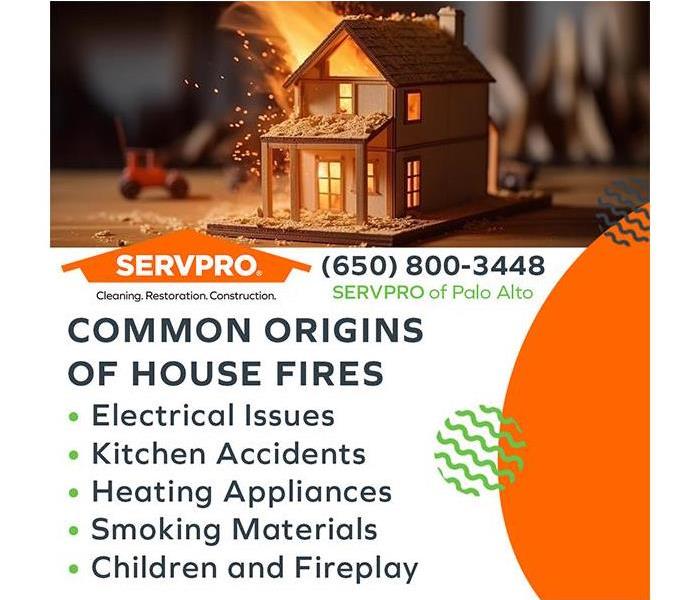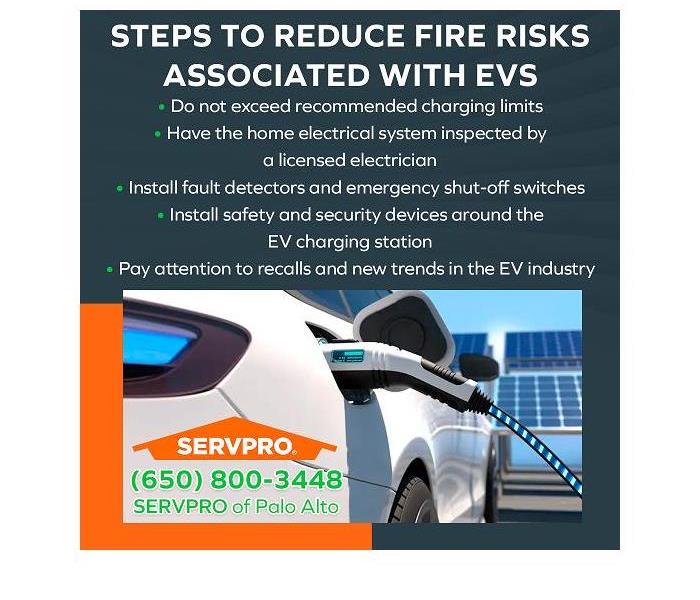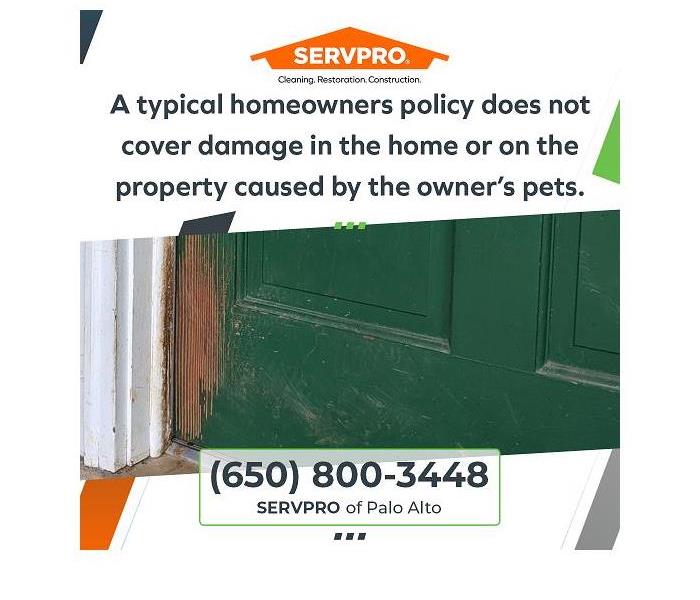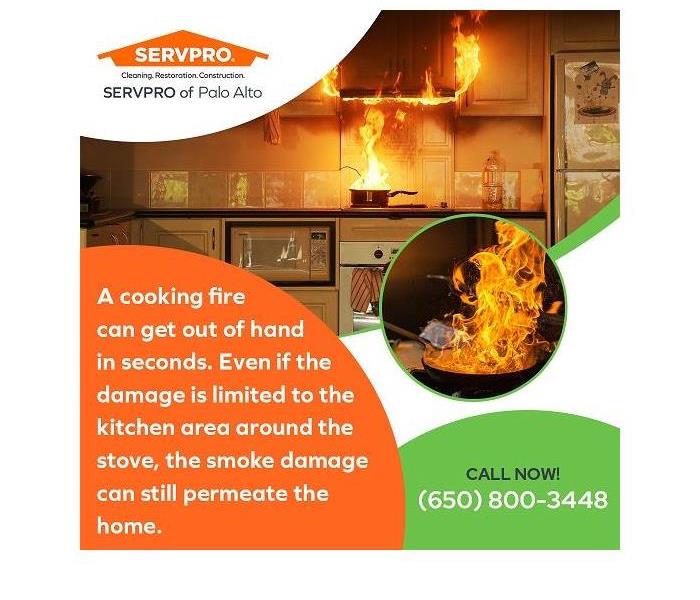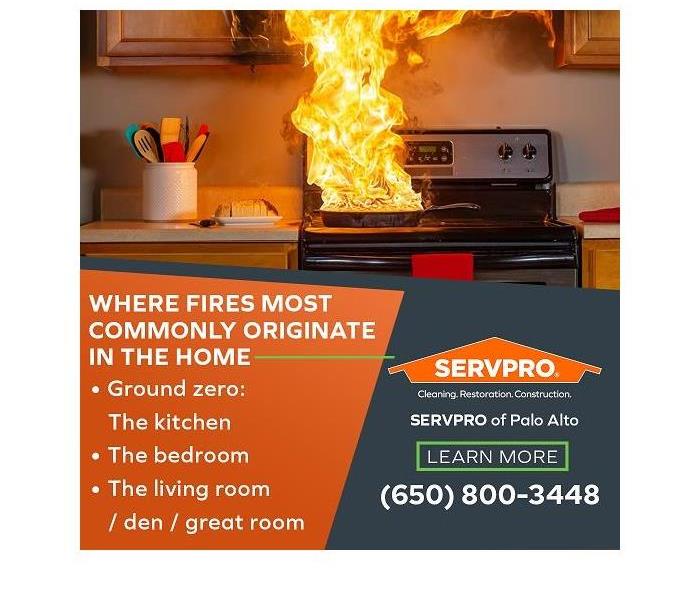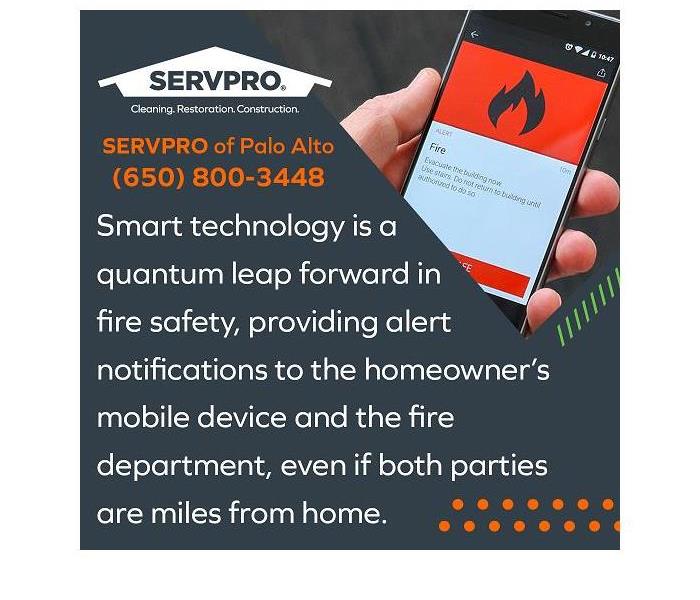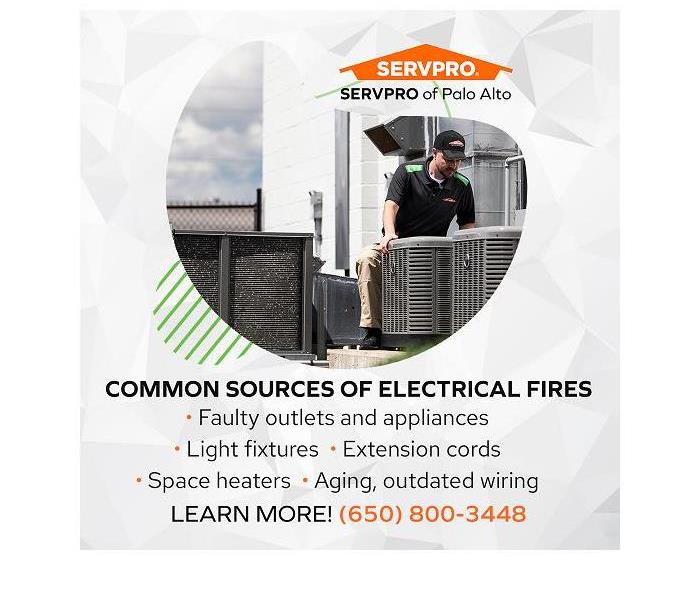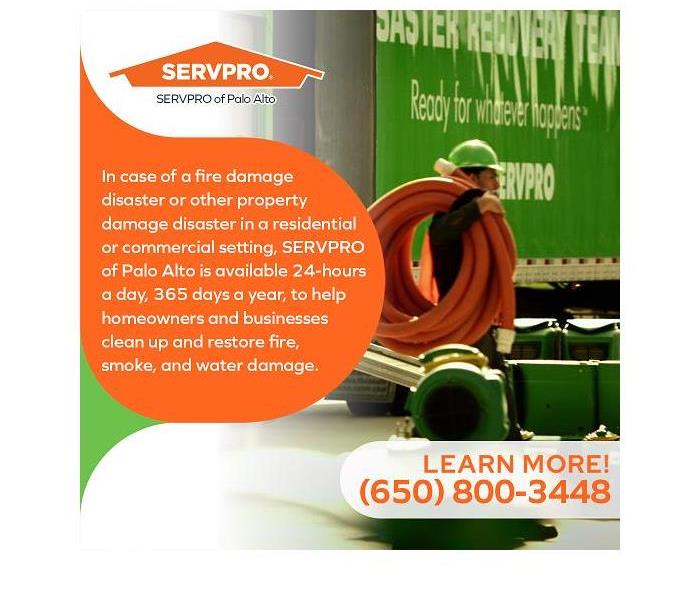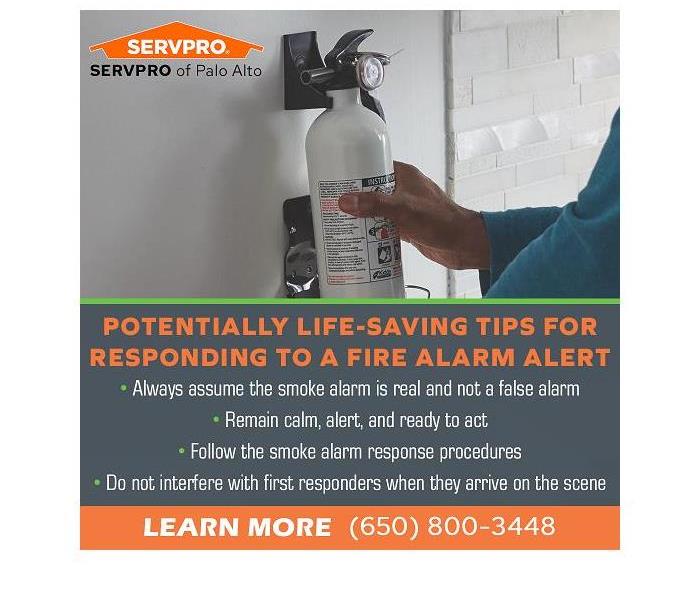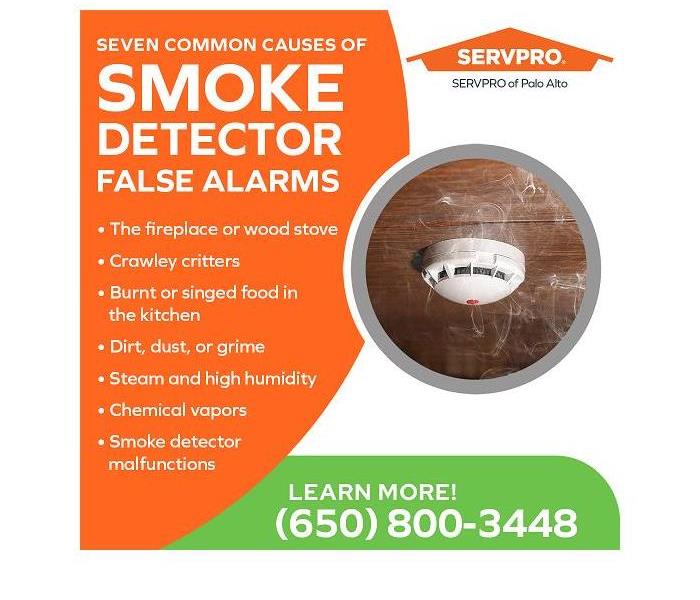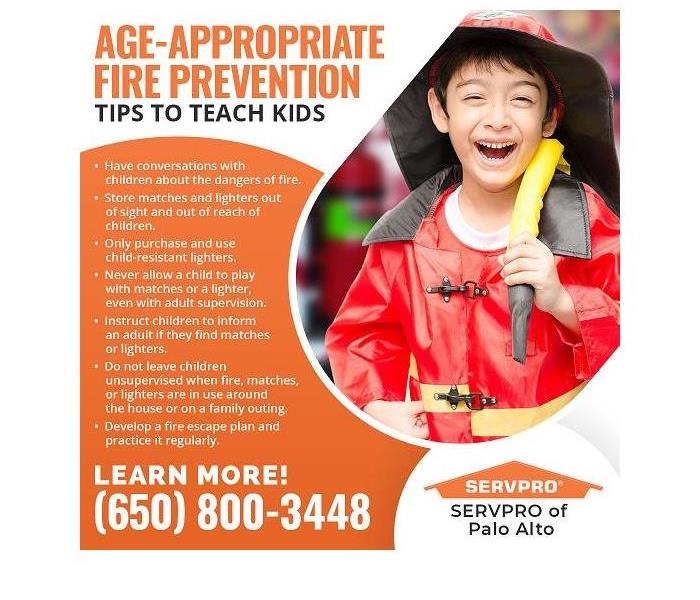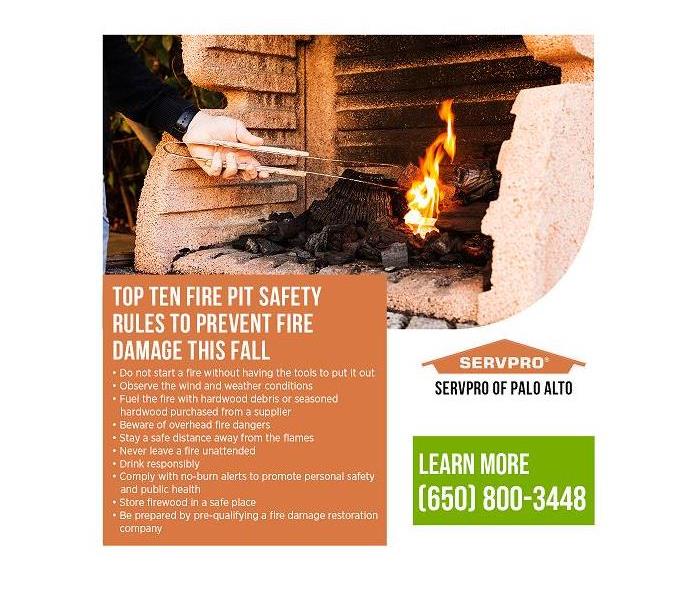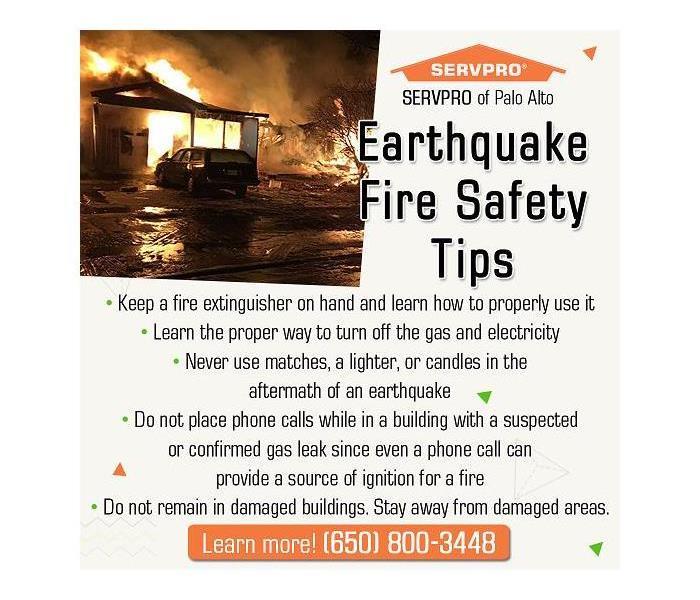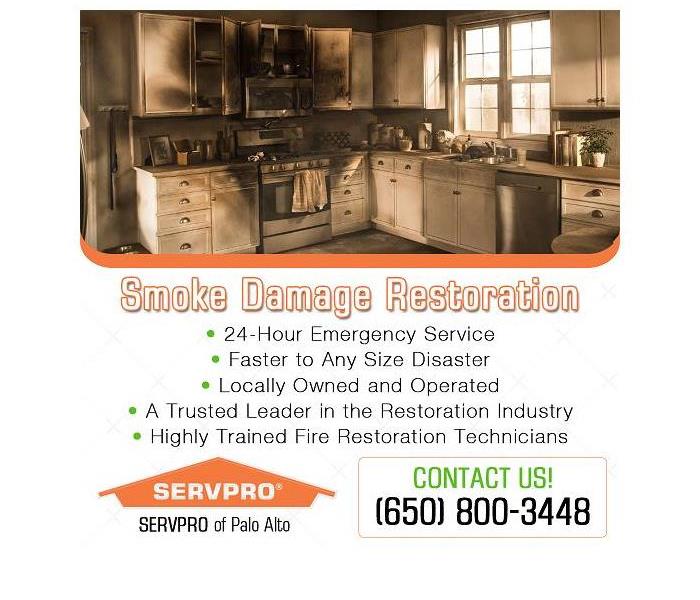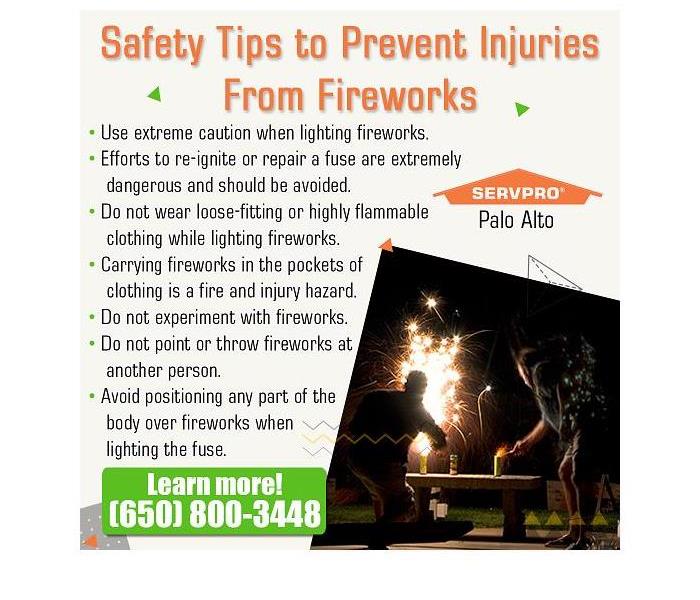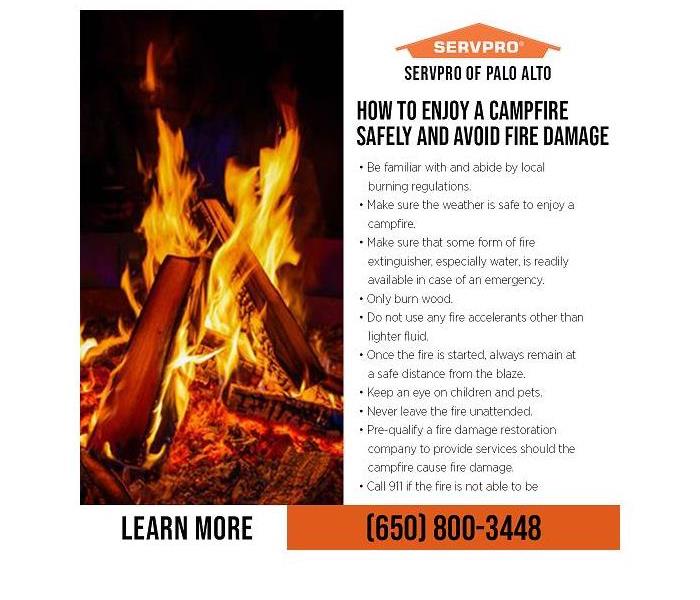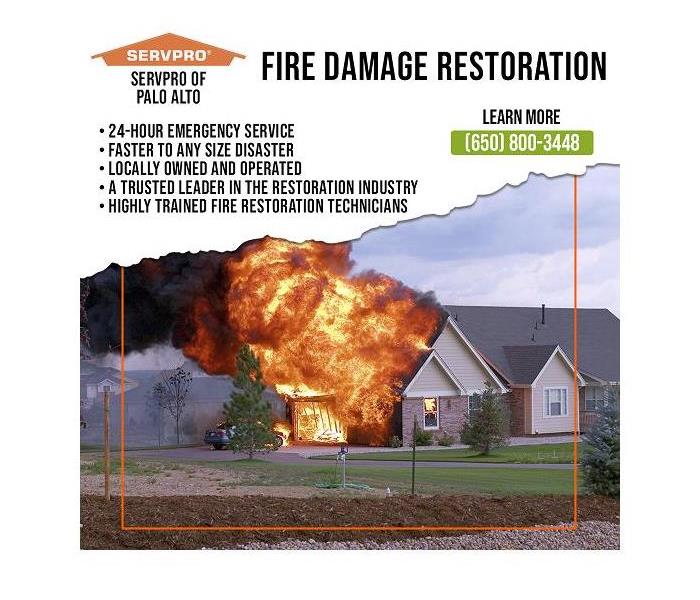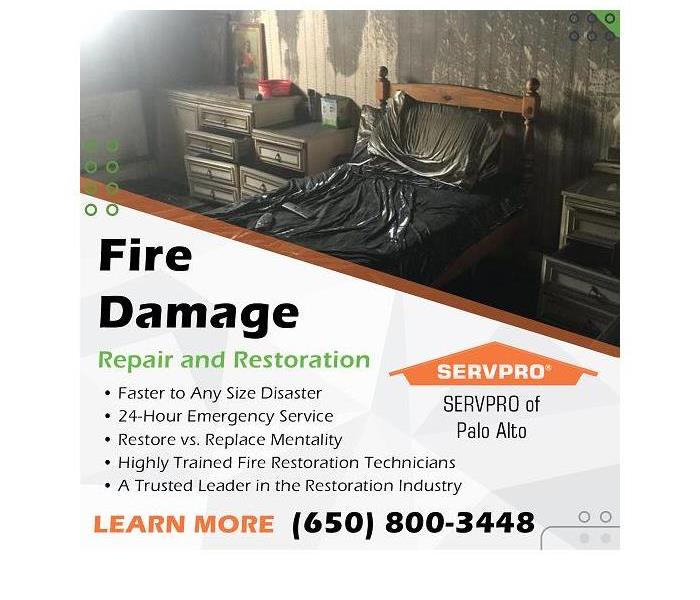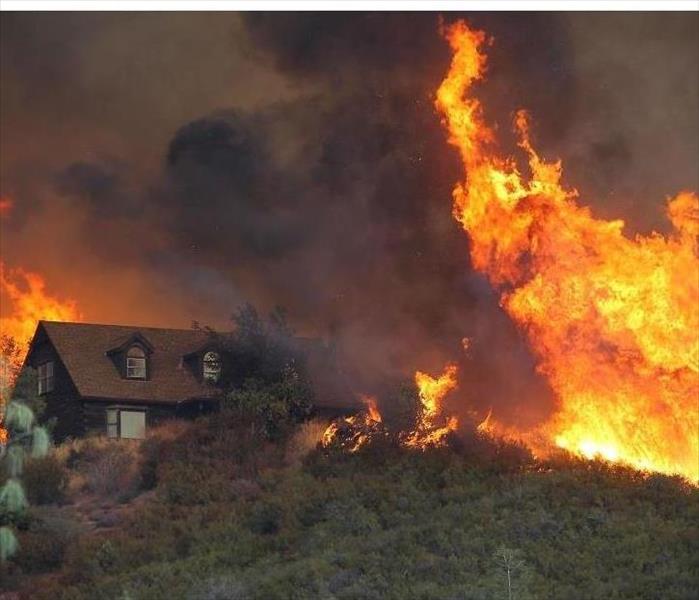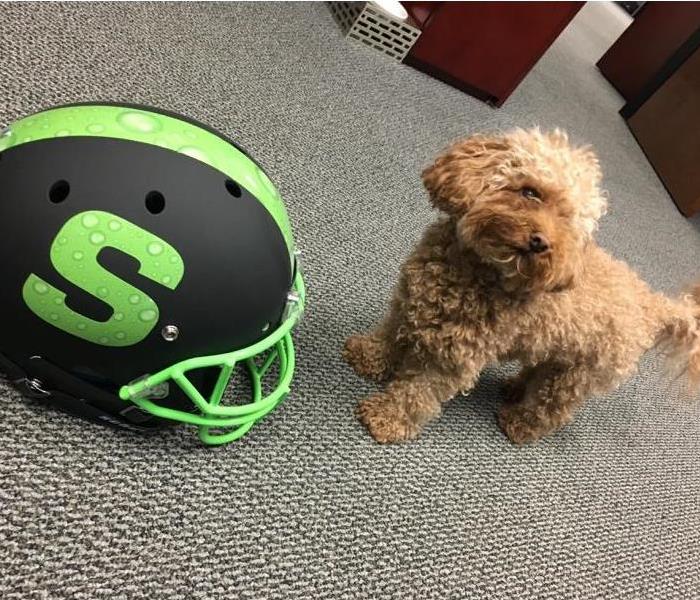Recent Fire Damage Posts
Complete soot and odor removal for homes and businesses
8/6/2024 (Permalink)
At SERVPRO of Palo Alto, we fully understand the profound impact of fire damage on homes and businesses. Our professional soot and odor removal services in Palo Alto offer comprehensive solutions for those dealing with the aftermath of a fire. We provide top-tier smoke removal services, ensuring thorough restoration to return your property to its pre-fire condition. In this article, we'll delve into the significance of proper soot cleanup, the hazards of soot exposure, and how our team at SERVPRO of Palo Alto can assist you in recovering from fire damage using our specialized techniques and equipment.
Key takeaways
- Prompt soot removal is crucial to mitigate long-term damage.
- Thorough inspection and specialized cleaning techniques are essential for effective soot removal.
- Advanced technology and certified technicians ensure comprehensive smoke and odor elimination.
- Personalized care and fast-track reconstruction minimize disruption during the restoration process.
- Rebuilding after fire damage requires attention to all affected areas, including ductwork and grout lines.
Why soot cleanup matters
We at SERVPRO of Palo Alto understand that soot cleanup is a critical component of fire damage restoration. Our professional soot and odor removal team in Palo Alto process ensures that every surface affected by soot and smoke is meticulously cleaned, mitigating long-term damage to your property. As soot and odor removal services professionals, we know that immediate action is essential to minimize the spread of soot particles and lingering smoke odors.
The importance of thorough soot cleanup cannot be overstated. Here's why it matters:
- Structural damage: Soot is acidic and can corrode metals, damage electrical wiring, and deteriorate structural materials over time, compromising the integrity of your home.
- Odor removal: Soot often carries strong, unpleasant odors that can permeate throughout the home. A thorough cleanup is essential to eliminate these persistent smells.
- Aesthetic restoration: Soot can stain walls, ceilings, and other surfaces, making a home look dirty and uninhabitable. Cleaning soot restores the aesthetic appeal of the property.
- Fire damage restoration: Proper soot cleanup is a crucial step in the overall fire damage restoration process, ensuring all remnants of the fire are effectively removed.
- Tackling further contamination: Soot particles can easily spread to unaffected areas of the home, causing additional damage. Immediate cleanup helps this spread at bay.
- Property value: A thorough soot cleanup helps maintain the property’s value by ensuring it is free of damage and contamination, making it more appealing to potential buyers or tenants.
How to recognize soot damage
Here are some tell-tale signs of soot damage that you can look for in your home:
- Visible stains and discoloration: Look for black or dark brown stains on walls, ceilings, and other surfaces. Soot often appears as a fine, powdery residue that can be easily smudged when touched.
- Persistent odors: A strong, lingering smell of smoke or burnt materials can indicate the presence of soot. Even if you can't see it, the odor can be a clear sign of soot contamination.
- Dust and residue: Check for unusual dust or fine black particles on surfaces, furniture, and air vents. This can be soot that has settled after the fire.
- Corroded metals: Inspect metal fixtures, appliances, and surfaces for signs of corrosion or rust. Soot is acidic and can cause metals to deteriorate over time.
- Electrical issues: If you notice malfunctioning or short-circuiting electrical devices, it could be due to soot infiltration. Soot can damage electrical wiring and components.
- Aesthetic changes: Soot can dull the appearance of surfaces, making them look dirty or aged. Pay attention to any areas that seem unusually dingy or grimy.
The extent of soot damage can vary depending on the type of fire and the materials burned. SERVPRO of Palo Alto assesses the severity of the damage and determines the most appropriate professional soot and odor removal methods for each affected area.
SERVPRO of Palo Alto’s team is equipped to handle professional soot and odor removal from delicate surfaces, electronics, and HVAC systems. By recognizing and addressing all forms of soot and odor removal in Palo Alto, we ensure a thorough restoration process that protects your property and belongings from further harm.
The soot removal process
SERVPRO of Palo Alto’s approach to soot removal is a systematic process designed to restore your property thoroughly. Our procedures address not only visible soot but also hidden residues and lingering smoke odors, ensuring that every trace of soot and smoke is removed. This will leave your home or business clean, fresh, and restored to its pre-fire condition.
Step one: fire damage inspection
- Visual examination: We perform a detailed visual inspection of all affected areas to identify visible damage.
- Surface testing: Our team tests surfaces for soot residue to determine the extent of contamination.
- Structural integrity: We evaluate the structural integrity of the property to ensure it is safe for the cleanup process.
- Salvage assessment: We assess personal belongings for salvageability, documenting items that can be restored.
- Safety hazards: Our technicians identify potential safety hazards, such as compromised electrical systems and hidden soot deposits.
- Damage documentation: We document all damages for insurance purposes to support your claims process.
- Restoration planning: We estimate the scope of required restoration work and determine the most effective cleaning methods for each affected surface.
- Hidden soot detection: We examine hidden areas where soot may have settled, such as inside cabinets, air ducts, and electrical systems.
Step two: general cleanup
- HEPA vacuums: We use specialized vacuums with HEPA filters to remove loose soot particles from surfaces, including furniture and upholstery, without spreading contamination.
- Dry cleaning sponges: Our team applies dry cleaning sponges to walls and ceilings to effectively lift soot without smearing.
- Cleaning solutions: We employ appropriate cleaning solutions and techniques for stubborn residues, always mindful of the specific material being treated.
- Surface protection: We ensure surfaces are protected during the cleaning process to avoid further damage.
- Mold prevention: Our team takes steps to mitigate secondary issues like mold growth by thoroughly drying and dehumidifying the affected areas.
Step three: soot cleanup
- Specialized cleaning agents: Our team applies specialized cleaning solutions tailored to each surface type, ensuring effective removal without causing damage.
- Dry cleaning methods: We utilize dry cleaning methods for delicate materials to avoid damage.
- Wet cleaning techniques: We use wet cleaning techniques for more resilient surfaces to ensure thorough removal of soot.
- Rinsing and drying: We thoroughly rinse and dry cleaned areas to mitigate water damage.
- Sealing and repainting: Our team assesses the need for repainting or refinishing, sealing soot-stained surfaces with a stain-blocking primer before applying fresh paint to restore the area fully.
Step four: odor removal
- Thermal fogging: We use thermal fogging techniques to mimic the way smoke penetrates surfaces during combustion, ensuring deep odor removal.
- Ozone treatments: Our team applies ozone treatments that break down odor-causing molecules at the source for thorough odor elimination.
- Porous material treatment: We pay special attention to porous materials like clothing and upholstery, which often retain stubborn odors.
- Advanced odor elimination: We utilize advanced odor elimination techniques to ensure all smoke and soot odors are completely removed.
- Inspection and assurance: We conduct a final inspection to ensure all odors have been effectively eliminated, leaving the property smelling fresh and clean.
Why choose SERVPRO of Palo Alto for soot & odor removal
Here are a few reasons why you should choose SERVPRO of Palo Alto for effective soot and odor removal:
Certified technicians
SERVPRO of Palo Alto employs certified technicians who are trained in smoke damage restoration and soot removal. Our team undergoes rigorous training to stay current with the latest techniques and technologies in fire damage restoration, ensuring we provide the highest quality service to our clients.
Our certified professionals understand the complexities of different fiber types and how they interact with soot and smoke particles. This knowledge allows us to tailor our approach for each unique situation, maximizing the effectiveness of our restoration efforts without relying on generic marketing claims.
Quality craftsmanship
We pride ourselves on delivering quality craftsmanship in every aspect of our soot and odor removal services. Our skilled technicians understand that each surface requires a unique approach, whether it's carpet cleaning, metal restoration, or floor refinishing. We never rely on generic solutions like bleach, which can cause more harm than good when dealing with soot damage.
Our attention to detail extends to even the smallest items, such as removing soot from candle holders or delicate decorative pieces. We carefully assess each item and space, employing specialized techniques and products to ensure thorough cleaning without compromising the integrity of your belongings or property.
Advanced technology & equipment
We employ advanced technology and equipment to ensure thorough soot and smoke odor removal, going beyond simple solutions like vinegar. Our state-of-the-art air filtration systems effectively clean the air in your space, removing harmful particles that could lead to disease or contamination. This comprehensive approach addresses both visible soot damage and invisible airborne contaminants.
Our specialized equipment includes thermal foggers and ozone generators, which penetrate deep into porous materials to neutralize smoke odors at their source. We also utilize advanced moisture detection tools to identify areas affected by water damage from firefighting efforts, ensuring we address all aspects of fire and soot damage restoration.
Rapid response
We understand that rapid response is crucial when dealing with soot and smoke damage, as prolonged exposure can lead to serious health issues. Our team is available 24/7, ready to deploy advanced filtration systems that remove harmful carbon particles and other contaminants from your home or business environment.
Our swift action extends to addressing soot buildup in fireplaces and other affected areas, mitigating the further spread of damaging residue. We utilize specialized cleaning agents, including citrus-based solutions, to effectively neutralize odors and remove stubborn soot stains, ensuring a thorough restoration of your property.
Fast-track reconstruction
We excel at fast-track reconstruction, combining our extensive knowledge of soot and smoke damage with efficient restoration techniques. Our thorough inspection process allows us to quickly identify areas requiring immediate attention, from microfiber furnishings to liquid-damaged surfaces. This approach enables us to prioritize tasks and streamline the reconstruction process, minimizing downtime for your home or business.
Our team's expertise in handling protein-based soot from kitchen fires sets us apart in fast-track reconstruction. We understand the unique challenges posed by different types of fire damage and tailor our restoration methods accordingly. This specialized knowledge allows us to address complex issues swiftly and effectively, ensuring a comprehensive restoration that goes beyond surface-level cleaning.
Contact SERVPRO of Palo Alto for all your soot & odor removal needs.
Complete soot and smoke odor elimination is crucial for restoring homes and businesses to a safe, healthy environment after fire damage. Our specialized techniques and advanced equipment address both visible soot damage and hidden smoke particles, mitigating long-term property deterioration. We tailor our approach to each unique situation, ensuring thorough cleaning of all surfaces, from delicate fabrics to sturdy structural elements, including often-overlooked areas like air ducts and grout lines. Our comprehensive fire damage restoration process not only eliminates all traces of soot and smoke odor but also provides peace of mind, allowing you to rebuild with confidence. Reach out to us today at zkareem@SERVPROpaloalto.com or call us at (650) 800-3448 to learn more.
Expert advice on smoke and soot odor removal
10/13/2023 (Permalink)
In the aftermath of a fire or even a minor smoke damage incident, the battle against lingering odors can be an arduous one. The scent of smoke and soot residues infiltrates every corner, clinging stubbornly to walls, furniture, and memories. However, amidst this challenge lies a science, a set of advanced techniques, and a team of dedicated professionals ready to restore your space to its former freshness.
Welcome to the comprehensive blog guide on "Expert Advice on Smoke and Soot Odor Removal" by SERVPRO® of Palo Alto. Here, we embark on a journey to unravel the complexities of smoke and soot odors, exploring why they persist and, most importantly, the methods and strategies to eliminate them. With a commitment to the Monta Loma community and beyond, we offer insights, case studies, and a step-by-step approach to guide you through this transformative process. Join us as we unveil the art of soot and smoke removal and embrace a future free from the haunting traces of smoke.
Understanding smoke and soot odors
The smoke and soot odors following a fire event can be more than an inconvenience; it's a persistent reminder of the damage. To effectively combat these odors, it's essential to understand their nature and the factors that contribute to their resilience.
The nature of smoke odors
Smoke odors, often described as pungent and acrid, result from the combustion of various materials during a fire. These odors comprise a complex mixture of volatile organic compounds (VOCs) and particulate matter. What makes smoke odors particularly challenging to eliminate is their ability to permeate and penetrate surfaces, often settling deep within porous materials like upholstery, curtains, and walls.
The microscopic particles from burning materials can infiltrate the smallest cracks and crevices, making their removal meticulous. Smoke odors can also be absorbed by porous materials, re-releasing odors when conditions are favorable. Understanding the science behind smoke odors is the first step in developing effective strategies for their removal.
The impact of soot residue
Surface staining: Soot particles, consisting of fine, black carbon, are notorious for leaving stubborn stains on surfaces. Walls, ceilings, and personal belongings can be marred by unsightly discoloration, requiring professional cleaning and restoration.
Odor amplification: Soot is a carrier for smoke odors, intensifying their persistence. Combining soot and smoke residue can create a potent, lingering smell that permeates your living space.
Respiratory health concerns: Inhalation of soot particles can pose health risks. Fine soot can enter the respiratory system, potentially aggravating pre-existing respiratory conditions and causing discomfort.
Corrosion of metals: Soot contains acidic components that can corrode metal surfaces and objects. This corrosion can weaken structures and cause permanent damage to valuable items.
Damage to electronics: Soot particles can infiltrate electronic devices, leading to short circuits and malfunctions. The impact of soot on electronic equipment can be costly and may require specialized cleaning and restoration.
Porous material absorption: Soot particles readily penetrate porous materials like upholstery, carpets, and drapes. Once absorbed, they can be challenging to remove, often necessitating professional cleaning services.
Health hazards: Soot exposure may pose health risks, particularly for respiratory patients. It can trigger or exacerbate conditions such as asthma and bronchitis.
Indoor air quality: Soot residues can significantly affect indoor air quality. Poor air quality can lead to discomfort and health issues for occupants, making thorough soot removal crucial for a healthy living environment.
Understanding the multifaceted impact of soot residue underscores the importance of professional smoke and soot odor removal services, which go beyond surface cleaning to ensure your property's restoration and peace of mind.
The importance of professional smoke and soot odor removal
Professional smoke and soot odor removal is not just about restoring the comfort and aesthetics of your living space; it's also about safeguarding your health and preserving property value. Lingering smoke and soot odors aren't merely unpleasant; they can pose health risks by exposing occupants to harmful particles and toxins. Furthermore, the longer these odors persist, the more they can permeate and damage building materials and possessions, potentially leading to costly replacements. Therefore, investing in expert odor removal services, like those provided by SERVPRO of Palo Alto, is a wise choice for ensuring your property's long-term well-being and financial value.
Preserving property value
Preventing material deterioration: Timely odor removal prevents the corrosive nature of smoke and soot from causing further damage to walls, ceilings, and furnishings, preserving their structural integrity.
Avoiding devaluation: Lingering smoke odors can negatively impact property value, making selling or renting a home more challenging.
Insurance benefits: Documenting and addressing smoke damage promptly can help maximize insurance claims, ensuring that your property's value is protected.
Enhanced curb appeal: A smoke-free and odor-free property is more appealing to potential buyers or renters, maintaining or even increasing its market value.
Mitigating secondary damage: Swift odor removal prevents the spread of odors to unaffected areas of the property, reducing the scope of potential damage and minimizing repair costs.
Ensuring a fresh start: Professional odor removal gives your property a fresh start, free from the lingering reminders of past fire incidents, making it more inviting to residents or buyers.
Reduced liability: Eliminating smoke odors reduces the risk of health issues for occupants, potentially minimizing liability concerns that can impact property value.
Smoke removal techniques and methods
Smoke odors can permeate a space, making their removal a multifaceted challenge. Professionals like SERVPRO of Palo Alto employ specialized techniques to eliminate these odors effectively. These include using ozone generators, thermal fogging, and air scrubbers, which target and neutralize smoke particles, even those hidden within hard-to-reach spaces. Additionally, professional cleaning agents and techniques are employed to cleanse surfaces of soot residues, preventing further odor generation. By combining these strategies, SERVPRO ensures a comprehensive and lasting solution for smoke odor removal.
Advanced smoke and soot detection
Thermal Imaging: Infrared thermal imaging cameras help identify hidden pockets of soot and smoke residues within walls and ceilings.
Particle Counters: Advanced particle counters are used to measure the concentration of smoke particles in the air, aiding in assessing the extent of contamination.
Gas Detectors: Sensitive gas detectors can identify volatile organic compounds (VOCs) emitted by smoke, aiding in pinpointing sources of odors.
Surface Swabs: Swabs are used to collect surface samples to detect and analyze the presence of soot particles, even on non-porous materials.
Ultraviolet (UV) Light: UV light sources reveal hidden soot stains on surfaces, guiding the cleaning process.
Air Quality Testing: Specialized air quality testing equipment monitors indoor air quality, providing real-time data on smoke particle levels.
Combustion Gas Analyzers: These devices assess the type and concentration of combustion gases, helping determine the severity of smoke damage.
Indoor Air Samplers: Air samplers collect air samples for laboratory analysis, aiding in identifying the presence of harmful smoke-related compounds.
Video Borescopes: Miniature cameras on flexible cables allow for visual inspection of hidden areas, such as air ducts and wall cavities, for soot and smoke residue.
These advanced detection methods empower SERVPRO of Palo Alto's team to identify and address the most elusive smoke and soot residues, ensuring a thorough and effective smoke odor removal process.
Comprehensive cleaning and deodorization
Comprehensive cleaning and deodorization are integral to the smoke and soot odor removal process. SERVPRO of Palo Alto employs a systematic and meticulous approach to effectively eradicate all traces of smoke residues and associated odors. Here's an in-depth look at the key elements of this critical phase:
- Assessment and pre-cleaning: The process begins with thoroughly assessing the affected area identifying the extent of smoke damage and the types of surfaces involved. Pre-cleaning involves removing loose soot and debris from surfaces using specialized tools and dry cleaning methods.
- Surface-specific cleaning: Different surfaces require tailored cleaning techniques. Non-porous surfaces may undergo wet cleaning using specialized detergents and techniques to effectively remove soot and smoke residues. Porous surfaces like textiles and upholstery may require dry cleaning or specialized cleaning agents to prevent further damage.
- HVAC and ductwork cleaning: Smoke particles can infiltrate HVAC systems and air ducts, spreading odors throughout a property. SERVPRO employs advanced techniques and equipment to clean and deodorize these systems, ensuring that recirculated air is free from smoke odors.
- Content cleaning: Personal belongings, furniture, and decor items can absorb smoke odors. SERVPRO's experts carefully assess each item, determining whether it can be restored or should be replaced. Cleaning methods range from dry cleaning to ultrasonic cleaning, depending on the nature of the item.
- Deodorization techniques: Deodorization goes beyond surface cleaning and addresses the source of odors. SERVPRO utilizes various advanced deodorization methods, including ozone generators, thermal fogging, and activated carbon filters, to effectively neutralize and eliminate odorous molecules.
- Sealing surfaces: In cases of severe smoke damage, sealing surfaces may be necessary to encapsulate any remaining odors. Specialized sealants are applied to walls, ceilings, and other surfaces to prevent odors from escaping and recontaminating the space.
- Monitoring and verification: Throughout the cleaning and deodorization process, SERVPRO monitors progress to ensure that odors are successfully eradicated. Verification procedures, such as air quality testing and odor assessment, are conducted to confirm that the space is odor-free.
- Final inspection: Before completing the project, SERVPRO conducts a final inspection to ensure that all comprehensive cleaning and deodorization aspects have been successfully executed. This thorough review provides peace of mind to homeowners, confirming that their property is restored to its pre-fire condition.
The combination of advanced cleaning techniques, specialized deodorization methods, and rigorous quality control measures ensures that SERVPRO of Palo Alto delivers comprehensive cleaning and deodorization services that leave no room for lingering smoke and soot odors. This meticulous approach is a testament to their commitment to restoring spaces to their freshest and most comfortable state.
The SERVPRO approach to smoke and soot odor removal
SERVPRO of Palo Alto takes a systematic and client-centered approach to smoke and soot odor removal, combining cutting-edge techniques with a commitment to delivering outstanding results. Here's a closer look at how SERVPRO tackles this crucial task:
Swift response and assessment
The cornerstone of SERVPRO of Palo Alto's success in smoke and soot odor removal is their swift response and initial assessment process:
- Rapid mobilization: SERVPRO's team mobilizes quickly to reach the affected property upon receiving a call. This prompt response is critical in preventing further damage and beginning the restoration process promptly.
- Initial assessment: SERVPRO technicians conduct a meticulous initial assessment upon arrival. They identify the source and extent of smoke and soot damage, including areas of hidden contamination. This assessment informs the development of a customized odor removal plan.
- Safety first: Safety is paramount. SERVPRO ensures that the property is safe to enter and that all necessary safety precautions are in place. This includes addressing any structural concerns or hazards that may exist.
- Containment: To prevent cross-contamination, SERVPRO employs containment measures. This includes sealing off affected areas and creating negative air pressure zones to control airflow and prevent odors from spreading.
- Removal of debris: Loose soot and debris are removed from surfaces to prevent them from further spreading or settling. Specialized cleaning techniques and tools tackle different surfaces, from walls and ceilings to furniture and textiles.
- Odor neutralization: SERVPRO utilizes advanced odor neutralization techniques and equipment, such as ozone generators and thermal fogging, to effectively eliminate odors at their source.
- Continuous monitoring: Throughout the odor removal process, SERVPRO monitors progress closely, making adjustments as needed to ensure that all odors are effectively eradicated.
- Final inspection: Upon completing the odor removal process, SERVPRO conducts a final inspection to ensure the property is free from smoke and soot odors. This thorough review ensures that clients can confidently return to their restored, odor-free space.
- Transparent communication: SERVPRO believes in clear and transparent communication with clients throughout the process. Clients are informed about the progress and necessary steps to achieve successful odor removal.
The SERVPRO approach to smoke and soot odor removal is defined by precision, expertise, and a commitment to delivering spaces that are not only clean but also completely free from lingering odors. This dedication ensures that homeowners and businesses can regain the comfort and freshness of their spaces, even in the aftermath of a smoke-related incident.
Tailored odor removal plans
SERVPRO of Palo Alto's approach to smoke and soot odor removal stands out for its meticulous attention to detail and commitment to customization. It all begins with a comprehensive initial assessment. Highly trained technicians thoroughly examine the affected areas, materials involved, and the extent of odor penetration. This assessment is the foundation for the tailored odor removal plan.
Identification of the sources of odor is a critical first step. SERVPRO's experts carefully trace the path of smoke and soot to pinpoint the primary odor sources, including any hidden contamination. Furthermore, they analyze the types of surfaces affected, distinguishing between porous and non-porous materials. This distinction is crucial as it informs the selection of the most appropriate cleaning agents and methods for each surface.
To prevent cross-contamination and ensure precise odor removal, SERVPRO implements containment strategies. These may involve sealing off affected areas, creating negative air pressure zones, and using specialized barrier technologies.
Deodorization techniques and equipment are then selected to match the unique odor challenges of the property. SERVPRO boasts an array of advanced options, from ozone generators to thermal fogging and activated carbon filters.
Throughout the process, SERVPRO remains adaptable, monitoring progress and making necessary adjustments to address unexpected challenges. Once the tailored plan is executed, verification procedures, including air quality testing and odor assessment, are conducted to confirm the property is completely odor-free.
This meticulous and adaptable approach, coupled with transparent communication, ensures that SERVPRO delivers spaces that are not only clean but also entirely free from lingering traces of smoke and soot odors.
Smoke reduction strategies for Monta Loma residents
Living in Monta Loma, a community that values safety and well-being, requires a proactive approach to smoke reduction. Whether you've experienced a nearby wildfire or wish to safeguard your home from smoke damage, the following strategies can help:
Preventing smoke damage
Preventing smoke damage begins with education and preparedness. Here's how Monta Loma residents can take proactive steps:
- Fire safety education: Educate your family about the dangers of fire and the importance of fire safety. Have a family escape plan in place and practice fire drills regularly.
- Safe cooking practices: Cooking accidents commonly cause house fires. Always attend to cooking and use caution with open flames.
- Smoking safety: If you smoke, do so in designated areas away from the home and dispose of cigarette butts safely. Never smoke in bed or near flammable materials.
- Electrical maintenance: Regularly inspect your home's electrical system for signs of wear and tear. Overloaded circuits can cause electrical fires and subsequent smoke damage.
- Heating safety: Properly maintain heating equipment, such as furnaces and space heaters. Keep flammable materials away from heating sources, and use screens for fireplaces.
- Fire-resistant building materials: When renovating or building, consider using fire-resistant building materials to reduce the risk of smoke damage.
- Evacuation planning: Have a well-thought-out evacuation plan in wildfire-prone areas. Know the escape routes, emergency contacts, and what to take.
By implementing these smoke reduction and prevention strategies, Monta Loma residents can significantly reduce the risk of smoke damage to their homes and enhance the safety and resilience of their community.
Immediate actions after a fire
Immediate actions after a fire are crucial for ensuring safety, minimizing damage, and facilitating the recovery process. Here are ten essential steps to take:
Ensure safety: First and foremost, prioritize safety. Ensure that all occupants, including pets, are accounted for and out of harm's way. Evacuate the premises if necessary.
Contact emergency services: Call 911 to report the fire and request immediate assistance. Firefighters will ensure the fire is completely extinguished.
Stay out of the property: After a fire, avoid re-entering the property until it has been deemed safe by firefighters or relevant authorities. Structural damage and hidden dangers may be present.
Notify the insurance company: Contact your insurance company to report the fire and initiate the claims process. Be prepared to provide details and photos if possible.
Document the damage: Take photographs and videos of the fire damage for insurance purposes. Document the extent of damage to both the structure and personal belongings.
Secure the property: If it's safe, secure it to prevent further damage or unauthorized access. This may include boarding up windows and doors.
Limit movement: Minimize movement within the property to prevent soot and ash from spreading and embedding further into surfaces, which can exacerbate damage.
Avoid touching belongings: Refrain from handling or moving damaged items unless necessary for safety reasons. Avoid contaminating unaffected areas with soot or smoke residue.
Contact restoration professionals: Reach out to a reputable fire damage repair company like SERVPRO of Palo Alto to assess the damage and begin the restoration process promptly.
Inform loved ones: Notify friends and family of the situation and your whereabouts, especially if you've had to evacuate. Communication is essential during such emergencies.
Taking these immediate actions after a fire ensures the safety of all occupants, helps initiate the recovery process, and maximizes the chances of a successful restoration and insurance claim.
Comprehensive smoke damage restoration services
Comprehensive smoke removal services go beyond merely addressing the visible signs of damage; they encompass a thorough and meticulous process to return a property to its pre-fire condition. SERVPRO of Palo Alto understands that smoke damage is not limited to what meets the eye; it involves hidden residues, lingering odors, and potential health hazards. Here's a closer look at what these services entail:
- In-depth assessment: The restoration process begins with a comprehensive assessment by trained technicians. They identify the types of smoke residues, the affected surfaces, and the extent of contamination. This assessment informs the restoration plan.
- Surface-Specific cleaning: Different surfaces require specific cleaning methods to remove soot and smoke residues effectively. SERVPRO's experts tailor their approach to ensure that each porous or non-porous material is cleaned and restored appropriately.
- Content cleaning: Smoke damage doesn't spare personal belongings. SERVPRO employs advanced techniques such as ultrasonic cleaning and specialized cleaning agents to restore damaged items, from furniture to clothing.
- HVAC and ductwork cleaning: Smoke particles can infiltrate heating, ventilation, and air conditioning (HVAC) systems. Cleaning and deodorizing these systems are essential to prevent the recontamination of indoor air.
- Structural repairs: Smoke damage can weaken structures. SERVPRO addresses structural issues, from damaged walls and ceilings to compromised support systems, ensuring the property's integrity.
- Odor elimination: Lingering smoke odors are a common challenge. SERVPRO utilizes advanced deodorization methods, including ozone generators, thermal fogging, and activated carbon filters, to neutralize odors effectively.
- Ventilation: Proper ventilation is crucial to remove remaining odors and restore the property's indoor air quality to a safe and healthy level.
- Sealing surfaces: Sealing surfaces may be necessary to encapsulate any remaining odors in severe cases. Specialized sealants are applied to prevent odors from escaping and recontaminating the space.
- Monitoring and verification: SERVPRO monitors progress closely throughout the restoration process. Verification procedures, such as air quality testing and odor assessment, are conducted to confirm that the property is odor-free and safe.
- Final inspection: Before completion, SERVPRO conducts a final inspection to ensure that all aspects of comprehensive smoke damage restoration have been successfully executed. This ensures that the property is clean and entirely free from the lingering traces of smoke-related incidents.
Comprehensive smoke damage restoration services by SERVPRO of Palo Alto are founded on precision, expertise, and a commitment to delivering spaces that are not only clean but also entirely free from lingering smoke and soot damage.
About SERVPRO of Palo Alto
SERVPRO of Palo Alto is your trusted partner in disaster restoration, serving the Palo Alto community with excellence and unwavering dedication. With a commitment to restoring both residential and commercial properties from fire, water, mold, and storm damage, our experienced team delivers top-notch service that goes beyond expectations.
Our rapid response and 24/7 availability ensure that we're there when you need us most, providing immediate assistance during challenging times. We utilize state-of-the-art equipment, advanced techniques, and a highly trained workforce to ensure swift and efficient restoration.
At SERVPRO of Palo Alto, we understand the importance of restoring your property and peace of mind. Our mission is to help homeowners and businesses recover, offering valuable support during moments of crisis. Contact us today at (650) 800-3448, and let SERVPRO of Palo Alto be your savior in fire damage restoration in Monta Loma.
What are the fire damage risks from EV home recharging stations?
3/16/2023 (Permalink)
Blog Summary: SERVPRO of Palo Alto offers tips on how to decrease the risk of house fires caused by the charging of electric vehicles.
SERVPRO® of Palo Alto is a leader in providing fire damage, smoke, damage, and water damage restoration services to Palo Alto and Bay area residents and businesses.
The risk of fire from charging an EV
The number of electric vehicles (EVs) is growing. The US EV market in the United States topped 6.7% by mid-summer 2022. In 2019, EVs made up just under 2% of vehicles on the road. Of the nearly 1.45 million EVs registered in the US, California boasts over 563,000 units, a 38.7% share of the EV fleet in the United States.
As with the growth of any new industry, challenges arise. Some EV owners are anxious that their EVs may create a significant fire hazard while charging at home. These fears are not groundless. Over the past few years, several major carmakers have issued recalls for some of their EVs due to fire risks.
Jane Marsh, a specialist in climate policy, sustainability, and renewable energy, comments on the house fire risks from EV charging: “While EVs may not have tanks full of combustible liquid like conventional cars, their batteries pose fire hazards. The lithium-ion batteries that power these vehicles have a high energy density and use flammable components. As a result, if something goes wrong, they could catch fire quickly and burn extremely hot. These hazards are a concern in all lithium-ion battery products, not just EVs. The Consumer Product Safety Commission reported more than 25,000 overheating and fire incidents from 400 types of products using these batteries over a five-year period.”
Marsh elaborates on the specific housefire risks of charging EVs at home, stating, “Charging EVs at home, especially overnight, past their full capacity could cause overheating, leading to fires. Battery damage or electrical issues could heighten these risks. As automakers like GM aim to eliminate gas vehicle sales by 2035 and EV adoption grows, this fire hazard becomes more concerning.”
Are fires from EVs a frequent occurrence?
Incidents of EVs catching fire are not a common occurrence. In fact, EV fires are rare. Research indicates that EVs experience approximately two dozen fires for every 100,000 vehicles, while traditional fossil-fuel-based vehicles account for 1,500 fires. Manufacturer recalls of gasoline-powered cars for fire hazards significantly outnumber recalls of EVs for the same reason.
The probability of an EV causing a fire while charging at home is very low compared to home appliances such as electric stoves. Cooking accounts for roughly 474 home structure fires each day. Electric stovetops far outnumber EVs, but housefires caused by EVs are relatively lower by comparison.
Although rare, a house fire from charging an EV is still difficult to extinguish. With the increase in the number of EVs comes a greater likelihood of more fires. The practical steps listed below will reduce fire risks associated with EVs.
Step #1: Do not exceed recommended charging limits
Overcharging an EV’s battery is one of the leading causes of fire. Charging the battery to less than 100% will ensure the battery does not overheat. Fire experts advise EV owners to avoid charging their EVs overnight. If an EV needs repair, do not park it in the garage. Instead, park the car a safe distance from the house until the problems are diagnosed, and the repairs are completed.
Step #2: Have the home electrical system inspected by a licensed electrician familiar with adapting the home wiring system to accommodate an EV charger
Homeowners should have an electrician inspect their wiring before installing EV chargers to ensure they can handle the high voltages necessary to charge the vehicle. Older homes and damaged systems may be unable to charge EVs safely.
Step #3: Install fault detectors and emergency shut-off switches in electrical systems
Keep all equipment in optimal operating condition. Low fire risk, peace of mind, and uninterrupted service are the benefits of proper maintenance.
Step #4: Install safety and security devices around the EV charging station
A smoke detector can sound the alarm in case a fire occurs when the EV is charging. Keep an appropriate fire extinguisher handy in case a fire incident occurs. Never spray water on a burning EV. Immediately contact fire first responders. Keep a safe distance from the EV. Lithium-ion batteries generate intense heat and toxic fumes.
Install a discrete remote video camera for both personal safety and security purposes. The camera will allow real-time viewing of a fire incident from beginning to end, and this information could help determine the cause and nature of the fire.
Step #5: Pay attention to recalls and new trends in the EV industry
EVs and battery technology are in their infancy. As bugs are discovered and resolved, the EV owner must stay informed about new issues and new advances in relevant technology.
What to do if an EV charging fire breaks out
Once the smoke or flames are discovered, follow all safety precautions and fire suppression procedures recommended by the manufacturer. If possible, shut off the power to the charging station. Call 911.
If fire damage, smoke damage, and water damage cleanup and restoration are needed, call the trained, IICRC-certified professionals at SERVPRO of Palo Alto for assistance. The team is trained to safely clean up and restore any hazardous fire and smoke damage disaster. Crews are available 24/7, 365 days a year, including holidays.
For more information about water damage restoration in and around Linda Vista Park, Cupertino, CA, and the surrounding area, email SERVPRO of Palo Alto at office@SERVPROpaloalto.com or call (650) 800-3448.
Answering the homeowner’s questions about dealing with property damage caused by pets
2/14/2023 (Permalink)
Blog Summary: SERVPRO of Palo Alto provides water damage restoration and fire damage restoration services to homes in the Cupertino, CA, area.
SERVPRO® of Palo Alto provides fire and water damage restoration for property damage to homes in the Palo Alto area, including property damage caused by pets in the house. Pets, especially dogs, are popular in Palo Alto and the surrounding Bay area. A recent estimate in 2018 suggested that there were between 120,000 and 150,000 dogs in San Francisco. Immediately, the question arises: “What if my pet causes a fire damage or water damage disaster in my home?” Before answering the question, take a look at how pets of all kinds can cause a property damage disaster in a home or apartment. An awareness of how vulnerable a structure is when the dog (or cat) is home alone will make the homeowner think twice about leaving a pet unsupervised, even if the pet owner is at home.
Dogs and cats, the most popular domestic pets, can be curious. Dogs can cause the most damage, especially if the dog is large. Here are some innovative ways the family pet can cause havoc in the home or property by just being what they are: the family pet.
- Pets can cause a fire in the kitchen by causing items cooking on the stove to spill and ignite on the burners. A dog’s sense of smell is much more sensitive than a human’s. If the kitchen is outside and a grill is in use, do not be surprised to find a host of dogs (or cats) lurking around for a handout from the chef or for a full meal when the chef steps inside for just a moment. If a fire breaks out and damages the deck, siding, and awning, will insurance pay for damages?
- Pets can chew through electrical cords, which can cause an electrical fire and deliver a shock to the dog, cat, ferret, or pet rat. Both tame and wild, mice and rats love to chew electrical wires. Skunks, squirrels, chipmunks, raccoons, and other critters that make their way into the attic will chew on just about anything, including electrical wiring, which can result in an electrical fire.
- Pets can pull over light fixtures, the television or computer screen, and Christmas decorations, including Christmas lights.
- Pets can chew through plumbing, such as toilet tank supply lines and faucet supply lines.
- Make sure the water cooler is stable and securely attached to the wall with braces. A large dog can easily topple a free-standing water cooler. Twenty to thirty gallons of water can cover many square feet in the kitchen, den, and laundry room.
- Beware of leaving lighted candles in reach of pets (and children) to prevent a curious pet from overturning the burning candle and causing a fire.
- The irrigation and landscape lighting systems are not safe when the family dog is bored, hungry, thirsty, frightened by the sprinklers, or irritated when the lighting system begins to turn on at sunset.
Pets will lick, sniff, chew, push, pull, shake, shred, jostle, topple, or damage all manner of items, most likely when their owners are away from home.
Pet-caused disasters are often complex disaster scenes
If a dog or other pet causes a fire damage disaster, severe smoke damage will also likely occur. If the residence or apartment is outfitted with a fire sprinkler system, the water damage may be throughout the entire structure. If the fire department responds and rolls out the hoses, each hose can spray several hundred gallons of water per minute into the burning structure. Flowing at just over 70 mph, the force of the blast of water can cause severe damage to a home or business.
Does insurance coverage include property damage caused by pets?
These guidelines are subject to the terms of an individual’s policy. For clarity, consult with an insurance agent.
- A typical homeowners policy does not cover damage in the home or the property caused by the owner’s pets. Under the policy, the homeowner’s pet is considered to be under the control of the homeowner, and responsibility for damages rests with the owner of the pet.
- If the policy owner’s pet damages someone else’s property, the policy may cover those damages. The other person may sue for damages.
Case study: Fish tank water damage disaster
A large fish tank provides a delightful distraction for patients waiting to be seen by a doctor, dentist, or other health care provider. Smaller versions can be found in many homes in Palo Alto and the Bay area. A tropical fish tank can cost thousands of dollars to build and populate with fish. What if something catastrophic happens, such as an earthquake that sends the aquarium crashing to the floor in a wave of water, broken glass, and flopping fish?
Insurance industry experts offer the following helpful guidelines: “Water damage is typically covered by homeowners insurance policies, as long as it wasn’t the result of your own negligence. Most standard policies list water damage as what’s called a covered peril. That means there’s a good chance your insurer would reimburse you for the damage caused by a broken fish tank. Under a standard policy, the tank itself is covered if it was destroyed by one of the covered perils listed in a homeowners policy, such as fire.”
When disaster strikes, turn to the team of IICRC-certified professionals at SERVPRO of Palo Alto for fire damage, smoke damage, and water damage cleanup and restoration. Crews arrive at the damaged property in about an hour, 24/7, 365 days a year, including holidays. The rapid response and quick cleanup process help get life back to normal as soon as possible.
For more information about water damage restoration services in North Whisman, Mountain View, CA, and nearby areas, contact SERVPRO of Palo Alto by phone at (650) 800-3448 or email at office@SERVPROpaloalto.com.
Fires and fire damage: Answering eleven frequently asked questions
1/25/2023 (Permalink)
Blog Summary: SERVPRO® of Palo Alto answers the common questions that Cupertino, CA, homeowners are asking about fire and fire damage.
The fire damage and water damage restoration experts at SERVPRO of Palo Alto are answering frequently asked questions about house fires and fire damage. Ignorance about the common causes of house fires puts the occupants of a home at great risk. A cooking fire on the stove can erupt into a full-fledged blaze that has the potential to engulf the entire structure in a couple of minutes or less. A healthy realization of how fast a fire can spread can save lives. When people realize they have little time to gather belongings and even less time to escape with their lives, no time will be wasted in evacuating the structure and ensuring everyone is not only out of the home but also at a safe distance. Here are some common questions frequently asked about house fires and fire damage.
How significant of a problem are home fires in the United States?
House fires pose a significant safety hazard in the US. According to recent statistics from the Red Cross, teams from the organization responded to nearly 75,000 disasters around the US. More than nine out of ten (93%) were related to a fire event. The tragedy is that many of these fire-related disasters could have been prevented.
Do home fires seem to be on the increase?
Regrettably, the answer to this FAQ is yes. Across the country, residential fires have seen an uptick of 8% in recent years. The typical cost to clean up and restore a fire-damaged home is approaching $20,000. The Red Cross disaster response rate has increased by at least 10% over the last two decades.
Are house fires more frequent during certain times of the year?
No time of the year is totally immune to fire risks. The fall and winter experience a greater frequency of house fires. Understandably, December and January are peak months for house fires. The weekends see an increase in fire outbreaks, with a peak between 6:00 pm and 7:00 pm.
Where in the home do most fires have their origin?
The kitchen is the “hot spot” where most house fires originate, followed by wherever the wood stove or fireplace is located. The majority of house fire fatalities result from fires caused by smoking.
Who is at the greatest risk of dying in a house fire?
When a house fire erupts, the most vulnerable occupants in the home are adults over 65 and children under five.
What is the best way to prepare for a potential house fire?
Once a fire erupts, occupants have a window of about two minutes to escape the blaze safely. The key to survival is an early warning with smoke detectors. Delayed notification significantly reduces the time window for a safe escape. Install high-quality smoke detectors outside each bedroom and on each level of the home or apartment. The best safety practice is installing smoke alarms in the bedrooms if someone decides to sleep with the door closed.
Are smoke detectors enough to keep everyone safe?
Faulty smoke alarms are worthless. Test the devices at least once a month to ensure they are working. Change the batteries at least once a year. For optimal safety, replace smoke detectors every ten years.
Is a fire extinguisher complicated to operate?
While fire extinguishers require some training and practice to be effective, the device can buy precious time to escape a house fire safely. Proper training can be obtained from a local fire department.
Should multi-story dwellings have escape ladders?
A fire escape ladder can save lives when a fire suddenly erupts, cuts off avenues of escape, and leaves little or no time to evacuate the home. The escape ladder is worth the risk when all avenues of escape are blocked except a window.
Can a homeowner create an effective fire escape plan?
The typical homeowner is capable of formulating a lifesaving fire escape plan.
Step #1: Designate two avenues of escape from every room.
Step #2: Store escape ladders near each window where the distance to the ground requires the assistance of an escape ladder.
Step #3: Assign a meeting place that is a safe distance from the home.
Step #4: Explain the plan and solicit helpful feedback—follow-up instruction with actual drills.
Never re-enter a burning home. The smoke and flames can overwhelm a person in seconds.
Is it possible to pre-qualify a damage restoration company before a fire, smoke, or water damage disaster has occurred?
The best time to reach out to a fire and water damage restoration company is before disaster strikes. SERVPRO strongly recommends homeowners and businesses begin this relationship before fire and smoke billow out of the roof and windows. The team of experienced, IICRC-certified technicians responds 24/7, 365 days a year, including holidays, with a response time of about an hour or so. A specially trained technician will prepare a detailed, well-documented estimate with images and video. SERVPRO of Palo Alto can handle the insurance claims process from beginning to end. The rapid response and quick cleanup get life back to normal as soon as possible.
To learn more about Apple Park, Cupertino, CA, water damage restoration services, email SERVPRO of Palo Alto at office@SERVPROpaloalto.com or call (650) 800-3448.
Seven tips for a safe holiday cooking experience untouched by fire damage
1/2/2023 (Permalink)
Blog Summary: SERVPRO® of Palo Alto warns Redwood City, CA, homeowners about the increased potential for fire damage in the kitchen during the holiday season.
The team at SERVPRO of Palo Alto wants everyone to have a happy and safe holiday season, free from seasonal hazards and restoration of a fire-damaged home. Knowing that people will be cooking and entertaining during the season, SERVPRO of Palo Alto offers these tips on how to stay safe in the kitchen.
The holiday season is hectic, running here and there, buying presents, racing to holiday parties, and preparing food for family gatherings and the big games. One place to slow down, pay attention, and take precautions is in the kitchen. One of the leading causes of house fires and personal injury is unattended dishes cooking on the stove. A phone call, a text that needs an immediate response, a crying child, a pet who needs attention, guests at the door, or other interruptions and distractions can make safe cooking very difficult. A ruined meal, burn or scald injuries, or even a full-blown cooking fire can result if the cook fails to juggle everything in the kitchen and the home successfully.
The holidays see a spike in home cooking fires. Amid the festivities and celebrations, families need to take the time to create a fire safety plan or review their existing fire safety plan. Two essential components of a simple fire safety plan are evacuation routes and fire extinguishers. Precautions should also be taken to avoid personal injuries such as scalds and burns.
Whether the cooking involves preparing a side dish or a three-course meal for a family gathering, kitchen fires and personal injury can be avoided by following safe cooking tips.
- Cooking is a complex activity involving many items. Food packages, paper towels, potholders, oven mitts, and dish towels can readily catch fire when placed too close to a hot burner. Stay safe by keeping flammable articles away from hot burners.
- Dress for safety. Long, flowing sleeves and bulky clothing create a fire hazard. If possible, wear clothing made of natural fibers when cooking. An apron keeps clothing clean and safe. Clothing made of highly flammable fibers should not be worn while cooking, especially if open flames are involved. Be aware that long hair can present a safety hazard when cooking on a gas stove or preparing dishes that flame up.
- Unattended cooking is the top cause of home fires. Stay with a cooking meal. Too frequently, items cooking in the oven are forgotten and end up charred. The shrill scream of the smoke detectors and the acrid smell of a burnt roast can be avoided by setting a timer as a reminder to check the dish baking or broiling in the oven frequently.
- Avoid trip-and-fall and slip-and-fall incidents while cooking by keeping the floor clear of any fall hazards that could send the cook to the emergency room. Also, keep pets in another room or their kennel while the chef cooks the meal. When inspecting a hot dish on the stovetop, a pet can receive serious burns and scalds to its paws, tongue, and nose.
Liquids such as water, olive oil, wines, and condiments are often used in cooking. Spillage is unavoidable. Clean up spills and splatters to avoid slip-and-fall injuries. Traffic in and through the kitchen should be kept to a minimum for optimal safety during the cooking experience.
- Alertness in the kitchen is a key to safety. An exhausted, drowsy cook needs a nap or a break. Let someone else take the tongs if the hectic week and limited sleep are too overwhelming to stay focused, alert, and safe.
- Exercise extreme caution when handling hot liquids and foods. Clear the kitchen before removing the large, steaming casserole from the oven. Hot pans, pots, serving dishes, steam, and splashes can cause severe scalds and burns.
- Set the table for safety. Position the hot soup, steaming chili, and sizzling casseroles in the center of the table. These foods are less likely to be spilled if they are out of the way of elbows. Also, put these hot items on the table before guests are seated.
A cooking fire can get out of hand in seconds. Even if the damage is limited to the kitchen area around the stove, the smoke damage can still permeate the home. If the fire department responded or multiple fire extinguishers were discharged, the fire damage cleanup is much more than a simple DIY project. A rapid response and quick cleanup from an IICRC-certified crew from SERVPRO of Palo Alto can get the holiday celebrations back on schedule. Powerful equipment, cutting-edge technology, advanced cleaning techniques, and EPA-approved cleaning products give the team the advantage when tackling seasonal property damage disasters.
Contact SERVPRO of Palo Alto to learn more about seasonal hazards and restoration services in and around Apple Park, One Apple Park Way, Cupertino, CA 95014. The property damage restoration company can be reached by phone at (650) 800-3448 or by email at office@SERVPROpaloalto.com.
Analyzing the Locations Where Fires Frequently Start in the Home and Cause Fire Damage
11/24/2022 (Permalink)
Blog Summary: SERVPRO of Palo Alto warns homeowners about the places where fire damage frequently originates in the home.
SERVPRO® of Palo Alto highlights three rooms in the home where fire and fire damage commonly originate: the kitchen, the bedroom, and the living room. The team of IICRC-certified property damage restoration professionals also offers top fire safety tips to keep life in the home safe from fire.
Where fires most commonly originate in the home
Residential house fires account for approximately one-fourth of reported fire events in the United States each year. The majority of fire-related fatalities occur during a house fire.
Two factors give the homeowner a decided advantage when it comes to surviving a house fire:
- Knowing where a house fire most commonly originates
- Knowing when house fires are most likely to occur
Ground zero: The kitchen
The kitchen is ground zero for house fires. Most house fires start in the kitchen, with unattended meals cooking on the stove being the flashpoint. Most fire-related injuries occur in the kitchen, the heart of the home. Fortunately, flaming meals on the stovetop are very preventable, with only a few changes in cooking practices.
Top safety tips: The kitchen
- Eyes must always be on the stove, oven, and toaster oven.
- Keep dishcloths, rags, paper towels, and flammable liquids away from hot burners.
- Never leave the kitchen when cooking with high heat (frying, boiling, or broiling).
- If life situations take the cook away from the kitchen, ALWAYS turn off hot burners and make sure handles are not accessible to curious hands (or paws) from below.
- When cooking is completed, remember to turn off all burners.
- Avoid storing pots and pans on the stove when not in use. If a stove eye were to be left on, great personal injury could result.
- Dress for safety. Do not wear baggy sleeves. Wear a tight apron over loose, flowing clothing to avoid catching fire.
- Do not rely on the oven for household heating needs.
- Keep a Class B fire extinguisher handy and train capable children and adults to properly use the device.
- Never douse a cooking fire with water. Keep pot lids nearby to cover the dish in case it bursts into flames.
The kitchen should receive great attention because of the high-risk dangers of fire, personal injury, and death. Remember, it only takes a few seconds for a small flame to become a raging blaze.
The bedroom
Electrical fires most often originate in a bedroom. Because these fires typically start when people are asleep, the potential for serious injury or death is very high. The main culprits are overloaded circuits or faulty lighting fixtures, but damaged or overloaded extension cords are also sources of fire in the bedroom. Space heaters and electric blankets carry high-risk hazards. The abundance and types of fabrics and other flammable materials (carpeting, drapes, magazines, books, papers, and bedding) in the bedroom provide ample fuel for the flames.
Top safety tips: The bedroom
- Repair or replace outlets that are worn out, cracked, or malfunctioning.
- Immediately replace damaged or worn power cords as soon as they show signs of wear. Exposed wires are a sure sign that the item needs to be taken out of service and discarded.
- Avoid overloading wiring and circuits with power strips.
- Unplug devices when not in use.
- Keep heating devices, especially space heaters, at least three feet from combustibles.
- Teach children not to play with matches or lighters in the home. Four in ten home fires started by children originate in the bedroom.
The living room/den/great room
The living room is where life happens in the home. A cozy fireplace or warm wood stove can often be found here. Yet, the second leading cause of house fires is the very thing that makes the home so cozy, relaxing, and peaceful: heating equipment, primarily chimneys.
Top safety tips: The living room
Listed below are some safety tips to help keep wood stoves, fireplaces, chimneys, and space heaters safe.
- Have the chimney, fireplace, and wood stove inspected and cleaned by a professional in the fall before the full brunt of winter hits.
- Maintain at least a three-foot zone around the heat source free of combustibles.
- Invest in a better-quality fireplace screen to prevent sparks from escaping.
- Practice total fire safety: Never leave a fire unattended, and always completely extinguish the fire before going to bed or leaving the home.
- Heat with cured hardwoods in the fireplace and wood stove.
- Teach children proper fire safety, including staying at least three feet away from the heat source. Pets and children should be under adult supervision when the fireplace or wood stove is in use.
The top safety tip: Smoke detectors throughout the home
Install smoke detectors throughout the house to alert everyone anywhere in the home of the danger of fire. Smart technology allows for all smoke detectors to be connected so that when one is activated, all detectors activate. First responders can be notified through the internet when an alert system activates.
In case of fire damage in the home, SERVPRO® of Palo Alto is available 24 hours a day, 365 days a year, to help stabilize the situation and begin the restoration process. A rapid response and a quick fire damage cleanup process enable life to return to normal as soon as possible.
To learn more about residential fire damage restoration services in Permanente, CA, and surrounding communities, contact SERVPRO of Palo Alto by phone at (650) 800-3448 or email office@SERVPROpaloalto.com.
How Smart Technology Can Prevent a Fire Damage Disaster in the Home
9/6/2022 (Permalink)
Blog Summary: SERVPRO of Palo Alto looks at the power of smart technology to prevent fire damage to homes in the Bay Area.
With the advent of the internet, an array of complementary smart devices have been developed to both detect and prevent fire damage in the home. Smart technology is a quantum leap forward in fire safety, providing alert notifications to the homeowner’s mobile device and the fire department, even if both parties are miles from home.
Smart Technology: Smoke Detection
Typical smoke detectors are only effective if heard by occupants in the home. Smart smoke detectors are connected to other devices such as a smartphone through the internet and can deliver alarm notifications to that smartphone or other devices in the network. Smart smoke detectors can also be connected into the home security system; this integration allows the smoke detector to be monitored by a central command and control station. Should the smoke detector activate, both the homeowner with a smartphone and the fire department are alerted to the presence of smoke in the home.
Upon detecting smoke particles, smart smoke detectors can be programmed to turn off the HVAC system. This deactivation of the air handling system can prevent or reduce the disbursement of smoke while occupants safely make their way out of the home. Some security systems have the capability to turn on lights and provide audible instructions about what to do in the event of a house fire.
Options for the tech-savvy homeowner do not stop here. A camera can be integrated with each smart smoke detector. In recent years, the price of cameras has come way down, and the functionality and quality of the devices have reached new heights.
If a smart smoke detector activates, so do one or more cameras, enabling the homeowner to record the alert event. This information can provide an understanding of the location of the smoke and the cause of the fire. Some integrations allow for real-time witnessing of the events as they unfold.
Other failsafe options include smart detectors sending an alert to a smartphone to notify the homeowner that the batteries need to be replaced. This safety feature is vastly superior to the annoying chirp of the low-battery warning of traditional smoke detectors. More advanced smart smoke detectors also can perform double duty as a carbon monoxide (CO) detector.
Smart Technology: Fire Detection
A heat detector adds another layer of fire protection. One type of heat detector operates at a fixed temperature. When temperatures around the device rise above the preset temperature, the alarm activates. Another type of fire detector activates when a rapid rise in temperature is detected. Often a device will have both features. Fire detectors are not a substitute for smoke detectors. They complement smoke detectors, which are the first line of defense against a fire. When these systems are interconnected, the activation of one alarm also activates other devices, resulting in a unified, seamless alert to occupants in the home to devices of family members not at home, to the security system, and to first responders.
Other Smart Devices to Consider for Home Fire Protection
A smart battery provides an alternative to purchasing a host of new fire and CO safety devices. The battery powers existing detectors while providing alarm notifications on connected smartphones. The battery also sends an electronic signal indicating that the detector’s battery power is waning. Motion sensing technology has been harnessed as an excellent fire prevention strategy in the kitchen, where unattended cooking fires are the top cause of fires in homes. If no motion is detected by the sensor after a predetermined time, a process is set in motion to shut off the stove. Smart outlets allow a homeowner to use a smartphone app to turn small appliances and lights on and off remotely.
Installation of these smart devices may require professional technical assistance if the systems are complicated, and the learning curve to gain proficiency with the systems may require time and effort. However, systems are becoming more and more user-friendly, more affordable, and more effective at alerting occupants and first responders to a fire.
By taking a smart approach to fire safety, the homeowner can significantly reduce the risk of a fire hazard. The purpose of smart technology is to alert occupants in the home and first responders to signs of smoke, fire, and CO so that a safe, fast evacuation can be implemented. Fire damage may be extensive, but no lives are lost.
In case of a property damage disaster, including a fire damage disaster, SERVPRO of Palo Alto is available 24 hours a day, 365 days a year, to help regain control of the situation quickly and begin the fire damage restoration process. A rapid response minimizes the disruption and reduces the cost of the overall project.
Contact SERVPRO of Palo Alto to learn more about fire damage restoration in Redwood City, CA. The office can be reached by phone at (650) 800-3448 or by emailing office@SERVPROpaloalto.com.
Electrical Fire Damage Risks That Palo Alto, CA, Residents Need to Be Aware Of
7/16/2022 (Permalink)
Blog Summary: SERVPRO of Palo Alto raises awareness about five electrical fire hazards: faulty outlets and appliances, overheated light fixtures, the misuse of extension cords, the unsafe use of space heaters, and aging wiring.
SERVPRO of Palo Alto provides fire and smoke damage cleanup and restoration for homes and businesses in Palo Alto, CA, and surrounding areas. The team is also committed to helping property owners prevent fire damage, which can be devastating and expensive.
Knowledge about the common causes of electrical fires enables residents and businesses to avoid or correct situations that increase the risk of an electrical fire.
Common sources of electrical fires
#1. Faulty outlets and appliances
Faulty electrical outlets and aging, outdated home appliances stand out as the leading cause of electrical fires in the home. Defective or malfunctioning switches, receptacles, and appliance cords create conditions that elevate the risk of a fire. Avoid using an appliance if it has a worn, frayed, or crimped cord. The frayed or worn cord can become hot and ignite nearby combustible materials and surfaces such as rugs, curtains, and floors.
Appliance cords generally are not manufactured to specifications that can hold up under heavy foot traffic. Avoid exposing cords to conditions that could cause damage. Do not run cords under rugs since the rugs do not provide adequate protection for the cord, and if the cord is damaged, the rug becomes a fuel source for a fire. The rug also conceals any fraying or damage the cord might have sustained.
The grounding plug prevents an appliance from being plugged into a receptacle that cannot handle the extra electricity the appliance needs to function properly. Removing the grounding prong to enable the cord to be plugged into a two-pronged electrical outlet creates a serious fire risk. This practice can lead to a circuit being overloaded, which can result in an electrical fire.
#2. Light fixtures
Light fixtures, lamps, and light bulbs are all common electrical fire hazards. Lamps and light fixtures are designed to handle bulbs within a certain range of wattage. The higher the wattage, the higher the electrical draw. The higher wattage also generates an intense heat that may damage the lamp or fixture, resulting in an electrical fire. An incandescent light bulb converts only 10% of the electricity to light. The rest is lost in heat. The filament in an incandescent bulb is 4600 degrees Fahrenheit. The surface temperature of the bulb may vary from 150 to 250 degrees Fahrenheit. Avoid exceeding the recommended bulb wattage on any lamp or light fixture. LED bulbs are becoming the standard in homes and businesses. LEDs convert 80% of electricity to light and generate much less heat, reducing the risk of a fire. An LED light will last up to 25,000 hours, 25 times longer than a traditional incandescent bulb.
#3. Extension cords
Extension cords have many practical uses and make life around the home or office much easier, especially as more people choose to work and study from home. However, the misuse of extension cords is another leading cause of electrical fires. If an appliance must be plugged into an extension cord, it should only be on a temporary basis. Appliances should be plugged into outlets. If existing outlets cannot handle the appliance load, hire an electrician to install outlets that are designed to carry the load demand required by the appliance.
#4. Space heaters
Space heaters are small, affordable, efficient, and portable. However, because space heaters are so portable, people sometimes put the handy devices too close to combustible items such as clothing, beds, curtains, rugs, couches, and chairs resulting in a fire. One of the most dangerous culprits causing an electrical fire is the coil space heater. The coils can reach temperatures from 800 to 1,500 degrees Fahrenheit, which is hot enough to very quickly ignite any combustible material that is in close proximity to the device. Flammable items will ignite almost instantly upon coming in direct contact with the coils. Quartz infrared heaters can reach similar temperatures and present a comparable risk hazard, especially if the elements are covered with a thick layer of dust.
A safer alternative to a coil heater is the radiator-style heater. It diffuses heat over the entire surface of the unit, making the appliance less of a fire risk hazard. Combustible materials should still be kept away from a radiator heater. It is unsafe to hang clothes over a radiator heater to quickly dry the garment.
#5. Aging, outdated wiring
Another leading cause of electrical fires is aging, outdated wiring that is degraded or unable to handle modern electrical loads required by newer, more powerful appliances such as wide-screen TVs, computers, air conditioners, and microwaves.
Breakers are designed to interrupt a circuit when overloaded by too much electricity. Outdated breakers may fail to break the connection when overloaded, causing the system to overload and cause an electrical fire.
From faulty outlets to outdated breakers, homeowners, property managers, and businesses need to be aware of the common causes of electrical fires and the safety measures that can prevent this type of fire.
SERVPRO of Palo Alto responds 24 hours a day, 365 days a year, to fire damage and other property damage disasters in the Palo Alto area. The team implements a response quickly, carries out a thorough fire damage cleanup process, and rapidly restores the damaged structure to its pre-disaster condition.
For more details about fire damage restoration and cleanup services, email the SERVPRO of Palo Alto office at office@SERVPROpaloalto.com. The team can also be reached by calling (650) 800-3448.
Tree Damage and Wildfires: The Connection between Insects and Fire Damage
6/10/2022 (Permalink)
Blog Summary: SERVPRO of Palo Alto explains how bark beetles and other insects contribute to forest fires and fire damage in Palo Alto and the greater Bay area.
Known for putting the customer first, SERVPRO of Palo Alto specializes in smoke, water, and fire damage restoration services for residential and commercial properties. The team at SERVPRO of Palo Alto highlights how insects contribute to forest fires and fire damage.
Pests That Perpetrate Wildfires
Bacteria, fungi, parasitic plants, animals, humans, chemicals, high temperatures, drought, and insects can cause trees to become diseased, weakened, and vulnerable. Though tiny in size, insects in large numbers can devastate a forest very quickly.
Insects Can Be Beneficial
It is both natural and essential for a healthy forest to experience some diseases and infestations. Insects, along with bacteria and fungi, break down organic matter, which releases nutrients, creating humus. Insects pollinate plants and trees, and the insect population also includes predators that keep harmful pests in check.
Insects annually destroy more trees than wildfires. When the insect population explodes, the pests typically impact individual trees or small, scattered groups of trees, with stressed or unhealthy trees succumbing first. Stressors include drought, competition for limited amounts of water, sunlight, and nutrition. Too much water or physical damage to the tree can also stress and weaken the tree.
Healthy trees are able to fight back against an onslaught of insects. When attacked, a healthy tree produces pitch (resin or sap), so insects are drowned by the pitch. Visible signs of pitch on the bark indicate the tree is still alive and healthy. If a tree produces little or no resin during a known insect infestation, expect to find beetle larvae under the bark at the point of attack. Sadly, the tree may be dying.
Drought and Bark Beetles
An article at CAL FIRE of the California Department of Forestry and Fire Prevention entitled “Drought and Beetles–A Killer Combination” highlights a connection between trees, the weather, and an insect that can lead to devastating wildfires:
“Little creatures, big impact… Tiny insects known as bark beetles are deadly when combined with drought. Together they’ve killed millions of trees, greatly increasing the risk of wildfire in California. When trees are weakened due to lack of water from prolonged drought, they are more susceptible to attacks from bark beetles. Once attacked, the tree will die. More than 147 million trees have already died from drought and bark beetles in California. In some communities, up to 85 percent of the forest trees have been killed. These dead trees dry out and become quick-burning fuel for wildfire. A tree’s only defense against bark beetles is sap (pitch), which is produced by a healthy tree. But when a tree is diseased or stressed by drought, it may not be able to produce enough sap to protect it from being overrun by bark beetles. Healthy trees best withstand drought and resist bark beetle attacks.”
A Deadly Duo: Bark Beetles and Engravers
The most problematic insects in California forests are bark beetles and engravers. Stressed and weakened pine and fir trees are most vulnerable to these bark-boring brutes. The two insects often work in tandem. Engravers will further weaken an already stressed and unhealthy tree. The bark beetle will follow up, killing the tree. Look for a general reddening in the tops of affected trees.
Foliage-Eating Insects
Healthy trees can withstand the partial loss of foliage. Left unchecked, foliage-feeders will defoliate a tree to the point of hindering photosynthesis which can stress or kill a tree. If a tree is compromised by the loss of foliage, bark beetles can gain a foothold and finish off the tree. Look for damaged needles and leaves. Foliage-feeders will lay their egg masses in small pouches of webs in protected areas under branches and leaves or in the bark. Twigs, buds, twigs, roots, and cones are also on the menu. Signs of trouble are an overall decline in tree vigor or severe damage to a section of the tree.
What to Do When Trouble Is Spotted
Keep an eye out for signs of trouble: reddening foliage, loss of leaves and needles, tiny holes in the bark, pitch streams, loss of bark, and loss of limbs and branches. Reach out to a reputable arborist, a forestry management company, or the California Department of Forestry and Fire Prevention for assistance. Stressed, unhealthy, dying, or dead trees present a massive fire hazard.
Fire Damage Prevention, Preparation, and Recovery for Bay Area Homeowners or Businesses
In 2020, the worst wildfire season on record, thousands of wildfires consumed over 4 million acres, destroying over 10,000 structures. Property damages exceeded $10 billion, and fire suppression costs more than $2 billion. The Bay area was hit particularly hard. Fire prevention strategies in and around the home or business and an emergency readiness plan are crucial.
In case of a fire damage disaster or other property damage disaster in a residential or commercial setting, SERVPRO of Palo Alto is available 24-hours a day, 365 days a year, to help homeowners and businesses clean up and restore fire, smoke, and water damage. To learn more information about fire damage restoration in Redwood City, CA, contact SERVPRO of Palo Alto by calling (650) 800-3448 or emailing office@SERVPROpaloalto.com
How to Safely React When a Smoke Alarm Activates
5/16/2022 (Permalink)
Blog Summary: SERVPRO of Palo Alto offers four tips on how to react to a fire alarm alert.
SERVPRO of Palo Alto provides water and fire damage restoration services to homeowners and businesses in the Bay area. The team of professionals at SERVPRO is very involved in helping foster a culture of fire safety in the home and the workplace. Fire safety involves several crucial components:
- Fire safety readiness
- Fire prevention strategies
- Fire response alertness
- Fire damage recovery
Fire prevention is the first line of defense against a fire damage disaster. A proper response to a fire or smoke alarm alert is the best way to survive an actual fire in the home or workplace.
When the smoke alarm alerts the occupants of a home or business, they must know how to conduct themselves and be able to respond according to the training they have received. An emergency plan can be in place and fire prevention strategies up to date, but if the occupants of the home or business fail to appropriately respond to a smoke alarm, property damage, personal injury, or even loss of life could occur.
Some potentially life-saving tips for responding to a fire alarm alert.
Tip #1: Always assume the smoke alarm is real and not a false alarm.
Smoke alarms very rarely self-activate without being triggered by smoke, but that smoke may not always be from a life-threatening fire. The cause of the smoke could be a dish cooking on the stove, in which case the homeowner just needs to turn on the exhaust fan over the stove or open a door or window to let in the fresh air. Once the source of the smoke has been identified and adequately resolved, life can return to normal. Everyone can sit down at the table to enjoy a delicious meal. However, the smoke is real, and the alarm response is accurate. Even in the case of a smoking dish that is not on fire, a cooking fire could still result if the problem is not resolved.
If a fire alarm system activates in the workplace, policy dictates the response. Employees have protocols they must follow, whether the alarm is a drill, an actual fire, a prank, or a false alarm. Often included in these procedures are stringent time goals that must be met. These time markers ensure evacuation will be achieved within a safe time frame. In some work environments, a fire can spread across dust-laden rafters in seconds, and safe escape may be measured in seconds rather than minutes.
Tip #2: Remain calm, alert, and ready to act.
Stay calm, and do not panic. Remember the drills. Stay focused on the necessary and immediate tasks that must be accomplished prior to evacuation. If the smoke alarm activates in the middle of the night, safe and immediate evacuation is the top priority. Get children and pets out of the home safely while alerting first responders to the possible emergency. If the smoke alarm goes off during the day in response to a known fire from an appliance, electrical short, or a cooking fire, take immediate steps to extinguish the blaze. Extinguishing a fire is easiest and most successful when only smoke or minimal flames are involved.
When evacuating the workplace, take the time to gather personal keys, business keys, a purse or backpack, and the cell phone if the activity can be completed in seconds. Desk knickknacks, photos, or other mementos can be left behind. Most commercial buildings are outfitted with a sprinkler system that will minimize fire damage. Occupants in a multi-story complex should immediately take the designated evacuation route. Elevators may become non-operational during a fire.
Tip #3: Follow the smoke alarm response procedures.
In the case of a fire in a house or apartment, exit the structure quickly. A fire may ignite volatile substances that could explode or produce toxic fumes, so keep a safe distance. Check to make sure everyone, including pets, has been evacuated. Wait for emergency responders to arrive. Under no circumstances is anyone to re-enter the burning or smoke-filled home or apartment complex.
In the workplace, be familiar with and follow the smoke alarm response outlined in the Emergency Response Plan. Evacuation is only one part of the escape and survival portion of the plan. Some plans involve groups, crews, or teams meeting outside the facility and completing a digital or paper attendance registry to ensure everyone has exited the building. Employees are usually required to remain a safe distance from the facility. Under no circumstances are employees to re-enter a burning, smoke-filled building. Take time to notice how co-workers are doing in the stress of the moment and offer mental support and encouragement where needed.
Tip #4: Do not interfere with first responders when they arrive on the scene.
Do not hinder the efforts of or attempt to assist firefighters or other first responders. Carefully follow any instructions given by the fire crew.
When property damage affects residential or commercial buildings, SERVPRO of Palo Alto is available to respond 24-hours a day, 365 days a year. The team helps regain control of the situation quickly and begins the restoration process promptly. For more information about Sunnyvale, CA, fire and water damage restoration, call SERVPRO of Palo Alto at (650) 800-3448. The office can also be reached by emailing office@SERVPROpaloalto.com
Tips for Recognizing a Smoke Detector False Alarm in Order to Avoid Fire Damage
3/9/2022 (Permalink)
Blog Summary: SERVPRO of Palo Alto offers seven tips on how to diagnose a smoke detector false alarm.
Fire damage restoration involves more than repairing a structure and items damaged by flames. Smoke damage and often extensive water damage occur. A kitchen fire can spread toxic smoke and soot throughout a home. If the fire department uses water to extinguish the flames, the resulting water damage could be extensive. Smoke detectors save lives and limit the scope of property damage by giving homeowners the advance warning they need to deal with a dangerous situation. Early detection and swift action can avoid the need to discharge a fire extinguisher or dump large amounts of water onto an out-of-control fire in the kitchen, bedroom, bathroom, or garage.
The piercing shrill from a smoke detector can be both annoying and unnerving. The purpose of the loud noise is to alert the occupants to potential danger and move them to take immediate action to identify the source of the smoke and quickly and safely resolve the situation.
If a smoke detector often activates randomly and without any discernible cause, the occupants in the home, apartment, or business are quickly desensitized to the noise and less prone to search out any impending dangers that might be causing the safety device to send out its siren call to take action. De-sensitization to the fire alarm can have fatal consequences.
Smoke detectors are the first line of defense in keeping the family, pets, and home safe from the ravages of a smoke and fire damage disaster. Each activation of the alarm demands the full attention of the occupants of the home or business, even if smoke is not seen or smelled. Sometimes smoke detectors sound off when they should not, and sometimes they fail to respond to the presence of smoke in the air. False alarms may occur with an alarming frequency.
Modern smoke detectors utilize advanced sensing technology to detect the presence of smoke in the air. The advanced warning achieved by the technology saves lives every day. If a smoke detector sounds an alarm, trust the integrity, sensitivity, and accuracy of the device, and respond accordingly. Follow all safety protocols. The number one priority is always survival.
To help Redwood City, CA, homeowners, property managers, and business owners better understand how smoke detectors perform their life-saving task, SERVPRO of Palo Alto is outlining seven common causes of smoke detector false alarms.
1. The fireplace or wood stove
The fireplace can sometimes cause the smoke detector to activate. A high soot content or an improper damper setting can cause a false alarm. A competent, reputable chimney sweep can diagnose and solve the problem.
2. Crawley critters
Small insects may find a home in a smoke detector and set off the alarm. If the cause of the alarm activation is not evident, then inspect the device for small insects, their droppings, or other signs that unwanted guests are hiding in the smoke detector. Apply an eco-friendly pesticide around the alarm to keep critters out.
3. Burnt or singed food in the kitchen
Most house fires start in the kitchen. An unsupervised dish cooking on the stove can easily scorch, failing to ignite a raging fire but still giving off enough smoke to set off the smoke alarm. Burnt toast in the toaster or popcorn overcooked in the microwave can have the same effect. To minimize false alarms, avoid installing a smoke detector in the kitchen; instead, place the device in an adjacent hallway or room.
4. Dirt, dust, or grime
Dust accumulation can set off a smoke alarm. Inspect the inside of the detector and remove any dust or dirt with a vacuum attachment or an electronic aerosol cleaner.
5. Steam and high humidity
In some situations, a smoke detector may not be able to distinguish between smoke particles and moisture droplets from high humidity or steam. Remove the excess moisture with fans or by opening a window. Turn on the exhaust fan in the bathroom to prevent steam from a hot shower or bath from triggering a nearby smoke detector.
6. Chemical vapors
Some paints and harsh chemicals can activate smoke detectors. Be sure to ventilate areas where these chemicals are in use.
7. Smoke detector malfunctions
Low batteries or bad battery connections may cause a unit to give off a chirping alert. Though not a false alarm, the sound is an annoying but essential reminder to inspect the device. Be sure to change the batteries twice a year. January 1 and the Fourth of July are suggested dates.
Aging smoke alarms can activate randomly for no apparent reason. To be on the safe side, replace any unit that reaches the ten-year mark. The advances in technology over the previous ten years will be worth the investment.
In case of fire damage in a residential or commercial setting SERVPRO of Palo Alto is available 24-hours a day, 365 days a year, to help regain control of the situation quickly and begin the restoration process. Quick response and rapid remediation minimize the disruption, enabling homeowners and businesses to recover more quickly.
To learn more about fire damage cleanup in Redwood City, CA, email SERVPRO of Palo Alto at office@SERVPROpaloalto.com. The team can also be reached by calling (650) 800-3448.
How to Teach Children Fire Prevention and Fire Safety Tips
1/10/2022 (Permalink)
Blog Summary: SERVPRO of Palo Alto offers age-appropriate tips to help children understand and practice proper fire prevention and fire safety.
The fire damage restoration professionals at SERVPRO of Palo Alto understand the crucial importance of teaching age-appropriate fire safety principles to children. Children need to know how to prevent fires and what to do if a fire starts in the home. Over 358,000 house fires occur each year. Every 87 seconds, or nearly one thousand times a day, a home experiences a fire. This experience can be very frightening for children, but with age-appropriate instruction, regular review, and frequent drills, they can be prepared in the event of a fire emergency. Children are already learning fire safety at school and in daycare. Fire safety in the home will not be a surprise to them and can save their lives.
Age-Appropriate Fire Prevention Tips
Children are responsible for nearly 20,000 house fires each year. Half of these fires are started by children under the age of six years old. These age-appropriate fire prevention tips can help keep children safe and avoid fire damage in the home.
Tip #1: Have conversations with children about the dangers of fire.
The goal is to instill a healthy respect for the power of fire to start a wildfire, damage a home, or cause serious injury.
Tip #2: Store matches and lighters out of sight and out of reach of children.
A locked cabinet is the safest place to store matches and lighters.
Tip #3: Only purchase and use child-resistant lighters.
Keep in mind that “child-resistant” does not mean “childproof.”
Tip #4: Never allow a child to play with matches or a lighter, even with adult supervision.
Fire is a tool and not a toy. Do not allow children to play with lighters that look like toys.
Tip #5: Instruct children to inform an adult if they find matches or lighters.
Tip #6: Do not leave children unsupervised when fire, matches, or lighters are in use around the house or on a family outing.
Tip #7: Develop a fire escape plan and practice it regularly.
Age-Appropriate House Fire Survival Tips
The following fire safety survival tips are helpful for younger children:
Tip #1: Talk about fire safety technology.
Talk to children about the technology of smoke detectors. Explain the purpose of the installation of the devices installed around the home. Involve children in the annual activity of changing the batteries in the smoke detectors.
Tip #2: Teach two ways out.
Teach children to try the door first and then the window. When the smoke detectors function properly, there should be ample time to escape through a door or window.
Rooms without windows can create fire entrapment situations. Establish a designated meeting place such as the end of the driveway, the mailbox, or a landscape feature in the front or back yard. A child’s normal reaction is to hide when they are frightened. Help them overcome their fear by teaching them to say or sing out loud, “Don’t hide, go outside.” Emphasize that once the child is outside the burning home, they should stay out.
Tip #3: Practice opening windows and removing screens.
Make sure the windows open smoothly, especially in the bedrooms. Screens need to be kept in working order, as well. Let children know it is acceptable to damage screens in order to escape through the window.
Tip #4: Utilize escape ladders for high windows and second-story escapes.
The use of escape ladders is unavoidable in homes with high windows or multiple stories. Ladders should be placed near second-floor bedroom windows. Drills involving the use of the ladders may frighten children. Have siblings work together and encourage each other during the ladder practice. Practice on a first-floor window exit to familiarize younger children with using a ladder. Instruct children to only practice this drill under parental supervision.
Tip #5: Feel first, then open the door.
Teach children to first feel the door before opening it. If the door is warm to the touch, the children should know that they need to try the window or other alternate escape route.
Tip #6: Emphasize stop, drop, and roll.
Reinforce what children are learning from their teachers in school and at daycare about what to do if clothing catches on fire. Help children practice this technique so that they are prepared to stop, drop, and roll.
Tip #7: Practice makes perfect.
Fire drills are a part of school activities. Make instruction times, practice sessions, and fire drills a normal part of life at home. Drilling instills discipline. Training and discipline can overcome the paralysis of fear.
In the event of a fire, SERVPRO of Palo Alto is available 24/7/365 to help homeowners and businesses quickly begin the fire damage restoration process. Crews can arrive at the client’s home within an hour with the right equipment, the latest technology, and advanced cleaning techniques. The SERVPRO team can manage the entire restoration project, including handling the insurance claims process.
To learn more about fire damage restoration services in Atherton, CA, contact SERVPRO of Palo Alto by phone at (650) 800-3448 or by email at office@SERVPROpaloalto.com
How to Safely Enjoy a Fire Pit without Causing a Fire Damage Disaster
10/8/2021 (Permalink)
Blog Summary: SERVPRO of Palo Alto shares ten safety rules to help homeowners enjoy time around the fire pit this fall and winter.
SERVPRO of Palo Alto provides fire damage restoration services to homeowners and businesses in Palo alto that have suffered a fire damage disaster. A fire damage disaster involves smoke damage and water damage. In many cases, the homeowner is not able to safely remain in the damaged structure. Cleanup, restoration, and repair are necessary for the family to return and resume life as normal. One of the joys of home life is relaxing and entertaining family and friends around the backyard fire pit. SERVPRO of Palo Alto offers these top ten fire pit safety rules to ensure the safest and best experience.
One of the most delightful pleasures of life is lounging by the fire pit, soaking up the soothing, relaxing warmth on a cool, crisp evening. Any activities that involve fire also require taking safety precautions to prevent the flames from getting out of control and causing fire damage to the patio, deck, and home.
Rule #1: Do not start a fire without having the tools to put it out.
Gather the tools to extinguish a fire before ever striking the first match. Have at close hand a fire extinguisher, a bucket of sand or water, and a water hose with a spray nozzle to prevent wasting water. A fire blanket is a worthy investment if the fire pit is a regular event.
Rule #2: Observe the wind and weather conditions.
Before igniting the fire pit, make sure the weather conditions will provide a safe burning experience. Wind speed should be low or calm, and the wind should be blowing away from the home. The homeowner will want to prevent sparks from blowing onto the roof or damaging the siding.
Rule #3: Fuel the fire with hardwood debris or seasoned hardwood purchased from a supplier.
Seasoned hardwoods burn evenly while producing fewer sparks and less smoke. Softwoods such as pine can be used for kindling and firewood. The logs produce active sparks and much smoke, making the fire pit experience less enjoyable. Construction materials such as plywood, MDF, and pressure-treated lumber give off toxic fumes when burned, creating an unhealthy environment. Food grilled over these toxic flames is unhealthy.
Rule #4: Beware of overhead fire dangers.
Avoid building a fire under an overhang, tarp, vegetation, or power lines. Keep yard waste and other flammables away from the fire pit.
Rule #5: Stay a safe distance away from the flames.
Clothing, hair, and chairs can catch fire if they come too close to the flames. Natural fibers are less flammable than many artificial materials. When turning food or tending s’mores, the “safe” position for sleeves and hair is rolled up and tied back, respectively.
Rule #6: Never leave a fire unattended.
A fire is never totally safe until all the flames have been extinguished and the coals and ash are cool. The seconds needed to make a dash for that favorite beverage or to take a bathroom break are just enough for a fire to flame up and cause fire damage.
Rule #7: Drink responsibly.
Certain forms of spirits are highly flammable. Too much alcohol impairs judgment and coordination, which may result in injury or the inability to effectively extinguish a fire that gets out of hand.
Rule #8: Comply with no-burn alerts to promote personal safety and public health.
Emissions and weather conditions may compel a municipality to issue a fire advisory prohibiting any burning. Failure to comply can result in a greater fire risk, an elevated public health risk, and stiff fines.
Rule #9: Store firewood in a safe place.
Keep firewood away from the fire pit. Sparks can easily ignite firewood that has been stockpiled too close to the fire pit.
Rule #10: Be prepared by pre-qualifying a fire damage restoration company.
When these fire pit safety rules are followed, the risk of fire damage is low. In case of a fire damage disaster, the homeowner who has proactively pre-qualified a fire damage restoration company will need only to make one call. A reputable and responsive property damage restoration company will respond within an hour, 24/7, 365 days a year. No time is wasted frantically searching for companies, reading reviews, and talking to customer service representatives over and over. One call. One company. One great solution. Pre-qualify SERVPRO of Palo Alto for any property damage disaster of any size or type and have peace of mind.
To learn more about Redwood City, CA, fire damage restoration and cleaning services in Palo Alto and the surrounding area, contact the office by phone at (650) 800-3448 or email office@SERVPROpaloalto.com
How Property Owners Can Stay Safe When an Earthquake Causes Fire Damage in Redwood City, CA
9/21/2021 (Permalink)
Blog Summary: Earthquakes are powerful seismic events that also have the potential to cause fire damage. SERVPRO of Palo Alto is committed to helping local property owners recover when fire damages their homes or businesses in the aftermath of an earthquake.
A major earthquake is a devastating event that can cause not only structural damage but also fire damage and water damage. Home and business owners in Palo Alto and surrounding areas such as Redwood City, Atherton, and Sunnyvale understand that earthquakes are a common concern for the area. In fact, the state of California experiences over 100 earthquakes per day. SERVPRO of Palo Alto is sharing fire safety tips to help homeowners stay safe in the aftermath of fire damage caused by earthquakes.
How Does an Earthquake Cause Fire Damage?
The Pacific Northwest Seismic Network notes that fire damage “has long been recognized as a major hazard following earthquakes. Before the 20th Century, earthquakes would often upset burning candles, lamps, stoves and fireplaces (with dangerous fuels common). Today in the US, ruptured gas lines and arcing electrical wires are the most common sources of ignition. In addition to providing chances for ignition, earthquakes can block access to fire fighting equipment and damage fire-fighting water supplies, making fighting the blazes, of which there might be many across a city, especially challenging.”
A relatively recent earthquake that resulted in widespread fire damage was the 1994 Northridge earthquake that affected the Greater Los Angeles Area. According to the California Fire Prevention Organization, “Within minutes of the Northridge earthquake, LA City firefighters were en route to multiple fires in the San Fernando building. In the period from 4:31 AM through midnight, there were approximately 110 earthquake-related fires.”
Earthquake Fire Safety Tips
- Keep a fire extinguisher on hand and learn how to properly use it.
- Learn the proper way to turn off the gas and electricity. If gas or electric lines are damaged, turn the valve off. If gas is smelled, open all of the home’s windows and doors and leave the premises immediately. Report the gas leak to the authorities.
- Never use matches, a lighter, or candles in the aftermath of an earthquake. A gas line could be broken, and any type of fire or flame could set off a conflagration. Also, do not place phone calls while in a building with a suspected or confirmed gas leak since even a phone call can provide a source of ignition for a fire.
- Do not remain in damaged buildings. Stay away from damaged areas.
How to Safely Remediate Fire Damage Caused by Earthquakes
As a locally owned and operated damage restoration company, SERVPRO of Palo Alto has experience in safely dealing with fire damage that results from seismic events common to the local area. Highly trained technicians use state-of-the-art equipment and resources to remediate the damage. In contrast to smaller restoration companies that are not part of a franchise, SERVPRO of Palo Alto is able to deliver a highly scalable response to complete large or small jobs for both residential and commercial clients.
Fire damage is often accompanied by secondary damage, including smoke damage, water damage, and mold damage. SERVPRO of Palo Alto has competencies in a variety of different restoration specialties, so the crew can tackle complex remediation situations.
One way to minimize the scope of secondary damage is to trust the restoration project to a company that can act quickly and arrive on the scene promptly. A rapid response limits primary and secondary damage and prevents additional damage, which lowers restoration costs.
What Is the SERVPRO Fire Damage Restoration Process?
While each fire damage incident is unique, the general remediation process, by and large, remains the same. The typical timeline for a damage restoration project is outlined below:
- A property experiences fire damage, whether from the aftermath of an earthquake or other cause, and the client initiates emergency contact with SERVPRO of Palo Alto.
- Technicians arrive to inspect the damaged property and assess the extent of the damage.
- If needed, board-up and roof tarping will be implemented to prevent further damage.
- In some cases, water damage is present after a fire due to the fire department spraying the structure with hundreds to thousands of gallons of water to extinguish the fire. If water has damaged the property, SERVPRO of Palo Alto will remove the water and dry the affected rooms using dehumidifiers and air movers.
- Due to the combustion of various chemicals during a fire, the smoke and soot can cause health effects. The damage restoration team removes these contaminants from all surfaces in the home or business.
- All salvageable items affected by the fire are cleaned, sanitized, and disinfected, restoring them to their pre-damage condition. Industrial air scrubbers and fogging equipment remove odors.
- Depending on the scope of the damage, the last step in the process may involve minor repairs or a comprehensive reconstruction project. Once this step is complete, the structure is restored to its pre-fire condition.
The team at SERVPRO of Palo Alto is committed to always treating clients, their homes, and their belongings with the utmost respect, care, and empathy. To learn more about fire damage restoration in Redwood City, CA, contact SERVPRO of Palo Alto by email at office@SERVPROpaloalto.com or call the office at (650) 800-3448
Smoke Damage: A Complicating Factor in a Property Damage Restoration Project
7/6/2021 (Permalink)
Blog Summary: SERVPRO of Palo Alto explains how smoke damage complicates the property damage restoration process in a home that has suffered fire damage.
The SERVPRO of Palo Alto fire damage restoration specialists understand the restoration and safety challenges presented by a fire and smoke damage disaster. In these situations, fast response and immediate action help limit damage, prevent further damage and reduce restoration costs. The highly-trained SERVPRO crews have the specialized equipment and resources to handle large or small jobs for residential and commercial clients.
The complexities of fire and smoke damage restoration
A structure fire produces a complex property damage disaster involving many components. In a house fire, the damage may be so extensive that complete demolition and a new build is the only solution. Flames burn everything in their path, leaving only charred remains and toxic smoke, soot, and ash. The heat from the flames causes personal belongings to melt, crack, and shatter. Fire extinguisher foam and water are sprayed throughout the structure as the fire is extinguished.
After the flames are out, a highly corrosive layer of toxic smoke and soot clings to almost everything in the fire-damaged structure. If not immediately addressed, smoke damage can continue to affect a home, including in places that the flames never touched. Houses have been ruined by smoke from wildfires, even though the structures were not burned in the fire.
The smallest fire can cause great smoke damage even though the flames were extinguished very quickly. Smoke and soot are composed of toxic materials, some of which are very corrosive. These corrosive substances in smoke and soot can compromise the structural integrity of a home. The quick removal of smoke and soot after a fire is crucial to prevent the acid-like toxins from eating away at the surfaces and items contaminated in the fire. The owner of a home or rental property that has suffered a fire or been affected by smoke from a nearby raging wildfire needs to act fast to limit potential damages. The fire and smoke damage restoration professionals at SERVPRO of Palo Alto can assess the damage and create a plan of action uniquely customized to each situation. This tailored approach ensures the damaged home is clear of any fire-related damages.
Are a home and possessions damaged by smoke salvageable?
The extent of the damage will determine if the home and its contents can be salvaged. Cost should be considered since some items will cost significantly more to repair than to replace. A smoke damage specialist can determine what items should be cleaned, discarded, or replaced.
How does smoke affect a home?
Several factors must be considered when examining how smoke from damage affects a home. Firstly, smoke causes different types of damage to different types of materials. A second factor is temperature. The extremes in temperature and the type of fire will cause different types of smoke damage throughout a home. One of the most devastating ways smoke can adversely affect the structure and contents of a home is when the corrosive smoke and soot seep into small cracks and crevices in the house, appliances, and electronic devices. The tiny particles may go unnoticed and unaddressed for months. The lingering hint of the smell of smoke is the tell-tale sign that the fire and smoke damage restoration was incomplete.
The solution is intensive and invasive. Smoke-damaged items must be removed or expertly cleaned with specialized cleaning strategies and odor-removing EPA-approved odor-neutralizing solutions. If the smoke smell originates from the building materials in the home, then the walls, flooring, ceilings, moulding, and other materials must be cleaned. The cleaning and restoration team will use special equipment, tools, techniques, and cleaning and deodorizing solutions specifically designed to remove the smell. A smoke and fire damage cleanup is dangerous and should be left to professionals who know what they are doing and who have the personal protective gear to ensure their own safety.
How important is a fast smoke damage cleanup?
By acting fast, the homeowner can prevent permanent damage from the corrosive effects of smoke throughout the home. Synthetic fibers and porous items that may have absorbed the fumes or soaked up the smoke-contaminated water need restoration intervention almost immediately to be saved. Flooring and painted surfaces such as walls and ceilings need attention within twenty-four to forty-eight hours. Permanent staining can occur if the smoke residue is left to linger on wood furniture and painted items.
Water damage and smoke residue cause metals to rust and corrode at an accelerated rate. Delay in securing the services of a fire and smoke damage restoration company expands the extent of damage and increases the cost of restoration. Insurance companies understand the negative consequences of allowing fire and smoke damage to go unaddressed. Delays on the part of the homeowner can adversely impact the claims process if the insurance company deems that the delays are unwarranted.
In case of a property damage disaster in a residential or commercial setting SERVPRO of Palo Alto is available 24/7/365 to help regain control of the situation quickly and begin the restoration process. Quick response, rapid remediation, and minimal disruption enable the homeowner to resume normal life almost immediately after the property damage incident.
For more details about the fire and smoke damage restoration and cleaning services provided by SERVPRO of Palo Alto in Atherton, CA and surrounding areas, contact the office by phone at (650) 800-3448 or email office@SERVPROpaloalto.com.
Why Palo Alto Homeowners Should Practice Fireworks Safety on the Fourth of July
6/8/2021 (Permalink)
Blog Summary: As the Fourth of July approaches, homeowners should make sure that they know and abide by proper fireworks safety practices, as well as local regulations governing fireworks.
Locally owned and operated, SERVPRO of Palo Alto is a damage restoration company known for exceptional customer care. The team of professionals provides reliable cleanup and restoration services for residential and commercial properties that have suffered a water, fire, or smoke damage disaster.
Certain holidays are associated with an elevated risk of a fire damage event. One such holiday is the Fourth of July, a festive and patriotic celebration that often involves elaborate fireworks displays. SERVPRO of Palo Alto wants to help local residents ensure that the Fourth of July is safe and free of fire damage.
Fireworks Are Dangerous
Fireworks are as American as apple pie and have been a part of patriotic celebrations for almost 250 years. Though they are enjoyable and exciting, fireworks are dangerous and are responsible for multiple deaths and thousands of injuries each year.
According to the official website for the city of Menlo Park, which neighbors Palo Alto, “In 2018, five people died and over 9,100 were injured badly enough to require medical treatment after fireworks-related incidents. Of these, nearly 50% of the injuries were to children and young adults under age 20. Approximately 5,600 fireworks-related injuries, over 62% of injuries, took place during the one-month period from June 22 to July 22, 2018. An estimated 1,700 injuries were from less powerful devices like small firecrackers and sparklers – 500 of those from sparklers alone!”
Palo Alto Fireworks Safety Tips
The California Department of Forestry and Fire Protection (CAL FIRE) offers several helpful fireworks safety tips for the residents of Palo Alto and the state of California.
Know the Local Laws Regarding the Purchase, Possession, and Use of Fireworks
Due to the threat of wildfires and the potential for personal injury, fireworks have been banned in certain areas of California. Residents can access local ordinances to learn which fireworks are permissible where they live. Some municipalities allow for the sale and use of “Safe and Sane” fireworks. California strictly enforces the laws surrounding illegal fireworks. According to CAL FIRE, illegal fireworks are defined as “fireworks that explode, go into the air, or move on the ground in an uncontrollable manner.”
Illegal fireworks include sky rockets, bottle rockets, Roman candles, aerial shells, firecrackers, and as mentioned above, other “fireworks that explode, go into the air, or move on the ground in an uncontrollable manner.”
Selling, transporting, or using fireworks that do not have the “Safe and Sane” seal from CAL FIRE is not permitted. Local municipalities may pass ordinances forbidding the possession or use of all fireworks in that community.
Violators of the law could face fines of up to $50,000 and jail for up to one year. Approximately 300 California communities permit “Safe and Sane” fireworks. All pyrotechnic operators, fireworks manufacturers, importer-exporters, wholesalers, retailers, and public display companies must be licensed by the office of the State Fire Marshal.
Fireworks Safety Tips
- Know what the local ordinances allow before using fireworks.
- Use only those fireworks that have been approved by the State Fire Marshal.
- Always have an adult present when fireworks are in use.
- Never use fireworks indoors or discharge them in a fireplace or wood stove.
- Keep fireworks away from dry grass or other flammable materials.
- Have a bucket of water and a garden hose nearby and ready for immediate use in case a fire erupts.
- Carefully read, understand, and follow the manufacturer’s directions for the fireworks.
- Light one firework at a time.
People cannot be too cautious when using fireworks, especially when the weather has been dry. Always check to see if any fire advisories are in force, temporarily banning the use of fireworks.
Safety Tips to Prevent Injuries From Fireworks
- Use extreme caution when lighting fireworks.
- Efforts to re-ignite or repair a fuse are extremely dangerous and should be avoided.
- Do not wear loose-fitting or highly flammable clothing while lighting fireworks.
- Carrying fireworks in the pockets of clothing is a fire and injury hazard.
- Do not experiment with fireworks.
- Do not point or throw fireworks at another person.
- Avoid positioning any part of the body over fireworks when lighting the fuse.
- Immediately back away several feet after lighting fireworks.
- Fireworks are not toys and should not be handled by small children. Parents can be held financially responsible for any damages or injuries resulting from their children’s use of fireworks.
Follow these injury prevention safety tips while using “Safe and Sane” certified fireworks to promote both a great time and a safe outcome for all parties involved, including the forest.
SERVPRO of Palo Alto offers these tips to encourage safe celebrations on the Fourth of July! The technicians have the knowledge, experience, equipment, and advanced technology to meet any fire damage restoration challenge. In the event of a fire, smoke, or water damage disaster, trust the SERVPRO professionals to arrive faster to any size disaster. The SERVPRO team is renowned for exceptional customer care from start to finish.
To learn more about fire damage restoration in Palo Alto, CA, and the surrounding area, contact the team at SERVPRO of Palo Alto by phone at (650) 800-3448 or email office@SERVPROpaloalto.com.
Ten Campfire Safety Tips to Prevent Personal Injury and Fire Damage
5/11/2021 (Permalink)
Blog Summary: SERVPRO of Palo Alto shares campfire safety tips to help Palo Alto residents enjoy campfires safely.
The highly trained and experienced professionals at SERVPRO of Palo Alto are prepared to respond to any property damage incident, including fire damage, smoke damage, or water damage disaster caused by Northern California wildfires.
In 2020, there were more than 57,000 wildfires in the US, according to the National Interagency Fire Center. These wildfires consumed more than 10.3 million acres, and ninety percent of the fires were caused by humans. The remaining ten percent were largely from lightning strikes. In California, approximately 10,500 buildings were destroyed by wildfires at a cost of over $12 billion. Preventing wildfires can save lives, homes, and businesses. A good place to start is with campfire safety.
How to Enjoy a Campfire Safely and Avoid Fire Damage
These ten tips can help campers and park visitors enjoy activities around the campfire without putting themselves or the surrounding forest in jeopardy.
- Be familiar with and abide by local burning regulations.
According to the National Park Service, each park has its own set of rules customized for the unique aspects of the individual park. In general, the guidelines regulate the location and conditions in which a campfire is permissible. Usually, these regulations are clearly posted in a central location in the park, often at the visitor center. If the information is not publicly posted, then ask a park employee or park ranger where the information is available. If a printed copy is available, keep it on hand at all times when in the park. Campfire regulations most likely can be found on the park website, but reception may not be available throughout the park. The best policy is to download the information before entering the park.
How serious is a campfire code violation? What are the consequences for failing to follow the rules and causing a forest fire? Simple violations may be met with a pleasant and professional reminder from a patient park ranger. However, if the careless camper causes a forest fire by failing to follow the safety guidelines, he or she may have to pay stiff fines, pay damages resulting from the fire, and possibly serve jail time. Property damage and the expense of extinguishing even a small forest fire can be financially devastating.
Knowing and closely abiding by the guidelines for campfire safety will go a long way in preventing needless wildfires that harm the forest, destroy property, and sometimes take the lives of both humans and wildlife.
- Make sure the weather is safe to enjoy a campfire.
Anything more than a gentle breeze could pose a potential wildfire threat. If rain has been sparse, a spark or ember from a small campfire could burn down a large forest. Wind and arid conditions might mean special rules or restrictions are in effect. Reach out to park officials to learn if any special restrictions apply during the time the camper plans to visit the park. Whether intentional or unintentional, violation of a burn ban or other weather-related rules is frowned upon by park officials.
- Make sure that some form of fire extinguisher, especially water, is readily available in case of an emergency.
Pack extra buckets or a water bladder dedicated to extinguishing the campfire. Haul the water to the campsite before igniting the fire. The water will prove helpful if clothes or gear catch on fire from burning embers or sparks. Play it very safe and pack an approved fire extinguisher that will have no adverse effect on the environment if it is discharged.
- Only burn wood.
Avoid using the campfire as a garbage disposal for trash such as plastic bags, plastic water bottles, plastic cups and eating utensils, and paper with printing on it. When burned, these items give off noxious gases that can be harmful to anyone downwind who has to breathe the toxic chemicals in the smoke. Disposable diapers, clothing, broken flip-flops, and shoes should be discarded in the assigned trash bin and should not be burned.
- Do not use any fire accelerants other than lighter fluid.
Lighter fluid is designed to start a fire in a controlled and safe manner. Avoid spraying or pouring lighter fluid directly on a flame since the fire could flare-up. Gasoline can cause a flash explosion that ignites the surrounding vegetation, clothing, and camp gear. An unintentional spill of flammable liquids can also pollute nearby streams.
- Once the fire is started, always remain at a safe distance from the blaze.
Clothing, especially vinyl jackets, can catch fire very easily. Once these highly flammable items are ignited, the flames spread quickly and can cause great bodily harm. Wear all-natural fiber clothing when around a campfire. Make adjustments to the fire with a long poker. Wear protective leather gloves if necessary.
- Keep an eye on children and pets.
Small children can easily stumble and fall into an open flame of a campfire. While roasting marshmallows, children can become overbalanced and tumble into the blaze. Pets can become agitated if they are not accustomed to being around the heat, flames, and smells of fire.
- Never leave the fire unattended.
Before going to bed, completely extinguish the flames and spread out the coals. Cover the embers with water and stir until the fire is totally extinguished. If water is not available, use sand or dirt that is free of debris. Remove all combustible material from around the fire pit for added safety.
- Call 911 if the fire is not able to be controlled.
If the flames spread beyond the firepit, call 911 immediately. If reception is not available, seek assistance from area campers. In a worst-case scenario, travel to the nearest visitor center or ranger station for assistance.
- Pre-qualify a fire damage restoration company to provide services should the campfire cause fire damage.
Homes and businesses located in areas vulnerable to wildfires are advised to pre-qualify a fire damage restoration company should the worst happen. By choosing a fire damage restoration company beforehand, homeowners are making sure that only one call is needed in an emergency, and they are being proactive in protecting their home, securing their belongings, and escaping the flames.
The experienced team at SERVPRO of Palo Alto is ready to serve the needs of homeowners and businesses affected by the Northern California wildfires. SERVPRO of Palo Alto, being locally owned and operated, can respond quickly with immediate action, which can minimize damage and prevent advanced secondary damage. The reduction in restoration costs can be significant. The highly trained crews possess the specialized equipment and resources to handle fire, smoke, and water damage caused by the recent Northern California wildfires. The SERVPRO teams are prepared with strategically positioned equipment when a fire emergency arises in the area, including Menlo Park, Stanford, and Redwood City. A fire damage incident is devastating for a family. The traumatic event is disruptive and stressful. The caring experts at SERVPRO of Palo Alto guide their clients through the crisis with the deepest empathy and utmost respect.
For more information about Palo Alto, CA, fire damage restoration, contact SERVPRO of Palo Alto by phone at (650) 800-3448 or email office@SERVPROpaloalto.com.
What Not to Do Before Your Fire Damage Restoration Contractor Arrives
3/18/2021 (Permalink)
Blog Summary: SERVPRO offers residents of Palo Alto, Menlo Park, East Palo Alto, and Stanford advice on what to avoid while waiting for their fire damage restoration team to arrive.
After a fire, it is understandable to want to pick up the pieces and move on as quickly as possible. Having a dependable and reputable fire damage restoration professional inspect and repair the damage as soon as possible is instrumental in that process.
The fire damage restoration specialists at SERVPRO of Palo Alto advise home and business owners not to do anything that may put anyone in danger or cause further damage in the aftermath of the fire. Here is what not to do while waiting for a fire damage restoration company.
What Not to Do Before Your Fire Damage Restoration Contractor Arrives
Do Not Eat Any Food From the Damaged Property
No matter how well stored, it is imperative not to consume any food from the fire-damaged property. It is easy for smoke, soot, and other airborne contaminants from a fire to get into food. It is best to throw it all away.
Do Not Use Any Electrical Appliances From the Damaged Property
Avoid using electrical appliances such as computers, televisions, stereos, or electronic devices until they have been professionally inspected and cleaned. Large appliances such as refrigerators and ovens should be unplugged. Fires can easily damage electrical components, making them unsafe to use.
Do Not Walk on Carpeting or Use Furniture From the Damaged Property
Avoid using any soft surface such as carpeting, upholstered furniture, bedding, curtains, and other fabrics until professionally cleaned. Heavy smoke residue and other debris easily seep into these, making them unsafe. SERVPRO of Palo Alto employs upholstery and fabric cleaning technicians to handle these issues specifically.
Do Not Attempt To Clean
It is essential to leave any damage just the way it is until everything is documented for insurance purposes. A professional fire damage restoration company, such as SERVPRO of Palo Alto, can handle that process and ensure that all insurance requirements are met while they clean and repair the structure. This service includes cleaning up harmful chemicals that firefighters use to put out fires and water damage caused by fire hoses or burst pipes.
Fire Damage Repair and Restoration
Californians know how devastating fire damage can be to homes and other property. SERVPRO of Palo Alto offers 24-hour emergency service with specialized fire repair and restoration equipment to handle the damage no matter how severe. They can handle any fire emergency in and around Palo Alto, Atherton, and surrounding areas.
SERVPRO's professionals treat their customers with empathy and respect, making sure to restore their homes with the utmost care. Their fire damage restoration services include soot and smoke removal, water removal, upholstery and fabric cleaning, odor control, and more.
About SERVPRO
In the aftermath of a structure fire, SERVPRO of Palo Alto can help restore the building using state-of-the-art fire damage restoration equipment. Their experienced technicians have the know-how to resolve smoke, soot, and water damage from suppression efforts fast.
Give SERVPRO a call, day or night, at (650) 800-3448, or request help online to learn more about the fire damage restoration process.
Contact Information:
SERVPRO of Palo Alto
2225 E. Bayshore Road
Suite 270
Palo Alto, CA 94303
www.SERVPROpaloalto.com/
Fire Damage Prevention Tips and SERVPRO’s Emergency Ready Profile
2/26/2021 (Permalink)
Protecting your residence or business in the event of a fire is of the utmost importance. Having an emergency plan in place is critical to responding during and after the event. The first 48 hours after a fire can make a difference in determining whether to restore, or replace your property and personal processions. SERVPRO of Palo Alto believes in informing our customers the importance of fire prevention with some tips from the National Fire Protection Association.
- Never leave your cooking unattended especially when frying, grilling or broiling food.
- Turn off the stove if you must leave, even for a short period of time.
- Keep portable heaters at least three feet away from anything that can burn.
- Inspect electrical cords and replace any that are cracked, damaged or broken.
- Keep candles at least one foot from anything that can burn.
- Have an escape plan.
SERVPRO of Palo Alto recognizes the importance of being prepared, which is why we provide our customers with an Emergency Ready Profile. Our SERVPRO professionals can assist you in developing an ERP plan which contains crucial information needed in the event of an emergency occurring.
Contact SERVPRO of Palo Alto for more information on fire prevention and restoration at 650-800-3448
How Palo Alto Homeowners Can Avoid Fire Damage From Space Heaters
1/6/2021 (Permalink)
Blog Summary: SERVPRO of Palo Alto offers ten space heater safety tips.
SERVPRO of Palo Alto is a locally owned and operated damage restoration company that is known for putting customers first. The technicians specialize in the cleanup and restoration of residential and commercial properties after a fire, smoke, or water damage incident. They also take care of mold and mildew outbreaks in homes or businesses. No job is too big or too small for SERVPRO of Palo Alto to handle, including fires caused by a space heater or other source of household warmth during the cold winter months. The highly trained staff is equipped with the knowledge to restore any property, residential or commercial. They understand the stress and worry that comes with fire or water damage. Their goal is to help minimize the disruption and restore the property to its pre-damage condition.
Palo Alto, CA, experiences one of the most temperate climates anywhere in the United States. The Mediterranean climate means that residents enjoy sunny comfort much of the year. However, the months from November through February do usher in cooler temperatures. A cozy fireplace or the warm glow of a space heater accompanied by a toasty cup of herbal tea or hot chocolate easily remedies a late evening or early morning chill.
Because of its compact size and energy efficiency, homeowners often use space heaters to help keep a particular living area warm. There are four types of space heaters that operate through the use of electricity:
- Convection heaters
This type of heater circulates air through the body of the appliance, which contains a heating element.
- Fan heaters
This device includes an electric fan to increase airflow. It is a type of convection heater.
- Oil heaters
In this type of convection heater, the casing of the heater is filled with oil, which provides a more even heating. These heaters often look like the old-fashioned radiator.
- Ceramic heaters
This technologically advanced heater utilizes a heating element that attains a high temperature. The element is contained in a glass (ceramic) envelope.
Although these heaters are an effective way to provide additional warmth, they can also pose a fire hazard.
Fire Facts: Space Heaters
- One-half of all home heating fires occur in December, January, and February.
- Eight out of ten home heating fires involve space heaters.
- One-third of home heating fires are caused by space heaters.
- One-fourth of home heating fire deaths were due to space heaters located too close to clothing, bedding, or upholstered furniture.
Space Heater Fire Prevention Tips
These simple tips promote the safe operation of space heaters.
- Inspect the unit, power cord, and plug before operating the heater. Carefully follow all maintenance and operating instructions at all times. Never operate a heater that is damaged or intermittently malfunctioning.
- Keep space heaters at least three feet from common combustibles such as bedding, clothing, and furniture.
- Keep pets and children away from space heaters.
- Never leave an operating space heater unattended.
- Avoid using a space heater in a damp room, such as in a bathroom when taking a shower. The excessively moist air can cause the space heater to short, resulting in an electrical fire.
- Always place the space heater on a stable, level, and nonflammable surface. Do not run the cord under a rug or carpet runner where it can be damaged by heavy foot traffic or impact from an object such as a canned good, tool, or piece of furniture.
- Do not use an extension cord with a space heater. The extension cord may arc and cause a house fire.
- Plug a space heater directly into an outlet with enough capacity and a snug fit.
- Make sure all smoke alarms are working and are on every level of the home. Test smoke alarms monthly.
- Never use a stove or oven as a substitute for a space heater.
Newer space heaters have advanced technology that makes them much safer and more efficient than older units. Consider purchasing a newer space heater if the one currently being used has not been properly maintained and is more than several years old. Do not place food, paper, beverages, or cushions on top of a space heater.
In case of a home heating fire, SERVPRO of Palo Alto is available 24-hours a day, 365 days a year to help regain control of the situation quickly and begin the fire damage restoration process. For more information about fire damage restoration in Palo Alto, CA, and the surrounding area, contact the office by phone at (650) 800-3448 or email office@SERVPROpaloalto.com.
More Fire Safety Tips for Northern California Wildfires
10/1/2020 (Permalink)
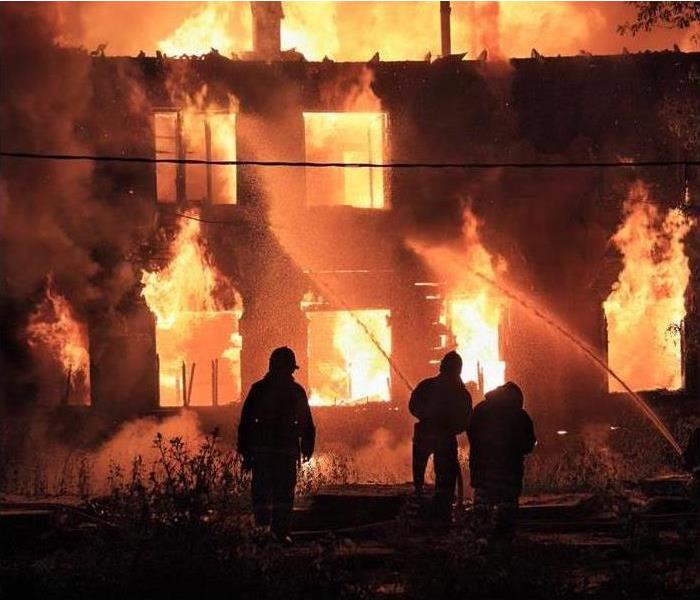 Wildfires pose a real danger to Northern California home and businesses
Wildfires pose a real danger to Northern California home and businesses
With the fires that are currently raging in Northern California's wine country fire safety, both from wildfires and accidental home fires, is a real concern for millions of California residents, including those in Palo Alto, Menlo Park, Atherton, and Redwood City in Santa Clara County, California.
Due to a combination of reasons, including weather conditions (including lack of rain and lack of humidity), increasing temperatures (global warming), and simple human error or carelessness (tossed cigarettes, illegal bonfires, intentional fire-setting), wildfires have been increasing in number and intensity in recent years. This means that experiencing fire damage has become a very real possibility for many Californians, including those in many parts of Santa Clara County, California.
There’s also the danger of fires starting in your home from electrical shorts or kitchen fires (the most common cause of in-home fires). According to The Red Cross, “If a fire starts in your home you may have as little as two minutes to escape. During a fire, early warning from a working smoke alarm plus a fire escape plan that has been practiced regularly can save lives.” Two minutes! That’s barely enough time to grab your pets and a couple of beloved belongings and escape. Not to mention dealing with the worry about your home due to fire damage because of fires in Palo Alto, Menlo Park, Atherton, or Redwood City.
Here are the top 7 ways to prepare for a home fire from redcross.org:
- Install the correct number of smoke alarms. Install a smoke detector inside each bedroom, outside each sleeping area, and on every level of the home, including the basement. On levels without bedrooms, install alarms in the living room (or den or family room) or near the stairway to the upper level, or in both locations. Test your smoke alarm or smoke detector once a month and replace the batteries at least once a year.
- Teach children what smoke alarms sound like, and teach them what to do when they hear one. Practice with them twice-yearly.
- Ensure that all household members know at least two ways to escape from every room of your home, and that you determine a family meeting spot outside of your home in the case of a fire.
- Establish a family emergency communications plan and ensure that all household members know who to contact if they cannot find one another or cannot meet at the predetermined family meeting spot.
- Practice escaping from your home at least twice a year, and at random times. Press the smoke alarm test button or yell “Fire“ to alert everyone that they must get out.
- Make sure everyone knows how to call 9-1-1, no matter how young.
- Teach family members to STOP, DROP and ROLL if their clothes should catch on fire.
The Red Cross also recommends you follow these fire-safe habits:
- Keep items that can catch on fire, like flammable clothing, paper, toys, etc. at least three feet away from anything that gets hot, such as space heaters.
- Smoking paraphernalia is the leading cause of residential fire deaths in the United States. Please do not smoke. If you have to smoke, take precautions: Smoke outside, choose fire-safe cigarettes, don’t smoke in bed, don’t smoke when drowsy or medicated, or if anyone in the home is using oxygen. That’s a disaster waiting to happen.
- Use deep, sturdy ashtrays and douse cigarette and cigar butts with water before disposal.
- Talk to children regularly about the dangers of fire, matches, and lighters and keep them out of reach.
- Turn portable heaters off when you leave the room or go to sleep.
- Never leave a burning candle unattended, even for a minute.
Following these fire-safe habits won’t protect you against wildfires, but there are steps you can take to help reduce the risk of fire damage to your home from a wildfire, such as those that have recently been burning in both Northern California and Southern California.
In the last two years, over 67,000 wildfires have been reported across the country each year, many in California. Yearly, wildfires destroy over 4,000 structures, with 3,000 of them residential. As real estate development expands into forests and grasslands, the chances of wildfire-related property damage go up.
You can’t fight back a wildfire that is encroaching on your home or business, but you can take steps to protect yourself and your property. Learn how you can help protect your home or business from a wildfire. Keep you and your family safe and know how and when to evacuate. Learn more in the second part of this blog post, to be continued next week.
If you already have suffered fire damage and need fire restoration, please call SERVPRO of Palo Alto at (650) 800-3448 for a free estimate. Our highly trained technicians use advanced equipment to make it “Like it never even happened.”
Fall Fire Safety Tips to Protect Your Home | SERVPRO® of Palo Alto
9/24/2020 (Permalink)
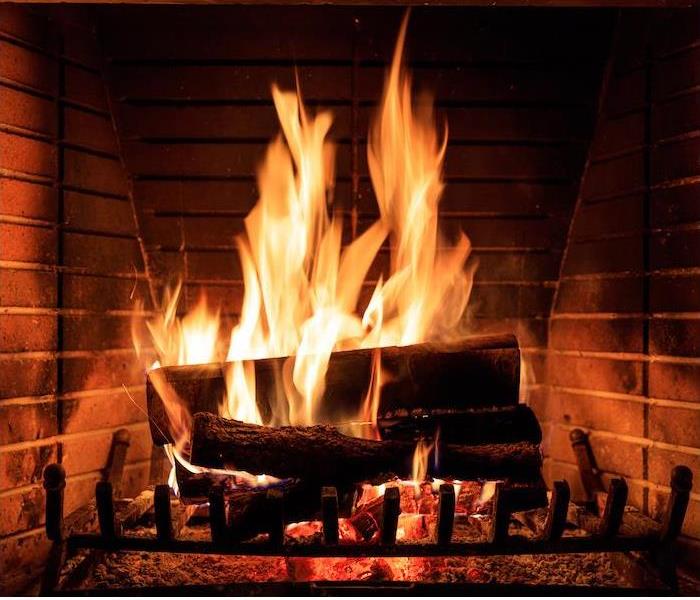 If you experience any property damage due to a fire, we are here for you. Contact SERVPRO of Palo Alto to learn more.
If you experience any property damage due to a fire, we are here for you. Contact SERVPRO of Palo Alto to learn more.
While it’s true that house fires can happen at any time during the year, statistically most happen in the fall and winter months, according to the American Red Cross.
But here’s the good news: Whether you’re having fall fun around a roaring bonfire or just relaxing around the fireplace in your living room, you can take simple steps to make fire safety a priority.
Keeping Fall Fun and Safe
Many people look forward to lighting the first fire of the year in their fireplace. But before you relax in front of the fire with your pumpkin latte or hot cider, be sure to have your fireplace and chimney checked out by a professional. You’ll have more peace of mind if you know that your chimney or fireplace doesn’t need maintenance.
While you’re getting a fireplace checked out, ask your inspector to be sure any other heating systems you might use are working well, too. Fixing small issues before they become big problems can help you protect your home and family from fires.
Bonfires are another popular fall tradition. They’re a great way to gather friends and enjoy treats like s’mores. But if you’re having a bonfire, be sure there’s always someone nearby to keep an eye on the fire and help keep it under control so it doesn’t cause unexpected damage. Don’t leave a burning fire unattended in your yard.
Change Your Smoke Detector Batteries
Checking your smoke detectors a couple of times every year can help give your family a sense of security and protect them from the dangers that can come with fires. Most experts recommend having smoke detectors in all bedrooms and other strategic spots around the house, like in the living room.
When you check your smoke detectors, be sure to have new batteries on hand so you can change them out.
If you have problems remembering when you need to change the batteries in your smoke detectors (and many people do), a good rule of thumb is to switch them every spring and fall when you change your clocks.
<h2re-here-if-you-need-us">We’re Here if You Need Us
If an accident happens at your home this fall and you need help restoring fire or smoke damage, you don’t have to look far.
Our team is always ready to help you if a fire damages your home. Local experts can guide you through the fire restoration process and help get your home back in top shape.
We’re here to talk with you 24⁄7 if you need to learn more about our fire restoration process.
Take Precaution Every Time You Light Your Grill | SERVPRO® of Palo Alto
7/24/2020 (Permalink)
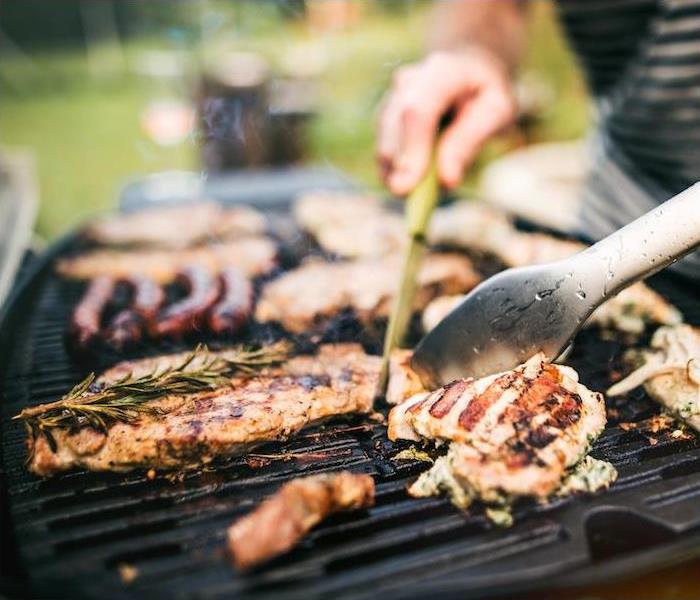 SERVPRO of Palo Alto is the fire restoration experts. To learn more give us a call or contact us online.
SERVPRO of Palo Alto is the fire restoration experts. To learn more give us a call or contact us online.
Cooking a homemade meal is a great way to spend time together as a family, especially if you are taking advantage of your backyard space and your grill. Grilled food is always delicious, but we do encourage people to remember their fire safety considerations every time an open flame is around.
Grill fires happen more regularly than many people realize—nearly 6,000 occur annually, according to the U.S. Fire Administration. A few fire safety tactics can go a long way to ensuring every cookout is a safe one.
Ensure Every Cookout Is a Safe One With Fire Safety Tips
Create a safe zone around your grill. While the deck right outside your back door may seem like the most logical place to put your grill, it may not be the safest. Three feet is the recommended safe zone for grilling—this is the zone where there is nothing that could catch on fire or melt, just in case.
Clean your grill grates often. Good grill habits involve regularly cleaning your grates, but this is good for more than keeping cooking temperatures consistent. As food particles and grease accumulate on the grates of the grill, they can heat up and catch fire eventually. By regularly scraping down your grates, you can significantly lessen the chance of this occurring.
Never leave the grill unattended. As with any open flame, a lit grill should never be left unattended, even with a closed lid. Fires can happen in an instant, and if you are not there with your fire extinguisher, they can get out of hand before you know it. Having someone take over so you can take a break is a wise way to prevent any accidents.
Inspect the grill regularly. It is always a good idea to do a visual inspection of your grill, even if you have been using it regularly. With use, gas connections and hoses can deteriorate and cause leaks, which can lead to a catastrophe if the grill is lit and gas vapors are in the air. Making an inspection part of your habit is one of the best things you can do to ensure you are being safe.
If you have a grill fire that does damage to your home, we are here to help. You can call us any time, day or night, to have a quick response from our restoration experts.
Our Recommendations Regarding House Fire Recovery | SERVPRO® of Palo Alto
6/15/2020 (Permalink)
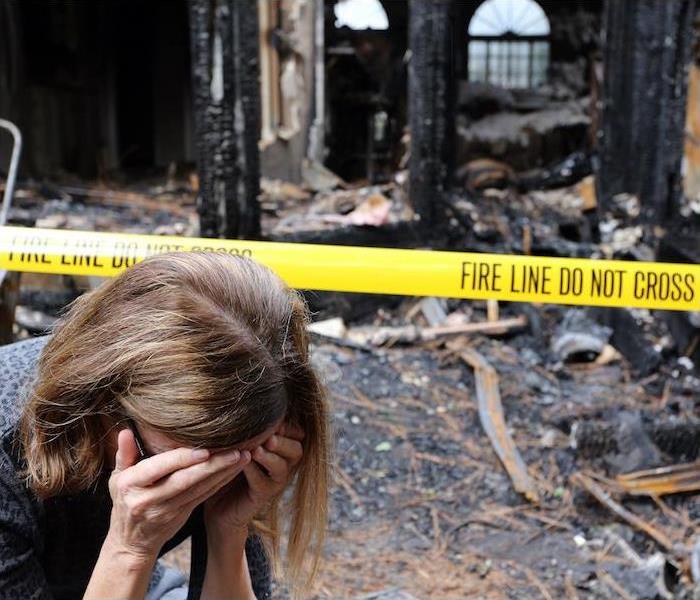 If your home is damaged in a house fire, SERVPRO of Palo Alto is here to help. Contact us for any fire restoration needs.
If your home is damaged in a house fire, SERVPRO of Palo Alto is here to help. Contact us for any fire restoration needs.
It is important that you and everyone in your household know what to do in the event of a fire, including having an emergency plan and practicing evacuation drills. However, you should also be aware of the difficulties regarding the aftermath of a fire and have a plan for how to navigate those as well.
With our tips for navigating the aftermath of a house fire, you can make sure you are following the right steps for a simple, quick recovery for your household.
Tips for Navigating the Aftermath of a House Fire
Prepare yourself for what to expect. The damages from every house fire are unique, but understanding the common implications of house fire damage is a good way to prepare yourself. Smoke and soot can often travel throughout the home, even impacting areas that had no direct flames. Additionally, firefighters may have to cause damage in order to make the fire safe to fight, so it is wise to prepare for these things ahead of time to avoid the shock.
Wait to enter your home. It is normal to immediately want to begin handling the damage and getting the restoration process started, but first, you need to make sure it is safe for you to re-enter the home. Structural damage is quite common after a fire breaks out, so wait for officials to authorize it before you go back into the home.
Contact your insurance company. The process of filing an insurance claim will vary based on your provider, so getting in touch with them early on is highly recommended. This way you can be certain you are not taking any unauthorized actions that could undermine your claim.
Document the damages. Records of the damages in the way of inventory lists and photographs are a smart way to stay organized. Not only will this be helpful for you as you recall what items you must replace after the restoration, but you can also use this to simplify your insurance claims process as well.
Contact your restoration company. A house fire is a traumatic thing for your family to experience, so recovering quickly is a great way to emotionally heal from the process. To make it as smooth as possible, we always recommend working with a reputable, well-trusted restoration company that is based locally, so you can be certain the job will be done right.
If your home is damaged in a house fire, you can count on us to help you. Get in touch at any hour for a quick response.
Top Tips to Boost Your Household Fire Safety | SERVPRO® of Palo Alto
1/30/2020 (Permalink)
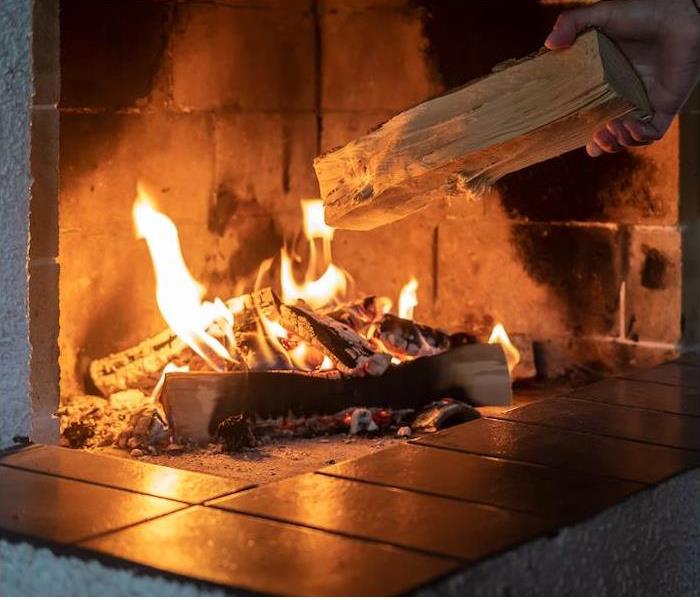 Protect Your Home From Fire
Protect Your Home From Fire
Because we have helped many local families restore their homes following a fire, we are aware of just how devastating a house fire can be. Not only can flames rip through property and belongings, but they can also cause traumatic and irreparable injuries.
In order to help the community be more fire-safe, we wanted to take the time to assemble the fire safety tips that we think every individual should be aware of. While some fires happen erratically, using these tips will significantly reduce your chances of experiencing one.
Tips to Up Your Fire Safety EffortsFrequently Check Smoke Detectors. Smoke alarms should be installed throughout the house and checked every 30 days to ensure they are operational. Homeowners are also wise to consider installing an interconnected system, so they all will alert you when one picks up a hint of smoke.
Have a Fire Escape Plan. Crafting a plan for how to escape once a fire breaks out in your home and practicing it often is one of the best measures to take to ensure your family can quickly get to safety. Make sure everyone is aware of what to do and where to meet outside.
Know How to Operate a Fire Extinguisher. Selecting the right fire extinguisher, storing it safely and educating every household member on how to use it can be the difference between a scary moment and a full-scale disaster.
Never Leave Flames Unattended. Open flames are everywhere—grills, fireplaces and candles are common fire starters that many people do not consider dangerous. No matter how small the flame, it is advised to never leave the room if there is a fire lit as it could spread in a moment.
Keep a Closed-Door Policy. The most dangerous fires are the ones that occur at night, because of the reduced reaction time involved with waking up to a house fire. One of the things that can make the biggest difference is sleeping with the bedroom door closed—this will slow down the spread of flames to provide more reaction time to everyone in the home.
If you’d like to learn more about protecting yourself from a house fire and how our restoration services can help you recover, get in touch today to learn more.
Quality Fire Damage Restoration Services for Bay Area Homes & Businesses
1/19/2020 (Permalink)
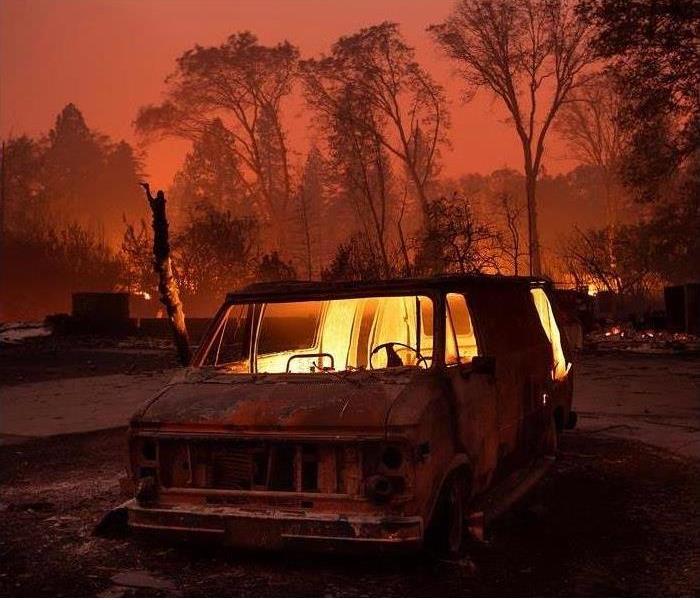 Devastating Fire Damage from Firestorms in Californa
Devastating Fire Damage from Firestorms in Californa
Last year was a major year of firestorms in many parts of California -- from Southern California to Northern California.
Damage caused by a fire is life-changing for home and business owners. It’s a stressful and confusing time, so you’ll need caring fire restoration experts to guide you through this crisis, from beginning to end. The professional restoration technicians at SERVPRO of Palo Alto will always treat you with respect and empathy, and we’ll always handle your home or business with great care. We can recover many of your belongings that you may have thought lost forever.
Home or business owners can be caught off guard with a sudden fire emergency. It’s important not to delay and discuss available coverage with your insurance company, in addition to taking the appropriate steps to limit the losses you might experience in case of an emergency situation. SERVPRO of Palo Alto will help you deal with your insurance company, and assist you with the paperwork involved in your claim, making the process as stress-free as possible.
At SERVPRO of Palo Alto, we have the specialized fire and water damage restoration training, personnel, and equipment to handle fire damage to help you through this tough time. We can quickly restore your home to pre-fire condition. SERVPRO uses the latest technology, including water extractors, moisture detectors, and air moving equipment to effectively dry areas affected by firefighting efforts.
Rely on SERVPRO of Palo Alto for fire damaging events to your property. We are available 24/7, including holidays. Call us at 650-800-3448 for fire restoration in the Bay Area today!
Top 5 Fire Prevention Tips for the Bay Area
12/16/2019 (Permalink)
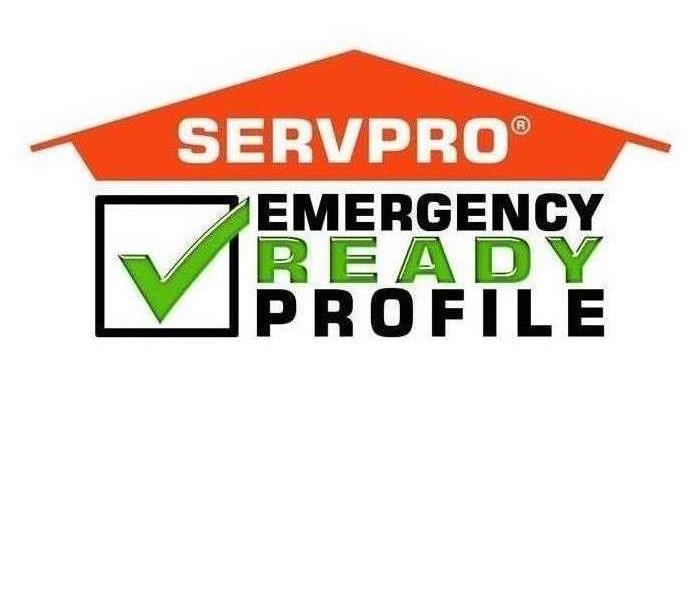 Contact SERVPRO for Information about Creating Your ERP
Contact SERVPRO for Information about Creating Your ERP
Having an emergency response plan (ERP) in case of a fire is important in order to protect your residence or business in Palo Alto, Menlo Park, Stanford, Atherton, and Redwood City. The first 48 hours after a fire can make a difference in determining whether to restore, rather than to replace your property and personal processions. SERVPRO of Palo Alto believes in educating our customers on the importance of fire prevention with the top five tips from the National Fire Protection Association.
- Do not leave your cooking unattended, especially when frying, grilling, or broiling food. The stove should be turn off if you must leave, even for a short period of time
- Portable heaters should be kept at least three feet away from anything that can burn.
- Inspect electrical cord and replace any that are cracked, damage or broken.
- Keep candles at least one foot from anything that can burn.
- Have an escape plan.
At SERVPRO of Palo Alto, we believe in the importance of being prepared, which is why we provide our customers with an Emergency Ready Profile. Our SERVPRO professionals can assist you in developing an ERP plan which contains crucial information needed in the event of an emergency occurring.
Call SERVPRO of Palo Alto for more information on fire prevention and for any fire restoration needs at 650-800-3448 today!
Quality Fire Damage Restoration Services for Bay Area Homes & Businesses
12/14/2019 (Permalink)
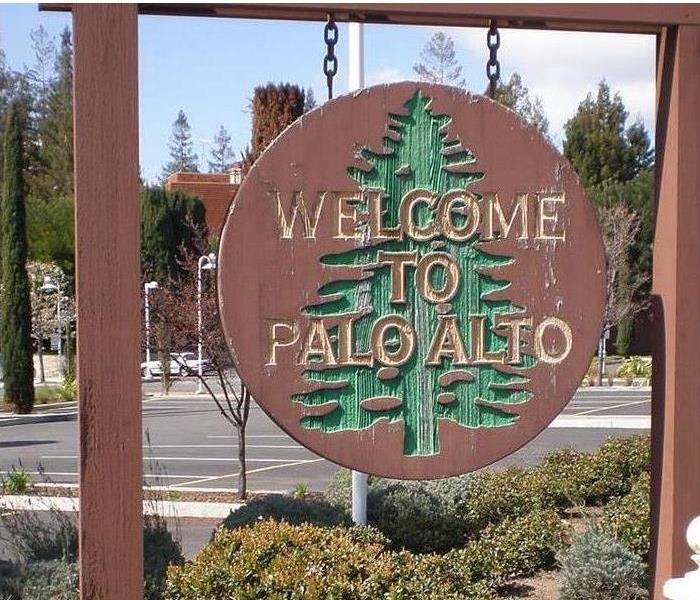 SERVPRO of Palo Alto restores fire damage in Bay Area cities like Palo Alto
SERVPRO of Palo Alto restores fire damage in Bay Area cities like Palo Alto
Damage caused by a fire is devastating for home and business owners in the Bay Area, particularly in Palo Alto, Stanford, East Palo Alto, and Menlo Park. It’s a stressful and confusing time, so you’ll need caring experts to guide you through this crisis, from beginning to end. Our damage restoration professionals at SERVPRO of Palo Alto will always treat you with respect and empathy, and we’ll always handle your home and belongings with great care. We can recover many of your belongings that you may have thought lost forever.
Home or business owners can be caught off guard by a sudden fire emergency. It’s important not to delay and discuss available coverage with your insurance company, in addition to taking the appropriate steps to limit the losses you might experience in case of an emergency situation. SERVPRO of Palo Alto will help you deal with your insurance company, and assist you with the paperwork involved in your claim, making the process as stress-free and efficient as possible.
At SERVPRO of Palo Alto, we have the specialized fire and water damage restoration training, personnel, and equipment to handle fire damage to help you through this tough time. We can quickly restore your home to pre-fire condition, so you can enjoy your home again. SERVPRO uses the latest damage restoration technology, including water extractors, moisture detectors, and air moving equipment to effectively dry areas affected by firefighting efforts.
Rely on SERVPRO of Palo Alto for fire damaging events to your property. We are available 24/7, including holidays. Call us at 650-800-3448 today!
Types of Smoke and Fire Damage in Your Palo Alto Home
10/14/2019 (Permalink)
With fire damage, comes smoke and soot. Smoke and soot is very invasive and can penetrate various cavities within your home, causing hidden damage and odor. SERVPRO of Palo Alto's smoke damage expertise and experience allows us to inspect and accurately assess the extent of the damage to develop a comprehensive plan of action.
Smoke and soot facts:
- Hot smoke migrates to cooler areas and upper levels of a structure.
- Smoke flows around plumbing systems, seeping through the holes used by pipes to go from floor to floor.
- The type of smoke may greatly affect the restoration process.
Different Types of Smoke
There are two different types of smoke–wet and dry. As a result, there are different types of soot residue after a fire. Before restoration begins, SERVPRO of Palo Alto will test the soot to determine which type of smoke damage occurred. The cleaning procedures will then be based on the information identified during pretesting. Here is some additional information:
Wet Smoke – Plastic and Rubber
- Low heat, smoldering, pungent odor, sticky, smeary. Smoke webs are more difficult to clean.
Dry Smoke – Paper and Wood
- Fast burning, high temperatures, heat rises therefore smoke rises.
Protein Fire Residue – Produced by evaporation of material rather than from a fire
- Virtually invisible, discolors paints and varnishes, extreme pungent odor.
Our Fire Damage Restoration Services
Since each smoke and fire damage situation is a little different, each one requires a unique solution tailored for the specific conditions. You may have water damage from the firefighting efforts that may have caused mold. For all your cleaning and restoration services, we have the equipment, expertise, and experience to restore your fire and smoke damage. We will also treat your family with empathy and respect and your property with care.
Have Questions about Fire, Smoke, or Soot Damage?
Call SERVPRO of Palo Alto Today at (650) 800-3448 for 24-hour service, 365 days a year!
SERVPRO of Palo Alto Takes Care of Your Fire Damage
10/1/2019 (Permalink)
Many homeowners in Palo Alto, Atherton, Menlo Park, Redwood City, North Fair Oaks, and Stanford who experience a fire damage event don't know what to do, where to begin, or how to rebuild or recuperate from such a loss. Many will be displaced for weeks or months at a time while their homes are being completely rebuilt or will face partial reconstruction and major cleanup.
The first thing you should do after such a loss is speak with your insurance company. Educate yourself on your policy and loss coverage.
Something to think about while writing up a policy (and prior to a natural disaster) is documenting your contents before such a loss can ravage your home. Taking pictures of your furniture, electronics, major belongings, in addition to creating lists of your valuables can literally save you thousands when you are trying to recoup your losses and make an insurance claim on damages.
If you are one of the lucky ones where the fire didn't completely consume your home, your insurance company will suggest calling a professional fire cleanup and restoration company, such as SERVPRO of Palo Alto. For homeowners in Palo Alto, Stanford, Atherton, Redwood City, Menlo Park, and North Fair Oaks, SERVPRO of Palo Alto will help you throughout the entire process. We work closely with you and your insurance claims representatives to clean up your home and contents, salvage what is salvageable, and inventory what is determined to be a total loss. We will remove the heavy smoke odor from your property and belongings and coordinate dry cleaners and other relevant contractors who can help repair your home. We will treat you and your property with great care and respect throughout the process. Our fire services include:
- Inspection and Fire Damage Assessment
- Immediate Board-Up and Roof Tarp Service (if needed)
- Water Removal and Drying (if water damage is present)
- Removal of Smoke and Soot from All Surfaces
- Cleaning and Repair
- Fire Restoration
Since each smoke and fire damage situation is a little different, each one requires a unique solution tailored for the specific conditions. We have the equipment, expertise, and experience to restore your fire, water and mold damage.
At SERVPRO of Palo Alto, we treat our customers with empathy and respect. Call us at 650-800-3448 if you need the best in the business when it comes to fire restoration!
Fire Safety Facts & Prevention Tips for the Bay Area
3/8/2019 (Permalink)
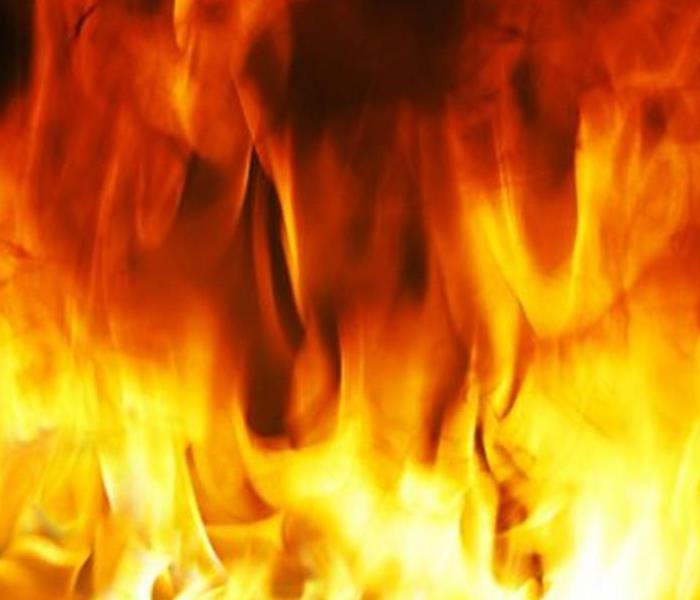 Keep safe with these fire safety tips.
Keep safe with these fire safety tips.
FIRE SAFETY FACTS
Each year, more than 4,000 Americans die in fires, more than 25,000 are injured in fires, and more than 100 firefighters are killed while on duty. Eighty three percent of all civilian fire deaths occurred in residences. Many of these fires could have been prevented.
Cooking is the third leading cause of fire deaths and the leading cause of injury among people ages 65 and older.
Direct loss due to fires is estimated at nearly $8.6 billion annually. Intentionally set structure fires resulted in an estimated $664 million in property damage.
In order to protect yourself, it is important to understand the basic characteristics of fire.
Fire is FAST. In just two minutes, a fire can become life-threatening. In five minutes, a residence can be engulfed in flames.
Fire is DARK. Fire produces gases that make you disoriented and drowsy. Instead of being awakened by a fire, you may fall into a deeper sleep. Asphyxiation is the leading cause of fire deaths, exceeding burns by a three- to- one ratio.
Fire is HOT. Heat and smoke from fire can be more dangerous than the flames. Inhaling the super- hot air can sear your lungs.
FIRE PREVENTION TIPS
BEFORE A FIRE
The following are things you can do to protect yourself, your family, and your property in the event of a fire:
SMOKE ALARMS AND CARBON MONOXIDE DETECTORS
Install smoke alarms. Properly working smoke alarms decrease your chances of dying in a fire by half.
Place smoke alarms on every level of your residence, including the basement.
Install a working carbon monoxide detector in the common area of the bedrooms.
Test and clean smoke alarms once a month and replace batteries at least once a year. Replace smoke
alarms once every 10 years.
COOKING SAFETY
Never leave cooking unattended.
Always wear short or tight-fitting sleeves when you cook.
Keep towels, pot holders and curtains away from flames
Never use the range or oven to heat your home.
ESCAPING THE FIRE
• Have an escape plan. Review escape routes with your family.
Make sure windows are not nailed or painted shut.
Teach family members to stay low to the floor, where the air is safer, when escaping from a fire.
In high-rise, never lock fire exits or doorways, halls or stairways. Never prop stairway or other fire
doors open.
HEATING SOURCE
Place space heaters at least three feet away from flammable/combustible materials.
Use only the type of fuel designated for your space heater.
MATCHES/LIGHTERS AND SMOKING
Keep matches/lighters away from children.
Never smoke in bed or when drowsy or medicated.
If you must smoke, do it responsibly.
ELECTRICAL WIRING
Inspect extension cords for frayed or exposed wires or loose plugs
Make sure outlets have cover plates and no exposed wiring.
Make sure wiring does not run under rugs, over nails, or across high traffic areas.
Do not overload extension cords or outlets.
ASK THE FIRE DEPARTMENT TO INSPECT YOUR HOME FOR FIRE SAFETY AND PREVENTION
DURING A FIRE
If your clothes catch on fire, you should:
• Stop, drop, and roll until the fire is extinguished.
DO NOT PANIC
• Do not assume someone else already called the fire department get out of the house then call the Fire Department.
ESCAPE A FIRE
Check closed doors with the back of your hand to feel for heat before you open them.
If the door is hot do not open it. Find a second way out, such as a window. If you cannot escape
through a window, hang a white sheet outside the window to alert firefighters to your presence.
Stuff the cracks around the door with towels, rags, bedding or tape and cover vents to keep smoke
out.
If there is a phone in the room where you are trapped, call the fire department again and tell them
exactly where you are.
If the door is cold slowly open it and ensure that fire and/or smoke is not blocking your escape
route. If your escape route is blocked, shut the door and use another escape route.
• If clear, leave immediately and close the door behind you. Be prepared to crawl.AFTER A FIRE
Once you are out of the building, STAY OUT! Do not go back inside for any reason.
If you are with a burn victim or are a burn victim yourself call 911, cool and cover your burns until
emergency units arrive.
If you are a tenant contact the landlord.
Tell the fire department if you know of anyone trapped in the building.
Only enter when the fire department tells you it is safe to do so.
Holiday Fire Prevention Tips
12/12/2018 (Permalink)
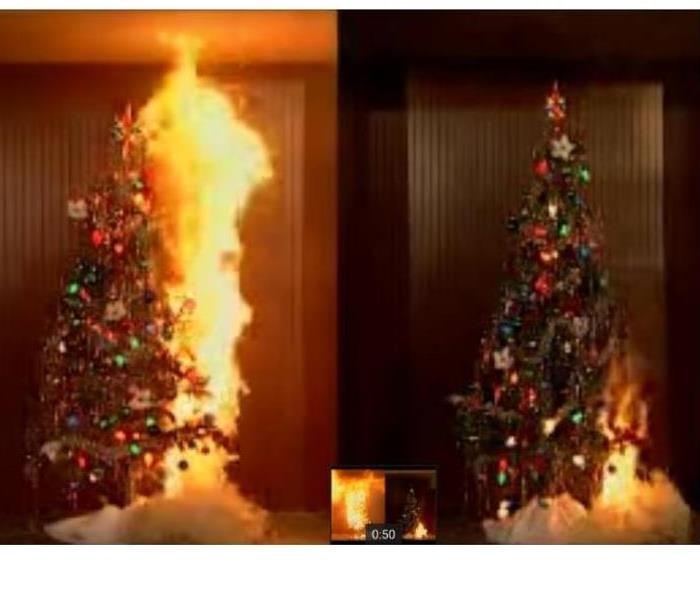 Holiday Fire Hazard in Palo Alto, California
Holiday Fire Hazard in Palo Alto, California
Holiday Safety Tips
It's the happiest time of the year! During this time of the year, there are carolers singing, egg nog, bright lights, tasty food, chilly weather, and shopping for presents.
With all these fun and festive things going on, it is easy to forget that this time of year lends itself to some very real fire hazards. Surprisingly, statistics show that residential fires are more costly and property loss is 34% greater during the holidays rather than any other time of the year. As a gift from your local neighborhood SERVPRO, here are a few tips to make sure your holiday is the merriest and safest it can be.
Kitchen
- Keep a multi-grade fire extinguisher handy for a variety of fires.
- Check the smoke detectors for operable batteries.
- If you are going to deep fry your turkey, make sure it is on a flat surface and at least 10 feet away outside from your home.
- If you are multitasking while you are cooking, make sure you have a cooking utensil in hand to remind you that something is on the stove.
Candles
- Maintain at least a foot between the candle and anything flammable in all directions.
- Before going to bed, make sure all candles are put out and never leave a flame unattended. However, if you prefer a low light setting, rather than use candles, switch to LED powered candles.
Christmas Trees
- Try to purchase a fresh cut tree with one that has all of its pine needles intact.
- Purchase a tree base that has room for you to water your tree every day.
- Watered trees will last longer and will typically dry out after 4 weeks.
- Remember to take your tree out as soon as possible after the holidays to prevent unwanted accidents. Dry trees are the easiest to catch on fire.
Decorative Lights
- Inspect light strings for cracks and/or fraying.
- Inspect light sockets for broken and exposed filaments.
- Do not run three strings from end to end, but instead, stack them because it is safer.
- Do not use nails or staples to hang your lights. Instead, use UL-Rated clips and hangers.
- Take lights down after the holidays to prevent squirrels from chewing on your cables and environmental damage.
The Fireplace
- Have your chimney inspected for collected soot that hardens after every use of your fireplace. If it needs to be cleaned, do so before you use it.
- Do not start a fire for your fireplace with wrapping paper or liquids; only use seasonal firewood.
- Set a screen in front of your fireplace to prevent the embers from your cozy fire does not damage or spark a fire to your items such as a rug or other flammables.
- Set extinguished embers in a metal container outside for at least 24 hours before throwing away.
If you have any questions, concerns, please call SERVPRO of Palo Alto at (650) 800-3448!
Most importantly, we are available for emergency services of any accidents or inconvenient mishaps 24/7.
From our family here at SERVPRO of Palo Alto to yours, we wish you a safe happy holidays!
Has Your Property Suffered Fire Damage? Call SERVPRO of Palo Alto
9/21/2018 (Permalink)
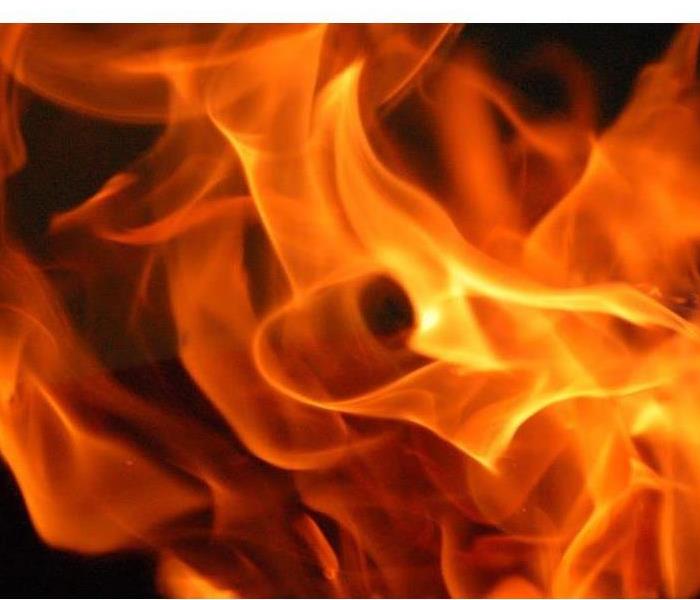 SERVPRO of Palo Alto takes care of fire restoration needs quickly and professionally!
SERVPRO of Palo Alto takes care of fire restoration needs quickly and professionally!
Many homeowners in the Bay Area who experience a fire damage event don't know what to do, where to begin, or how to rebuild or recuperate from such a loss. Many will be displaced for months while their homes are being completely rebuilt, and some will be facing partial reconstruction and major cleanup.
The first thing you should do after such a loss is speak with your insurance company. Clarify your policy, and hopefully your loss will be covered. Something to think about while writing up a policy (and prior to a natural disaster) is documenting your contents before such a loss can ravage your home. Taking pictures of your furniture, electronics, major belongings and creating lists of your valuables can literally save you thousands when you are trying to recoup your losses and make an insurance claim of what has been damaged or burnt.
If you are one of the lucky ones where the fire didn't completely consume your home, your insurance company will suggest calling a professional fire cleanup and restoration company, such as SERVPRO of Palo Alto. For homeowners in Palo Alto, Stanford, Atherton, Redwood City, Menlo Park, and North Fair Oaks, SERVPRO of Palo Alto will help you throughout the entire process. We work closely with you and your insurance claims representatives to clean up your home and contents, salvage what is salvageable, and inventory what is determined to be a total loss. We will remove the heavy smoke odor from your property and belongings and coordinate dry cleaners and other relevant contractors who can help repair your home. We will treat you and your property with great care and respect throughout the process. Our fire services include:
- Inspection and Fire Damage Assessment
- Immediate Board-Up and Roof Tarp Service (if needed)
- Water Removal and Drying (if water damage is present)
- Removal of Smoke and Soot from All Surfaces
- Cleaning and Repair
- Fire Restoration
Since each smoke and fire damage situation is a little different, each one requires a unique solution tailored for the specific conditions. We have the equipment, expertise, and experience to restore your fire, water and mold damage.
At SERVPRO of Palo Alto, we treat our customers with empathy and respect. Call us at 650-800-3448 today!
Fire Prevention Tips for Palo Alto Residents
9/21/2018 (Permalink)
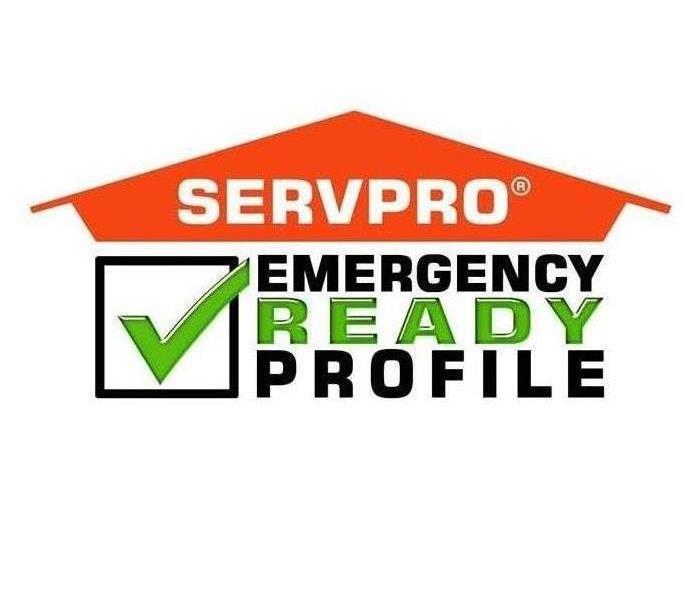 Create your emergency response plan today!
Create your emergency response plan today!
Having an emergency response plan (ERP) in case of a fire is important in order to protect your residence or business in Palo Alto, Menlo Park, Stanford, Atherton, and Redwood City. The first 48 hours after a fire can make a difference in determining whether to restore, rather than to replace your property and personal processions. SERVPRO of Palo Alto believes in informing our customers the importance of fire prevention with some tips from the National Fire Protection Association.
- Do not leave your cooking unattended specially when frying, grilling or broiling food. The stove should be turn off if you must leave, even for a short period of time
- Portable heaters should be kept at least three feet away from anything that can burn.
- Inspect electrical cord and replace any that are cracked, damage or broken.
- Keep candles at least one foot from anything that can burn.
- Have an escape plan.
At SERVPRO of Palo Alto, we believe in the importance of being prepared, which is why we provide our customers with an Emergency Ready Profile. Our SERVPRO professionals can assist you in developing an ERP plan which contains crucial information needed in the event of an emergency occurring.
Contact SERVPRO of Palo Alto for more information on Fire prevention and restoration at 650-800-3448 today!
Football Season Fire Safety
9/13/2018 (Permalink)
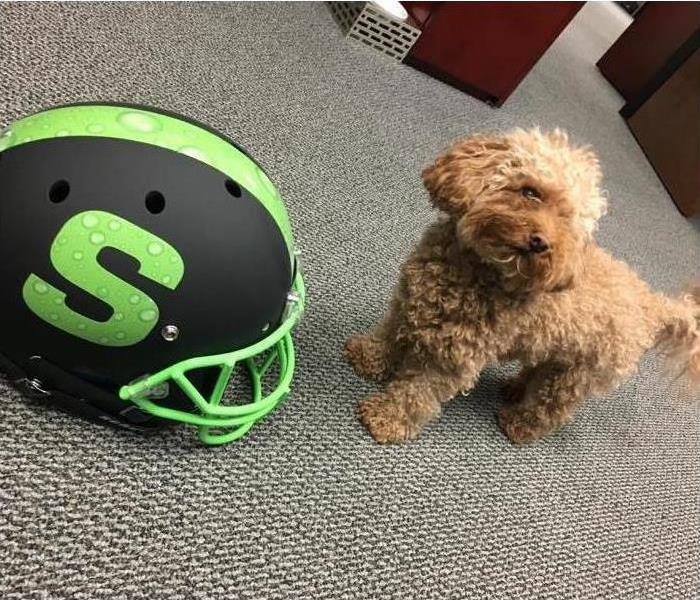 Fire safety during football season
Fire safety during football season
Football season is here!
Benny, our SERVPRO office mascot, is ready for tailgating parties, and BBQs. But before you get started, he has some important tips for you.
Benny’s fire safety tips during this football season:
- Make sure to have a fire extinguishers handy when grilling.
- If at home, make sure all fire detectors are properly installed.
- Using a charcoal grill? Make sure the coals are cool before disposing.
- Make sure there are no flammable items nearby when cooking or grilling.
- Never leave the grill or stove unattended.
If your home does suffer from a fire, SERVPRO of Palo Alto will be there for you. Once firefighters have cleared the premises, your property might have suffered water damage from their firefighting efforts as well as smoke and soot damage.
For fire restoration services, SERVPRO of Palo Alto has the training needed to restore your home and property to pre-fire condition. Do not wait to call us at 650-800-3448.
Benny and our SERVPRO of Palo Alto team, wish your favorite team the best of luck this season!
Wildfire Safety Tips for California Residents Part 2
1/3/2018 (Permalink)
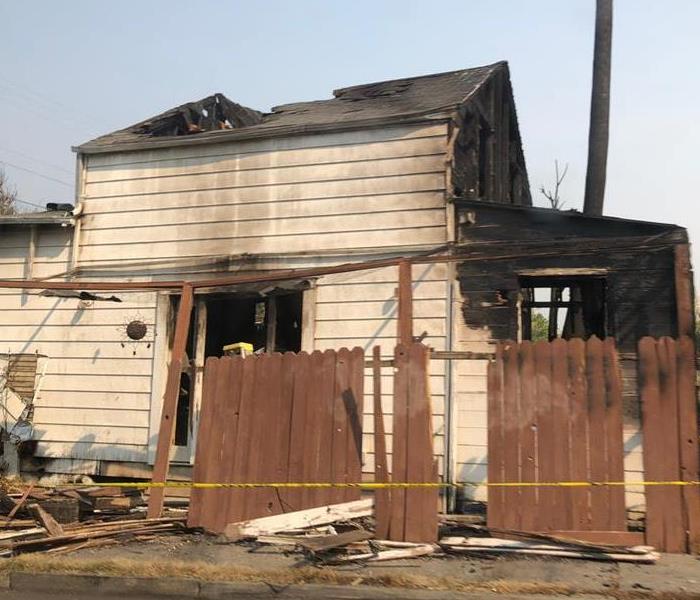 Northern California Fire Damage
Northern California Fire Damage
The new year has started, and with it should be taking proactive steps to help prevent fires - both in the home from kitchen accidents and electrical shorts to threats from outside the home that result in wildfires. The end of 2017 saw massive wildfires in Napa Valley and Sonoma counties, Ventura county, and Los Angeles as we wrote about in Part 1 of this blog post. Let’s learn our lesson and do what we can to prevent and minimize fire damage where we live and where SERVPRO of Palo Alto serves: Palo Alto, Menlo Park, Atherton and Redwood City in Santa Clara County, California.
Because weather conditions are drier and hotter every year, and because many people are careless with their cigarettes and bonfires, fire damage in California becomes a reality for many California residents of Santa Clara county. Almost 70,000 wildfires occurred in the United States just in the last two years, destroying over 4,000 standing structures, including businesses and homes. You can’t necessarily fight back an out-of-control wildfire that’s threatening your home or business, but you can take steps to protect yourself and your property.
In addition to the top 7 ways to prep for a home fire - which includes installing the correct number of smoke alarms, teaching children about smoke alarm protocol, having at least two escape routes from your home in the case of a fire, and practicing escaping at least twice a year - the Red Cross gives you these wildfire-specific tips that you can use in the case of wildfires in Palo Alto, Menlo Park, Atherton and Redwood City in Santa Clara County, California.
These are important steps you can take to help reduce the risk of fire damage and smoke or soot damage to your home from a wildfire, such as those that have recently burned in both Northern California and Southern California.
Before a Wildfire
Defend your property in the case of a wildfire. One of the first steps you limiting the fire fuel sources around your home or business.
30 Feet or less from your property
- Clear combustible materials such as dried leaves and pine needles.
- Cut down any tree limbs that are 15 feet or closer to the ground. This helps prevent the fire from spreading into your property’s tree line.
- Remove any vines or vegetation that is on the side of your structure or property.
- Store any flammable lawn furniture during the off season.
- Choose non-flammable decor for your landscaping, such as gravel instead of wood chips.
Within 100 to 30 feet from your property
- Create “fuel breaks” in your property. Fuel breaks can help stop the spread of a fire. Examples are gravel pathways or driveways.
- Cut any trees branches that are 8 feet or closer to the ground.
- Clear combustible vegetation.
Within 200 to 100 feet from your home
- Place stacked firewood or scrap wood no closer to your property line.
- Continue to clear combustible vegetation.
- Plant trees far enough apart so their branches do not touch, and trim branches that do touch.
- Prepare your home or business for a wildfire. If possible, use Class A roofing material. This includes tile, slate, or asphalt. You can also use Class B pressure-treated shingles or shakes.
- Consider installing fire sprinklers. In some areas, fire sprinklers are mandatory for businesses.
Outside your home, make sure your garden hose is long enough have enough to reach any part of your property. Make sure that the fire department can access water sources such as swimming pools, ponds, lakes, wells, and fire hydrants.
Create an emergency escape plan. Speak to city or county officials to learn what the evacuation route is for your area, and discuss this evacuation route with everyone in your family and your employees. Ensure family members who live nearby know the route and have means of transportation. Also, sign up for emergency text or alert messages from your city or neighborhood. And importantly, don’t forget to create an emergency kit.
During a Wildfire
- Prepare to evacuate.
- Listen to emergency channels or follow your city’s social media to keep up on the status of the fire.
- Keep your emergency kit handy so you can evacuate quickly.
After a Wildfire
- Return to your home or business only when it is safe, and when officials declare it safe to do so.
- Watch out for ash pits and hot spots. These are holes filled with hot ashes left by burned trees. Even after a fire is extinguished, small fires can flare up without warning.
- Check your house and surrounding property for hot spots and extinguish them immediately. Also, be on the lookout for ash pits.
- Document the damage. Take photos and video and make a written list documenting your damaged property. Contact your insurance company immediately to report the damage.
- Call a respected restoration company like SERVPRO of Palo Alto to help mitigate fire damage, smoke damage, soot damage, and water damage quickly, professionally, and efficiently.
Wildfires are some of the most destructive forces of nature. There isn’t much that can be done to deter a wildfire’s path. But luckily, there are ways to help mitigate fire damage, smoke and soot damage, and water damage from fire-fighting efforts to keep your loved ones and employees safe.
If you already have suffered fire damage and need fire restoration or smoke and soot restoration, please call SERVPRO of Palo Alto at (650) 800-3448 for a free estimate. Our highly trained technicians use advanced equipment to make it “Like it never even happened.”
Fire Safety Tips for California Residents
12/12/2017 (Permalink)
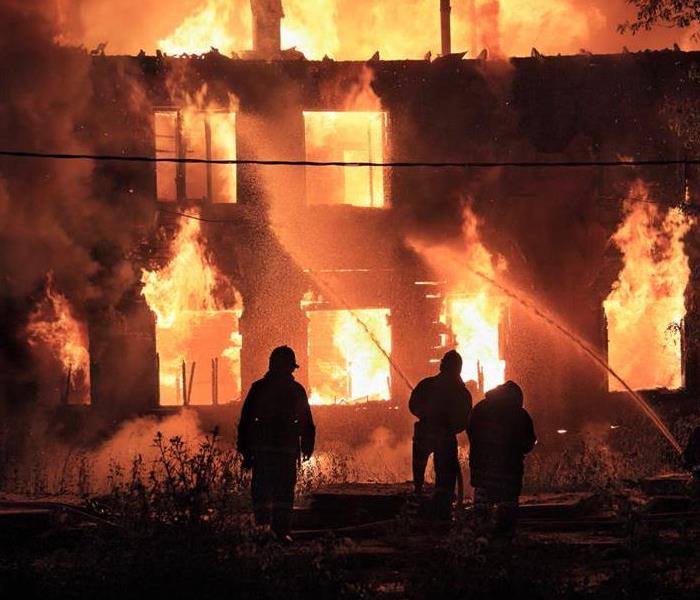 Fire Safety Tips
Fire Safety Tips
With the fires that raged in Napa Valley and Sonoma county, and the ones that are currently active in Ventura county and in Los Angeles, fire safety, both from wildfires and accidental home fires, is a real concern for millions of California residents, including those in Palo Alto, Menlo Park, Atherton and Redwood City in Santa Clara County, California.
Due to a combination of reasons, including weather conditions (including lack of rain and lack of humidity), increasing temperatures (global warming), and simple human error or carelessness (tossed cigarettes, illegal bonfires, intentional fire-setting), wildfires have been increasing in number and intensity in recent years. This means that experiencing fire damage is a real possibility for many Californians, including those in many parts of Santa Clara County, California.
There’s also the danger of fires starting in your home from electrical shorts or kitchen fires (the most common cause of in-home fires). According to The Red Cross, “If a fire starts in your home you may have as little as two minutes to escape. During a fire, early warning from a working smoke alarm plus a fire escape plan that has been practiced regularly can save lives.” Two minutes! That’s barely enough time to grab your pets and a couple of beloved belongings and escape. Not to mention dealing with the worry about your home due to fire damage because of fires in Palo Alto, Menlo Park, Atherton or Redwood City.
Here are the top 7 ways to prepare for a home fire from redcross.org:
- Install the correct number of smoke alarms. Install a smoke detector inside each bedroom, outside each sleeping area and on every level of the home, including the basement. On levels without bedrooms, install alarms in the living room (or den or family room) or near the stairway to the upper level, or in both locations. Test your smoke alarm or smoke detector once a month and replace the batteries at least once a year.
- Teach children what smoke alarms sound like, and teach them what to do when they hear one. Practice with them twice-yearly.
- Ensure that all household members know at least two ways to escape from every room of your home, and that you determine a family meeting spot outside of your home in the case of a fire.
- Establish a family emergency communications plan and ensure that all household members know who to contact if they cannot find one another or cannot meet at the predetermined family meeting spot.
- Practice escaping from your home at least twice a year, and at random times. Press the smoke alarm test button or yell “Fire“ to alert everyone that they must get out.
- Make sure everyone knows how to call 9-1-1, no matter how young.
- Teach family members to STOP, DROP and ROLL if their clothes should catch on fire.
The Red Cross also recommends you follow these fire-safe habits:
- Keep items that can catch on fire, like flammable clothing, paper, toys, etc. at least three feet away from anything that gets hot, such as space heaters.
- Smoking paraphernalia is the leading cause of residential fire deaths in the United States. Please do not smoke. If you have to smoke, take precautions: Smoke outside, choose fire-safe cigarettes, don’t smoke in bed, don’t smoke when drowsy or medicated, or if anyone in the home is using oxygen. That’s a disaster waiting to happen.
- Use deep, sturdy ashtrays and douse cigarette and cigar butts with water before disposal.
- Talk to children regularly about the dangers of fire, matches and lighters and keep them out of reach.
- Turn portable heaters off when you leave the room or go to sleep.
- Never leave a burning candle unattended, even for a minute.
Following these fire-safe habits won’t protect you against wildfires, but there are steps you can take to help reduce the risk of fire damage to your home from a wildfire, such as those that have recently been burning in both Northern California and Southern California.
In the last two years, over 67,000 wildfires have been reported across the country each year, many in California. Yearly, wildfires destroy over 4,000 structures, with 3,000 of them residential. As real estate development expands into forests and grasslands, the chances of wildfire related property damage goes up.
You can’t fight back a wildfire that is encroaching on your home or business, but you can take steps to protect yourself and your property. Learn how you can help protect your home or business from a wildfire. Keep you and your family safe and know how and when to evacuate. Learn more in the second part of this blog post, to be continued next week.
If you already have suffered fire damage and need fire restoration, please call SERVPRO of Palo Alto at (650) 800-3448 for a free estimate. Our highly trained technicians use advanced equipment to make it “Like it never even happened.”
Planning Halloween the SERVPRO way!
10/4/2017 (Permalink)
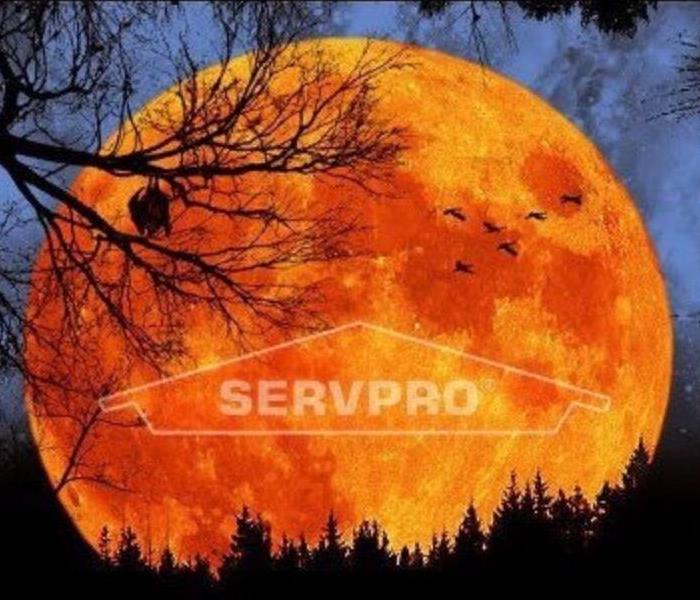 From all of us at SERVPRO of Palo Alto, we wish you a SPOOK-TACULAR and SAFE Halloween!
From all of us at SERVPRO of Palo Alto, we wish you a SPOOK-TACULAR and SAFE Halloween!
October is here, and department stores are stocking up on pumpkins, costumes, and candy to prepare for Halloween on October 31st. Halloween is an exciting holiday for most families—even pets join in for the clever costumes and trick-or-treating excitement. At SERVPRO of Palo Alto, we urge our customers who celebrate this holiday to take the necessary precautions to make it safe. Every year, Halloween fires occur, affecting hundreds of home structures due to candles, decorations, or unsafe costumes, and causing fire damage and smoke damage, requiring extensive fire restoration. Most holiday fire hazards can be avoided by taking safety precautions, and by a little extra planning to ensure this year’s Halloween remains fire-free and enjoyable for all.
The National Fire Protection Association’s (NFPA) statistics show that from 2009-2013, an average of 860 home structure fires occurred, causing an average of one death, 41 injuries, and $13 million in direct property damage per year. These fires usually occur from flammable decoration being placed too close to a heat source. Forty-one percent of these incidents were started by candles; one-fifth began in the living room, family room, or den.
Below are some Halloween safety tips provided by the NFPA to ensure that this year’s trick-or-treating does not turn into a horror story.
- When choosing a costume, stay away from billowing or long, trailing fabric. If you’re making your own costume, choose material that won't easily ignite if it comes into contact with heat or flame. If your child is wearing a mask, make sure the eye holes are large enough so they can see out.
- Provide children with flashlights to light their paths, or give them glow sticks as part of their costume.
- Dried flowers, cornstalks, and crepe paper are highly flammable. Keep these and other decorations well away from all open flames and heat sources, including light bulbs and heaters.
- Use a flashlight or battery-operated candles in a Jack-o-lantern. If you insist on using a real candle, practice extreme caution. Make sure children are supervised at all times when candles are lit. When lighting candles inside Jack-o-lanterns, use long, fireplace-style matches or a utility lighter. Be sure to place lit pumpkins well away from anything that can burn and far enough out of way trick-or-treaters, doorsteps, walkways and yards.
- If you choose to use candle decorations, make sure to keep them well attended at all times.
- Remember to keep exits clear of decorations, so nothing blocks escape routes.
- Tell children to stay away from open flames. Be sure they know how to stop, drop, and roll if their clothing catches fire. (Have them practice stopping immediately, dropping to the ground, covering their face with hands, and rolling over and over to put the flames out.)
- Use flashlights as alternatives to candles or torch lights when decorating walkways and yards. They are much safer for trick-or-treaters, whose costumes may brush against the lighting.
- If your children are going to Halloween parties at others’ homes, have them look for ways out of the home and plan how they would get out in an emergency.
- Children should always go trick-or-treating with a responsible adult.
- Remind children to stay together as a group when walking from house to house.
- Review how to safely cross a street with your child. Look left, right, and left again to be sure no cars are approaching before crossing the street.
- Make (and enforce) the rule that children not eat any treat until it has been brought home and examined by an adult.
Pre-planning
As part of your Halloween pre-planning, download our Emergency Ready APP to your phone or tablet to create a personalized plan in case of an emergency. The app is free and easy to use. If you have any questions or damage to your property, please feel free to call us at (650) 800-3448.
Download the app today!
SERVPRO of Palo Alto
2625 Middlefield Road #557 Palo Alto, CA 94306(650) 800-3448
Select SERVPRO of Palo Alto as your preferred franchise.
https://ready.SERVPRO.com/home/mobileapp
Protect Your Home from a Wildfire
9/21/2017 (Permalink)
As Californians, we know the real threat of wildfires. California residents need to be more aware on how best to protect their homes from wildfires. Our wildfire risk is extremely high, especially with the severe drought conditions our state can face. According to the Federal Emergency Management Agency (FEMA), here are some top ways to protect your property in Atherton, Redwood City, Menlo Park, and North Fair Oaks and other Bay Area cities:
Have you thinned out and maintained the vegetation around the house?
All vegetation is fuel for a wildfire, therefore the greater the distance between your home and the vegetation, the greater the protection. Create a 30-foot safety zone around the house, if possible. At a minimum, create a defensible space of 0-5 feet, and use noncombustible materials, such as gravel, brick, or concrete in this critical area adjacent to your home. Remove vines from the walls of the house, prune branches and shrubs within 15 feet of chimneys.
Create a second zone of 100 feet reducing or replacing as much of the most flammable vegetation as possible. If you live on a hill, you may need to extend the zone for several hundred feet.
Are combustible materials away from the house? Identify all combustible materials outside the house, stack firewood 100 feet away and uphill from the house. Keep the gas grill and propane tank at least 15feet away from the house and place a mesh screen over the grill.
Is the roof made of noncombustible materials? Materials that are fire resistant include single ply membranes, fiberglass shingles, slate, metal, clay, and concrete tile. Clean debris from roof since debris can be ignited by wind-blown embers.
Are sundecks and porches enclosed underneath? Are eaves and overhangs enclosed? Clear leaves, trash and other fire hazards away from decks and porches, extend 1/2 inch mesh screen from all overhands down to the ground. Enclose all eaves to reduce the hazard.
Clean out gutters regularly. Keep debris out of gutters, since debris can be ignited by wind-blown embers. If used, gutter covers should be non-combustible.
Are house vents covered with wire mesh? Any attic vent, soffit vent, or other opening can allow embers and flaming debris to enter a home and ignite it. Cover all openings with a 1/4 inch or smaller corrosion-resistant wire mesh. Are chimneys and stovepipes covered with spark arrestors? Use 12-gauge spark arrestors or woven wire mesh to prevent this hazard.
Is the house siding fire resistant? Stucco, metal, brick and cement, concrete and rock are all fire resistant and should be used. You can treat wood siding with UL-approved fire retardant chemicals but these treatments are not permanent.
Have windows been treated to reduce the risk? Dual or triple-paned thermal glass and fire resistant shutters or drapes, help reduce wildfire risk. Tempered glass windows and noncombustible awnings can also help reduce your risk
Dealing with the aftermath of a fire event can be a frustrating journey. SERVPRO of Palo Alto stands by ready to help you make the fire restoration process as painless as possible. If you need us, dial 650-800-3448.
Quality Fire Damage Restoration Services for Bay Area Home
9/20/2017 (Permalink)
Damage caused by a fire is devastating for home and business owners. It’s a stressful and confusing time, so you’ll need caring experts to guide you through this crisis. Our professionals at SERVPRO of Palo Alto will always treat you with respect and empathy, and we’ll always handle your home and belongings with great care. We can recover many of your belongings that you may have thought lost forever.
Home or business owners can be caught off guard with a sudden fire emergency. It’s important not to delay and discuss available coverage with your insurance company, in addition to taking the appropriate steps to limit the losses you might experience in case of an emergency situation. SERVPRO of Palo Alto will help you deal with your insurance company, and assist you with the paperwork involved in your claim, making the process as stress-free as possible.
At SERVPRO of Palo Alto, we have the specialized fire and water damage restoration training, personnel, and equipment to handle fire damage to help you through this tough time. We can quickly restore your home to pre-fire condition. SERVPRO uses the latest technology, including water extractors, moisture detectors, and air moving equipment to effectively dry areas affected by firefighting efforts.
Rely on SERVPRO of Palo Alto for fire damaging events to your property. We are available 24/7, including holidays. Call us at 650-800-3448.
Cooking Fires & Safety
9/20/2017 (Permalink)
According to the National Fire Protection Association, cooking fires are the number one cause of home fires and home injuries. The leading cause is leaving cooking unattended. Fires can happen very quickly, even if you walk away for just a moment. When cooking, it’s important to stay in the kitchen, and keep anything that can catch fire away from stovetops. Oven mitts, wooden utensil, food packaging, and towels are all prone to be caught on fire, even by a spark. If a stove fire were to inevitably occur, and you are unable to contain the fire with a fire extinguisher, quickly get everyone out of the house, and call 911 or your local emergency number! Don’t forget to take your pets with you, and close the door behind you to help contain the fire.
Use Caution with Fire Extinguishers
Remember the word PASS when using a fire extinguisher:
1. Pull the pin and hold the extinguisher with the nozzle pointing away from you.
2. Aim the nozzle at the base of the fire.
3. Squeeze the lever slowly and evenly.
4. Sweep the nozzle from side to side until the fire has been extinguished.
How to Recover after a Fire
- Wash small wounds with soap and water to help prevent infections. Use bandages and replace them if they become soiled or damaged. If you have suffered from any injuries, have them treated by a medical professional immediately.
- Remain calm and patiently deal with urgent situations first. Take care of yourself and your family. If necessary contact your local disaster relieve service, such as the American Red Cross or Salvation Army for shelter assistance, clothing, medicine, and other important things.
- Check with the fire department to make sure your residence is safe to enter.
- When entering your damaged home, be sure to wear long pants, long-sleeved shirt, closed toed shoes, safety googles, and a hard hat (if necessary) to avoid injuries from falling particles of damaged ceilings and structure.
Contact SERVPRO of Palo Alto when the fire department clears your property and it is safe to enter. Our advanced training enables us to get your property restored quickly and thoroughly. For any emergencies, call us 24/7 for prompt service at 650-800-3448.
Protecting Your Pets During a Disaster or Emergency Event
9/20/2017 (Permalink)
In the event of fire emergency or storm disaster, most people consider the safety of their family, but many may forget to consider the safety of their pets. According to the Unites States Fire Administration, an estimated 500,000 pets are affected annually by fires alone. The National Fire Protection Association estimates that nearly 1,000 home fires each year are accidentally started by homeowners' pets.
The American Kennel Club and ADT Security Services have joined forces to provide the following tips:
- Extinguish Open Flames- Pets are generally curious and will investigate cooking appliances, candles, or even a fire in your fireplace. Ensure your pet is not left unattended around an open flame and make sure to thoroughly extinguish any open flame before leaving your home.
- Remove Stove Knobs- Be sure to remove stove knobs or protect them with covers before leaving the house - a stove or cook top is the number one piece of equipment involved in your pet starting a fire.
- Invest in flameless Candles- These candles contain a light bulb rather than an open flame, and take the danger out of your pet knocking over a candle. Cats are notorious for starting fires when their tails turn over lit candles.
- Secure Young Pets - Keep them confined away from potential fire-starting hazards when you are away from home, such as in crates or behind baby gates in secure areas.
Emergency Pet Safety
Sadly enough, many forget to include their pets in their plan in case of an emergency. It’s important to practice your emergency plan with your family, while including your pets as part of the practice. This includes taking emergency pet supplies with you, if you are forced to evacuate. Also, make sure your pets are micro-chipped and wearing collars with updated contact information.
Comforting your Pet
A fire event can be frightening to your pet, especially with the loud sounds of fire alarms. Scared animals often react by biting or scratching. If you have pets, find them and comfort them. Handle them carefully, calmly, and gently. If you were to be separated from your pet during an emergency event, proper identifications tags or microchips will increase your chances of being reunited.
SERVPRO of Palo Alto stands ready to assist after tragedy strikes. Contact us at 650-800-3448 for any questions regarding Emergency Planning and/or Damage Restoration for your home or business.
Football Season Is Here!
9/12/2017 (Permalink)
Football season is here!
Benny, our office mascot, is ready for tailgating parties and BBQs.
Benny’s safety tips during this football season:
- Make sure to have a fire extinguishers handy when grilling.
- If at home, make sure all fire detectors are properly installed.
- Using a charcoal grill? Make sure the coals are cool before disposing
- Make sure there are no flammable items nearby when cooking or grilling.
- Never leave the grill or stove unattended.
If your home does suffers from a fire, SERVPRO of Palo Alto will be there for you. Once firefighters have cleared the premises, your property might have suffered water damage from their firefighting efforts as well as smoke and soot damage.
For fire restoration services, SERVPRO of Palo Alto has the training needed to restore your home and property to pre-fire condition. Do not wait to call us at 650-800-3448.
Benny and our SERVPRO of Palo Alto team, wish your favorite team the best of luck this season!
Fire Prevention Tips For Palo Alto Residents
8/31/2017 (Permalink)
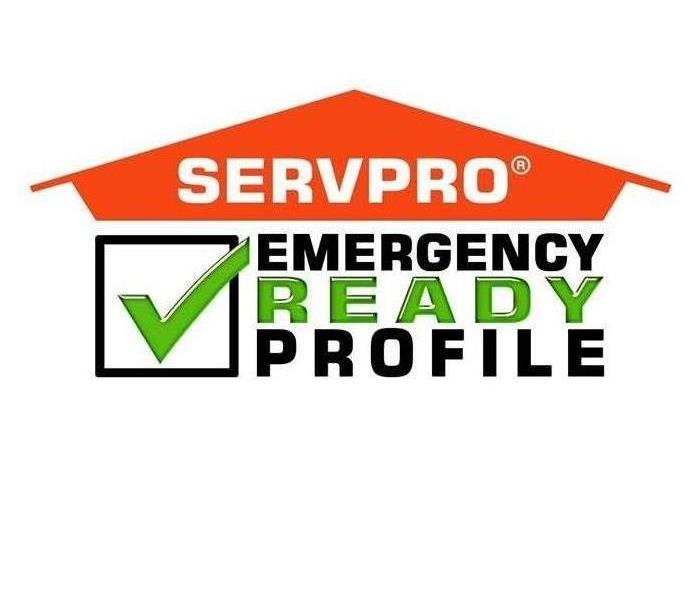 Create your ERP today!
Create your ERP today!
Fire Prevention
Having an emergency plan in case of a fire is important in order to protect your residence or business. The first 48 hours after a fire can make a difference in determining whether to restore, rather than to replace your property and personal processions. SERVPRO of Palo Alto believes in informing our customers the importance of fire prevention with some tips from the National Fire Protection Association.
- Do not leave your cooking unattended specially when frying, grilling or broiling food. The stove should be turn off if you must leave, even for a short period of time
- Portable heaters should be kept at least three feet away from anything that can burn.
- Inspect electrical cord and replace any that are cracked, damage or broken.
- Keep candles at least one foot from anything that can burn.
- Have an escape plan.
At SERVPRO of Palo Alto, we believe in the importance of being prepared, which is why we provide our customers with an Emergency Ready Profile. Our SERVPRO professionals can assist you in developing an ERP plan which contains crucial information needed in the event of an emergency occurring.
Contact SERVPRO of Palo Alto for more information on Fire prevention and restoration at 650-800-3448
Holiday Fire Safety tips
12/13/2016 (Permalink)
Easy Holiday Safety tips
It is that time of year again, everyone! During this time of the year, there are carolers singing, egg nog, bright lights, tasty food, chilly weather, and shopping for presents. With all these fun and festive things going on, it is easy to forget some of the easiest ways to prevent fire accidents. Surprisingly, statistics show that residential fires are more costly and property loss is 34% greater during the holidays rather than any other time of the year. As a gift from your local neighborhood SERVPRO, here are a few tips to make sure your holiday is the merriest and safest it can be.
Kitchen
- Keep a multi-grade fire extinguisher handy for a variety of fires.
- Check the smoke detectors for operable batteries.
- If you are going to deep fry your turkey, make sure it is on a flat surface and at least 10 feet away outside from your home.
- If you are multitasking while you are cooking, make sure you have a cooking utensil in hand to remind you that something is on the stove.
Candles
- Maintain at least a foot between the candle and anything flammable in all directions.
- Before going to bed, make sure all candles are put out and never leave a flame unattended. However, if you prefer a low light setting, rather than use candles, switch to LED powered candles.
Christmas trees
- Try to purchase a fresh cut tree with one that has all of its pine needles intact.
- Purchase a tree base that has room for you to water your tree every day.
- Watered trees will last longer and will typically dry out after 4 weeks.
- Remember to take your tree out as soon as possible after the holidays to prevent unwanted accidents. Dry trees are the easiest to catch on fire.
Decorative Lights
- Inspect light strings for cracks and/or fraying.
- Inspect light sockets for broken and exposed filaments.
- Do not run three strings from end to end, but instead, stack them because it is safer.
- Do not use nails or staples to hang your lights. Instead, use UL-Rated clips and hangers.
- Take lights down after the holidays to prevent squirrels from chewing on your cables and environmental damage.
The Fireplace
- Have your chimney inspected for collected soot that hardens after every use of your fireplace. If it needs to be cleaned, do so before you use it.
- Do not start a fire for your fireplace with wrapping paper or liquids; only use seasonal firewood.
- Set a screen in front of your fireplace to prevent the embers from your cozy fire does not damage or spark a fire to your items such as a rug or other flammables.
- Set extinguished embers in a metal container outside for at least 24 hours before throwing away.
If you have any questions, concerns, you may contact us at 1 (650) 800-3448.
Most importantly, we are available for emergency services of any accidents or inconvenient mishaps 24/7.
From our family here at SERVPRO of Palo Alto to yours, we wish you a safe happy holidays!
Summer is Almost Here, as Fire Season is also Approaching Palo Alto, Menlo Park, Portola Valley
9/23/2015 (Permalink)
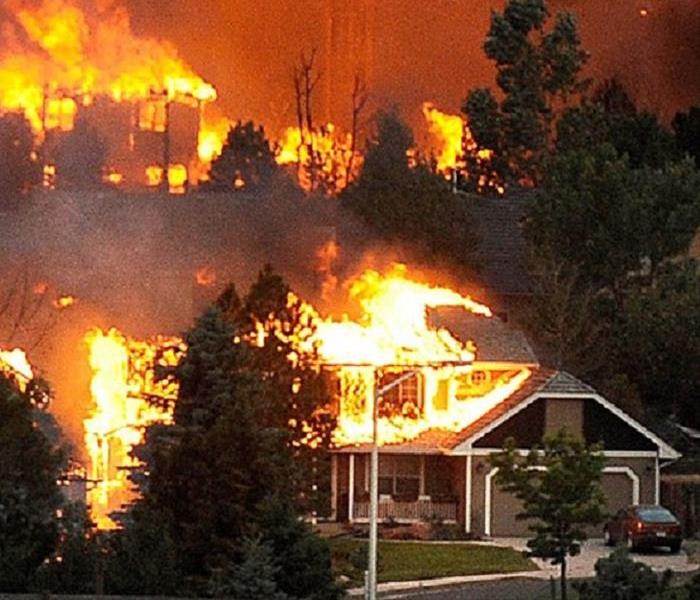 Credit: qctimes.com
Credit: qctimes.com
As Californians, we know the real threat of wildfires. California residents need to be more aware than ever on how best to protect their homes from wildfires.
According to FEMA here are some top ways to protect your property in Palo Alto, Menlo Park, Atherton, Portola Valley and other bay area cities:
Have you thinned out and maintained the vegetation around the house? All vegetation is fuel for a wildfire-therefore the greater the distance between your home and the vegetation, the greater the protection. Create a 30-foot safety zone around the house if possible. At a minimum, create a defensible space of (0-5ft): use noncombustible materials, such as gravel, brick, or concrete in this critical area adjacent to your home. Remove vines from the walls of the house, prune branches and shrubs within 15 ft of chimneys.
Create a second zone of 100 feet reducing or replacing as much of the most flammable vegetation as possible.If you live on a hill, you may need to extend the zone for several hundred feet.
Are combustibe materials away from the house? Identify all combustible materials outside the house, stack firewood 100ft away and uphill from the house. Keep the gas grill and propane tank at least 15 ft from the house and place a mesh screen over the grill.
Is the roof made of non combustible materials? Materials that are fire resistant include single ply membranes, fiberglass shingles, slate, metal, clay and concrete tile. Clean debris from roof since debris can be ignited by wind-blown embers.
Are sundecks and porches enclosed underneath? Are eaves and overhangs enclosed? Clear leaves, trash and other fire hazards away from decks and porches, extend 1/2 inch mesh screen from all overhands down to the ground. Enclose all eaves to reduce the hazard.
Clean out gutters regularly: keep debris ouf of gutters since debris can be ignited by wind-blown embers. If used, gutter covers should be non-combustible.
Are house vents covered with wire mesh? Any attic vent, soffit vent, or other opening can allow embers and flaming debris to enter a home and ignite it. Cover all openings with an 1/4 inch or smaller corrosion-resistant wire mesh. Are chimneys and stovepipes covered with spark arrestors? Use 12-gauge spark arrestors or woven wire mesh to prevent this hazard.
Is the house siding fire resistant? Stucco, metal, brick and cement, concrete and rock are all fire resistant and should be used. You can treate wood siding with UL-approved fire retardant chemicals but these treatments are not permanent.
Have windows been treated to reduce the risk? Dual or triple-paned thermal glass and fire resistant shutters or drapes, help reduce wildfire risk. Tempered glass windos and noncombustible awnings can also help reduce your risk.
Northern California Wildfires Rage--Leaving a Path of Destruction and Pain
9/15/2015 (Permalink)
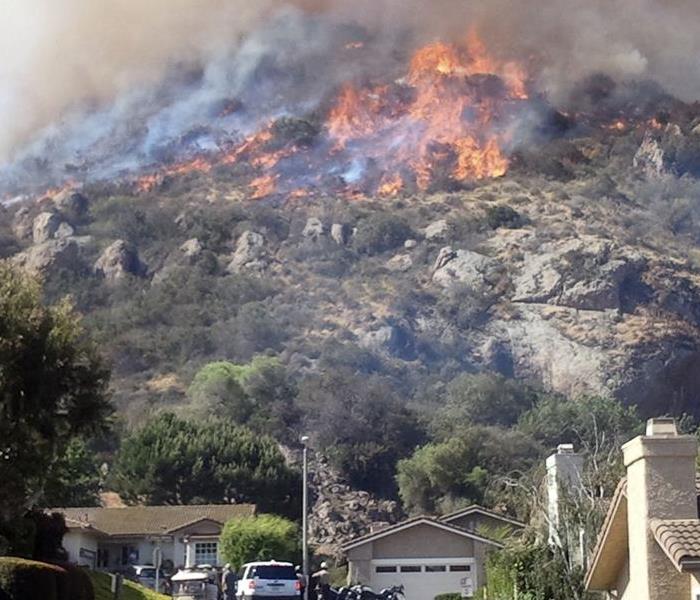 Fires raging in California. Photo credit: Together.com.
Fires raging in California. Photo credit: Together.com.
As the fires in Lake County, Valley, Napa and Butte are ravaging thousands of acres and burning hundreds of homes and buildings to the ground. Neighboring homes are still being threatened and facing severe smoke, soot and property damage. The drought-stricken conditions and dry brush are making conditions for fire fighters impossible. The outlook looks harsh, according to California's emergency services director, "...we don't see an end in the fire season."
Many homeowners in this devastated aftermath don't know what to do, where to begin and how to rebuild or recuperate from such a loss. Many will be displaced for months while their homes are being completely rebuilt and some will be facing partial reconstruction and major cleanup.
First thing you should do after such a loss is speak to your insurance company. Clarify your policy and hopefully your loss will be covered. One thing to think about while writing up a policy and prior to a natural disaster, is documenting your contents before such a loss can ravage your home. Taking pictures of your furniture, electronics, major belongings and creating lists of your valuables can literally save you when you are trying to recoup your losses and make an insurance claim of what has been damaged or burnt.
If you are one of the lucky ones where the fire didn't completely consume your home, your insurance company will suggest calling a professional fire cleanup and restoration company, such as SERVPRO. For homeowners in Palo Alto, we will help you throughout the entire process. We will work closely with you and your insurance claims representatives to clean up your home and contents, salvage what is salvageable, and inventory what is a total loss. We will remove the heavy smoke odor from your property and belongings and coordinate dry cleaners and other relevant contractors who can help repair your home. We will treat you and your property with great care and respect throughout the process. Our fire services include:
Inspection and Fire Damage Assessment
Immediate Board-Up and Roof Tarp Service (if needed)
Water Removal and Drying (if water damage is present)
Removal of Smoke and Soot from All Surfaces
Cleaning and Repair
Restoration
Locally Owned Company with National Resources
SERVPRO of Palo Alto can respond immediately to your water, or fire damage emergency regardless of the scope or size of the damage. We are part of a national network of over 1,600 Franchises with special Disaster Recovery Teams placed strategically throughout the country to respond to large scale events and disasters.
Whether your water/fire emergency occurs in a big-box store or a small office building, we will respond quickly to mitigate the damage and manage the restoration project through to its completion.



 24/7 Emergency Service
24/7 Emergency Service

